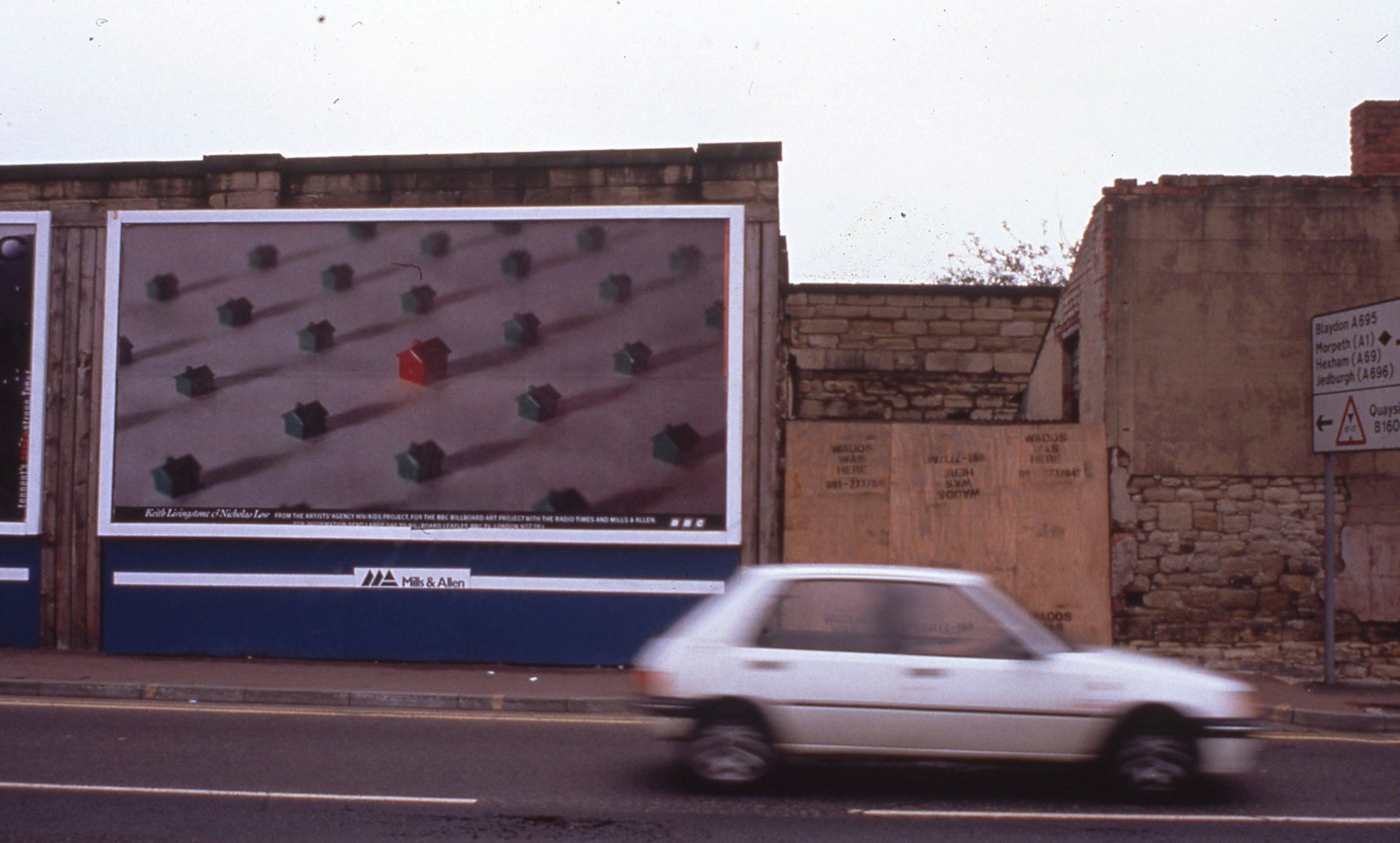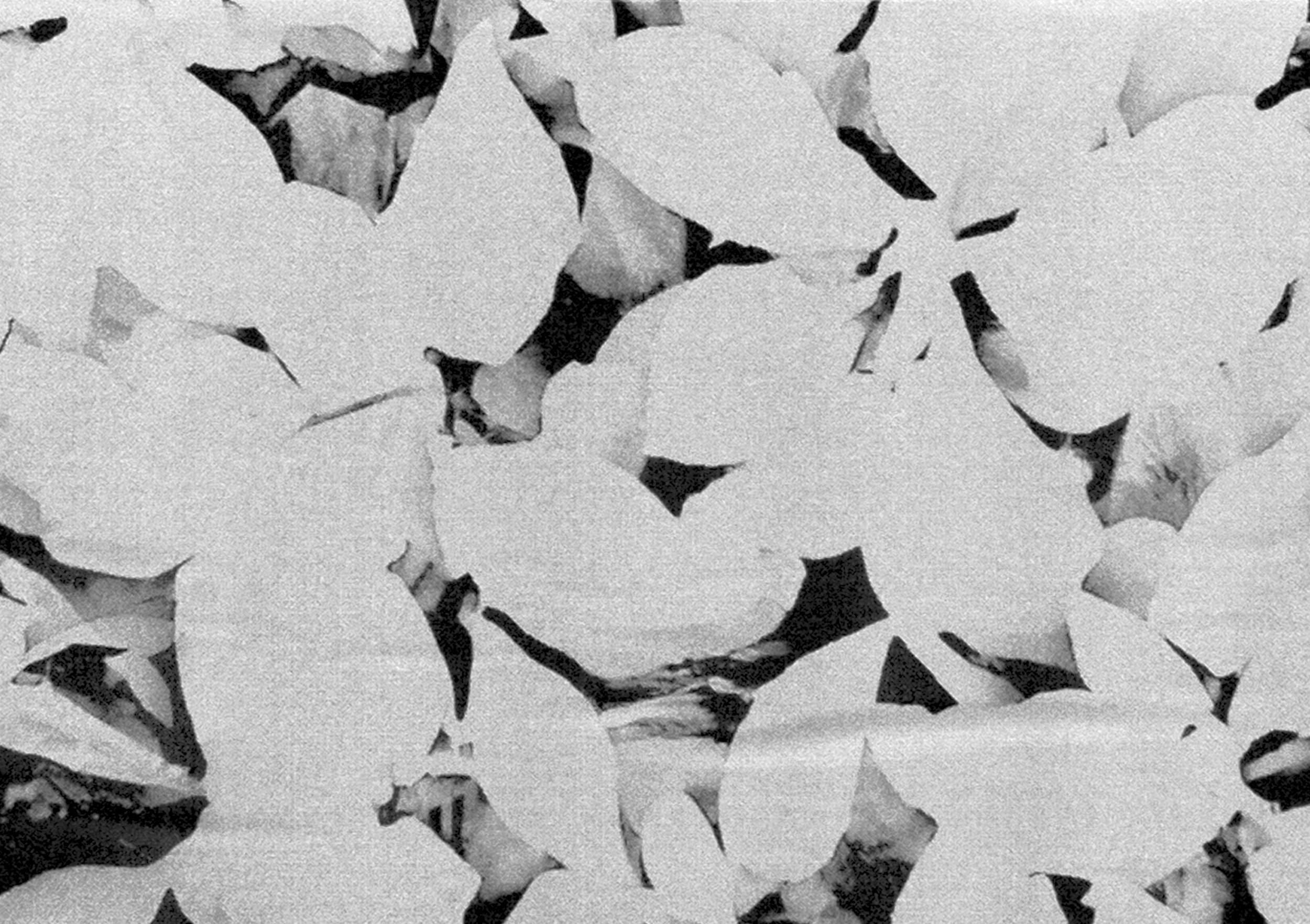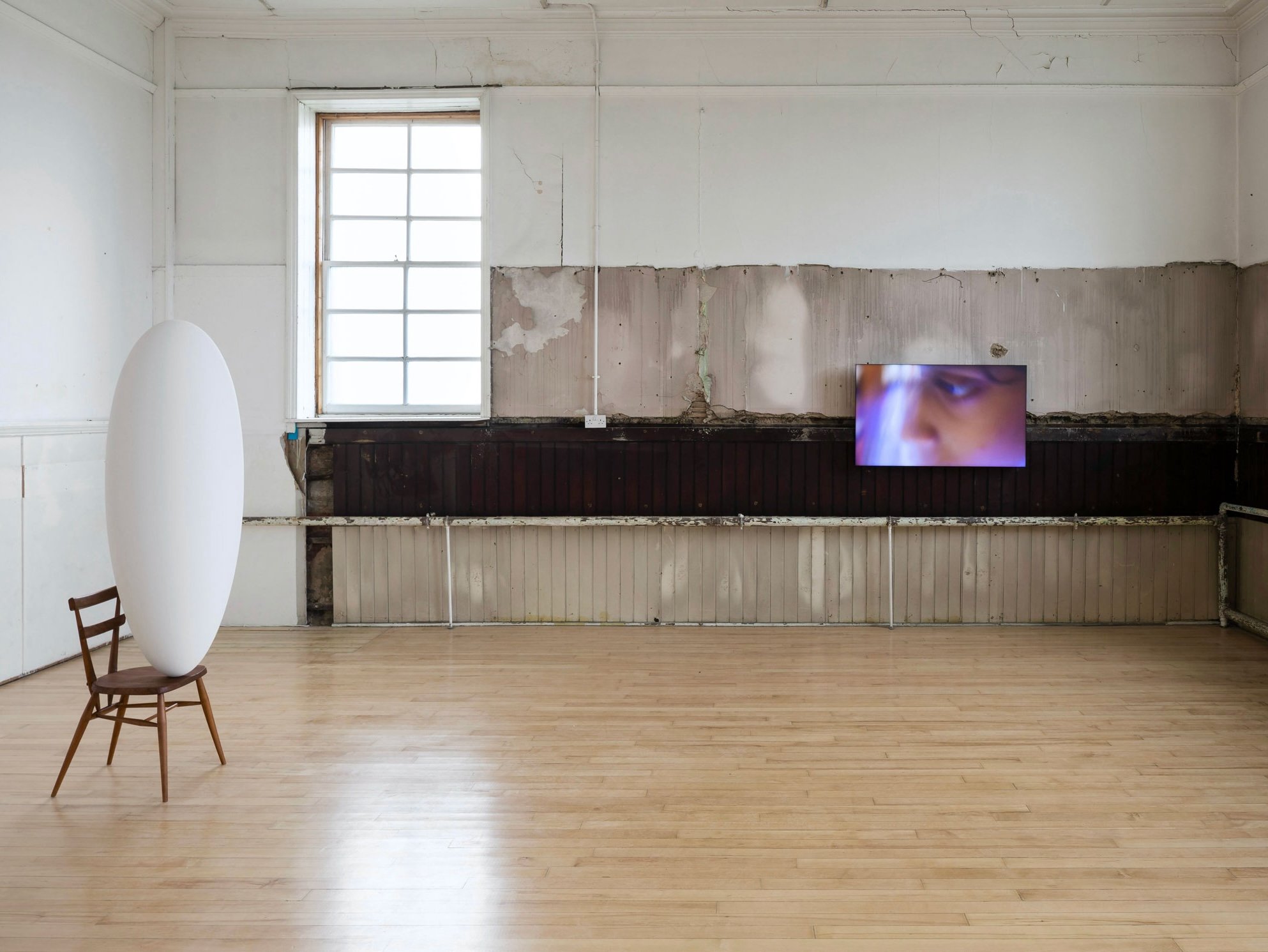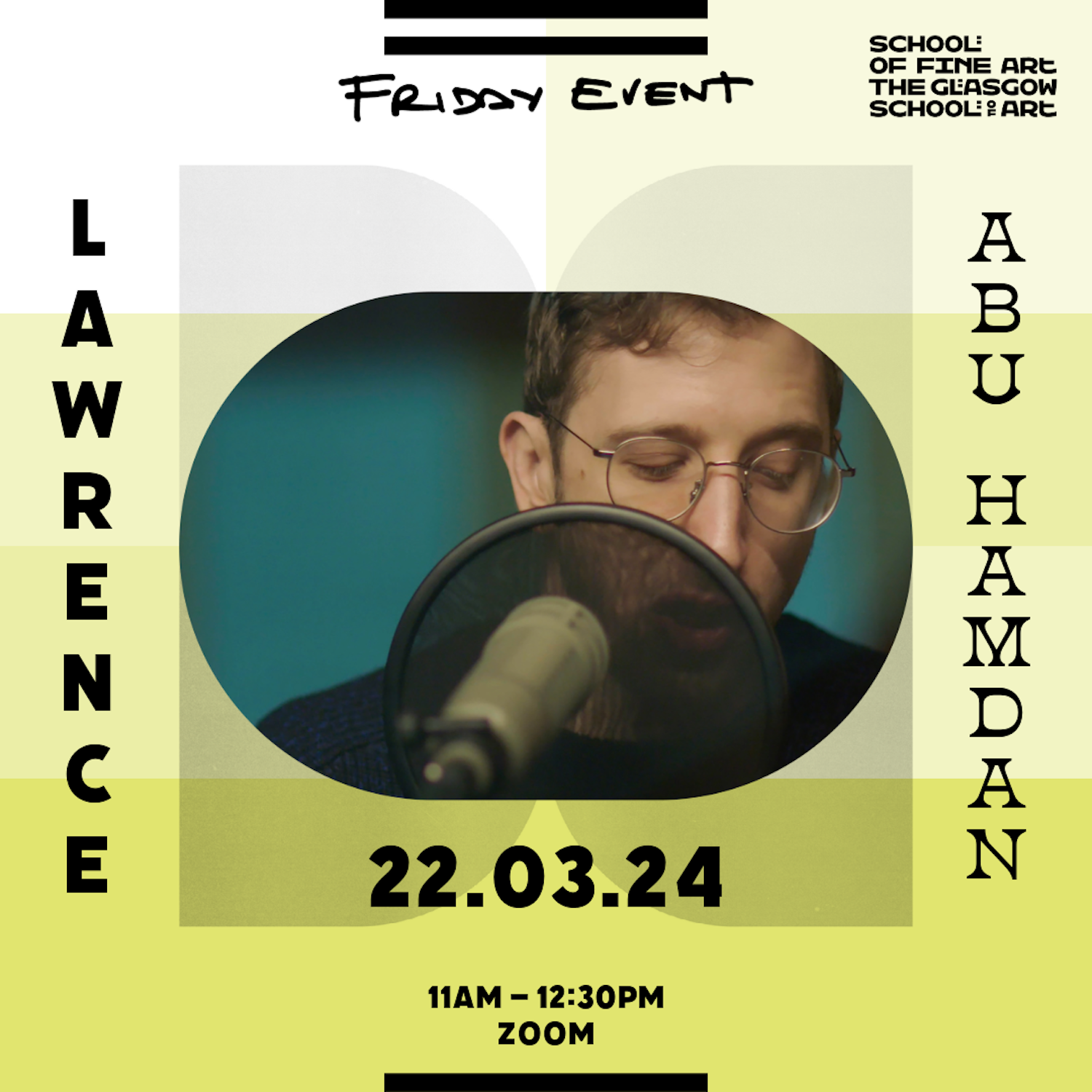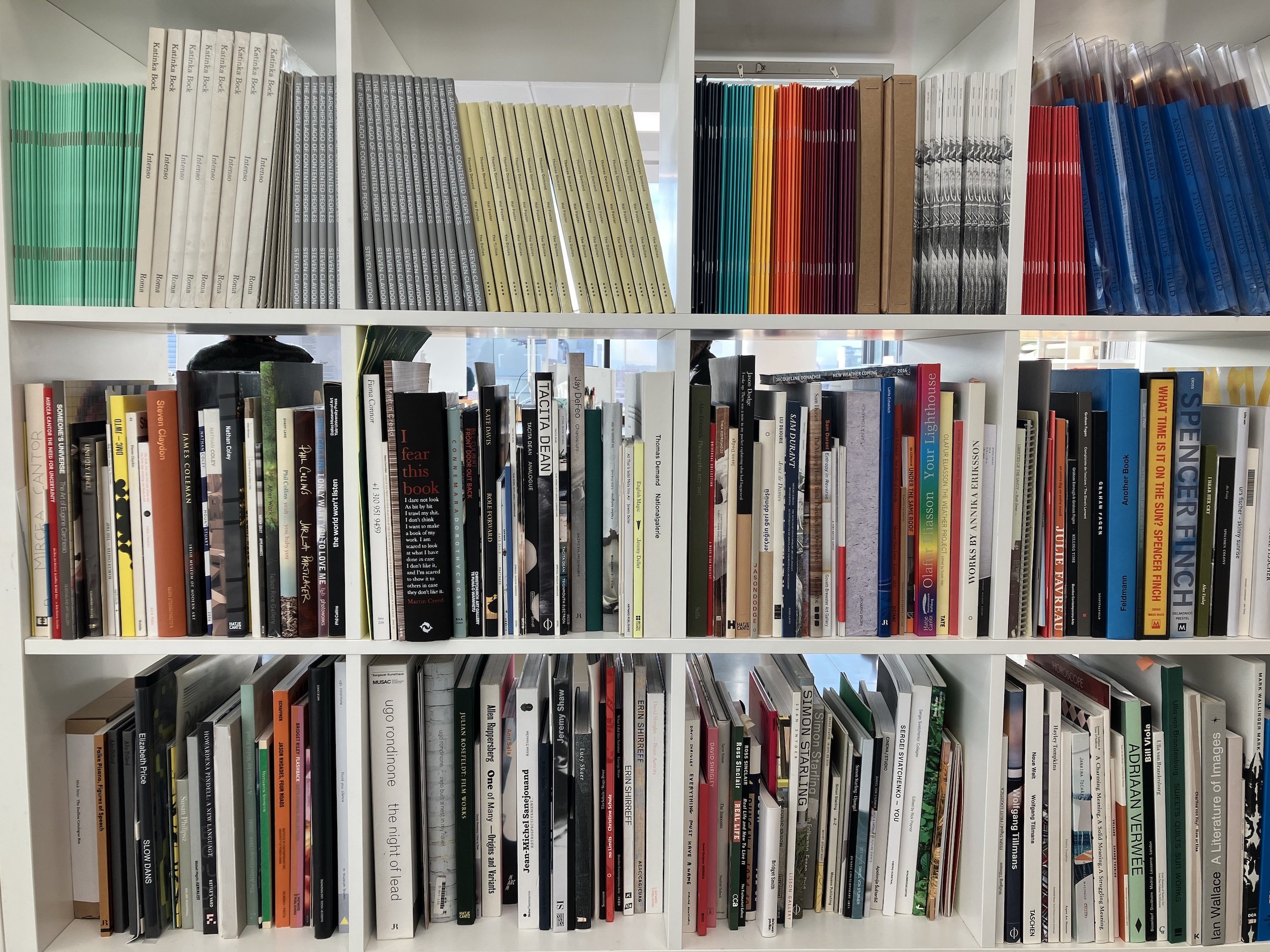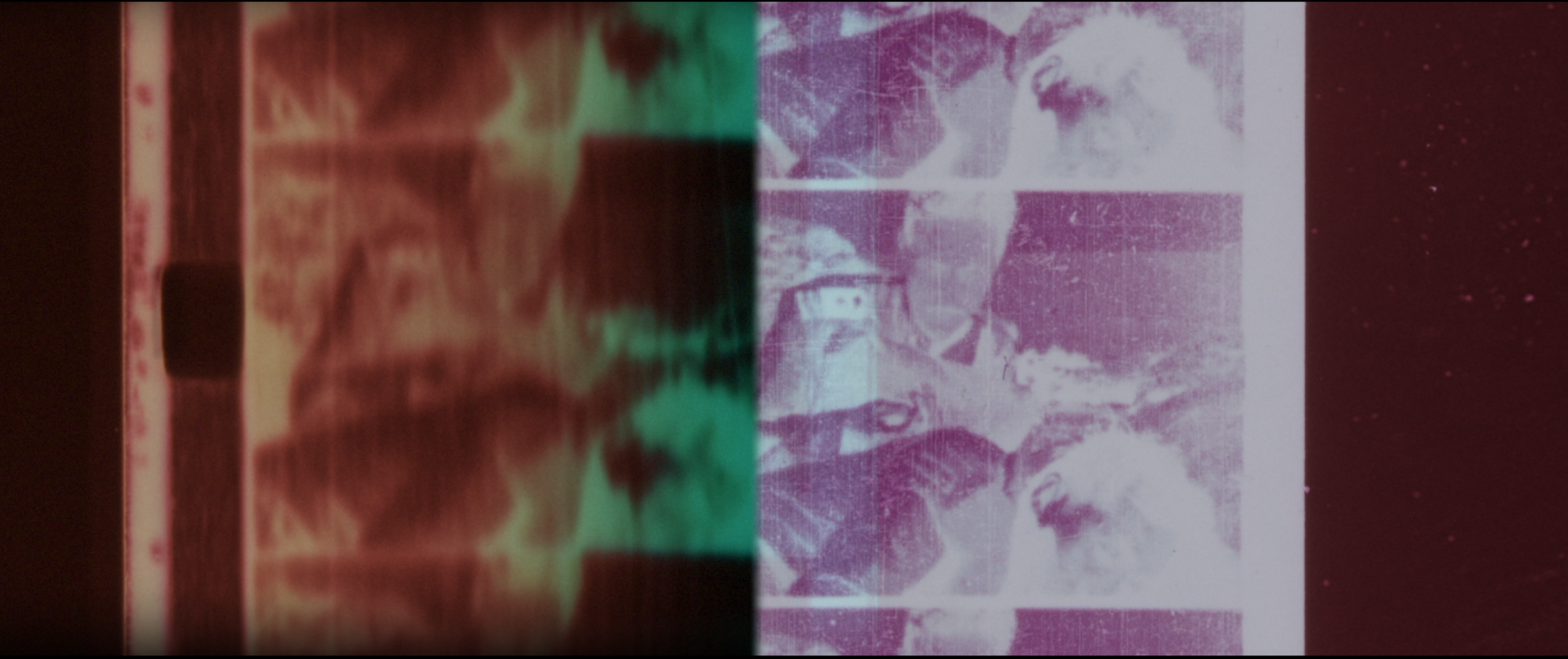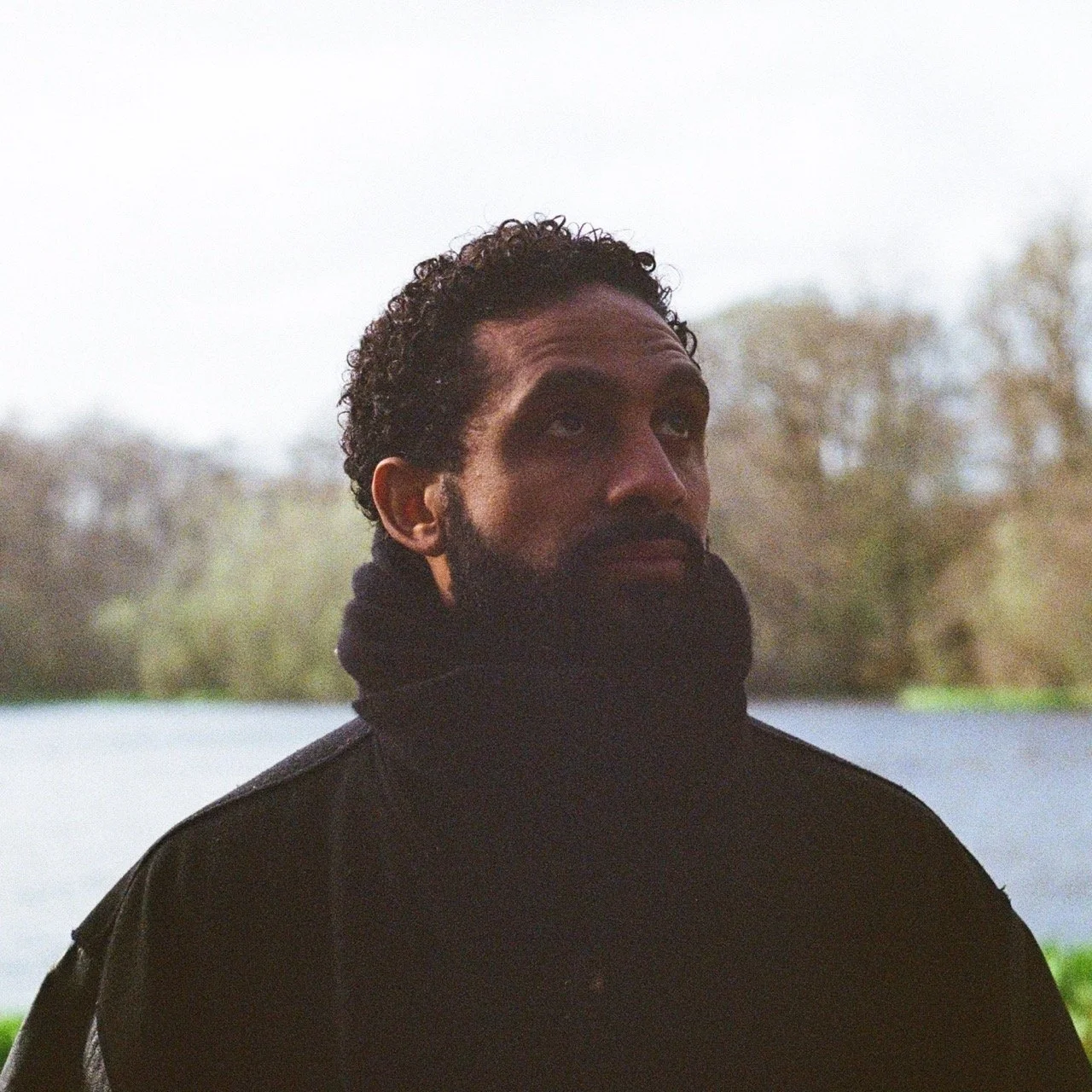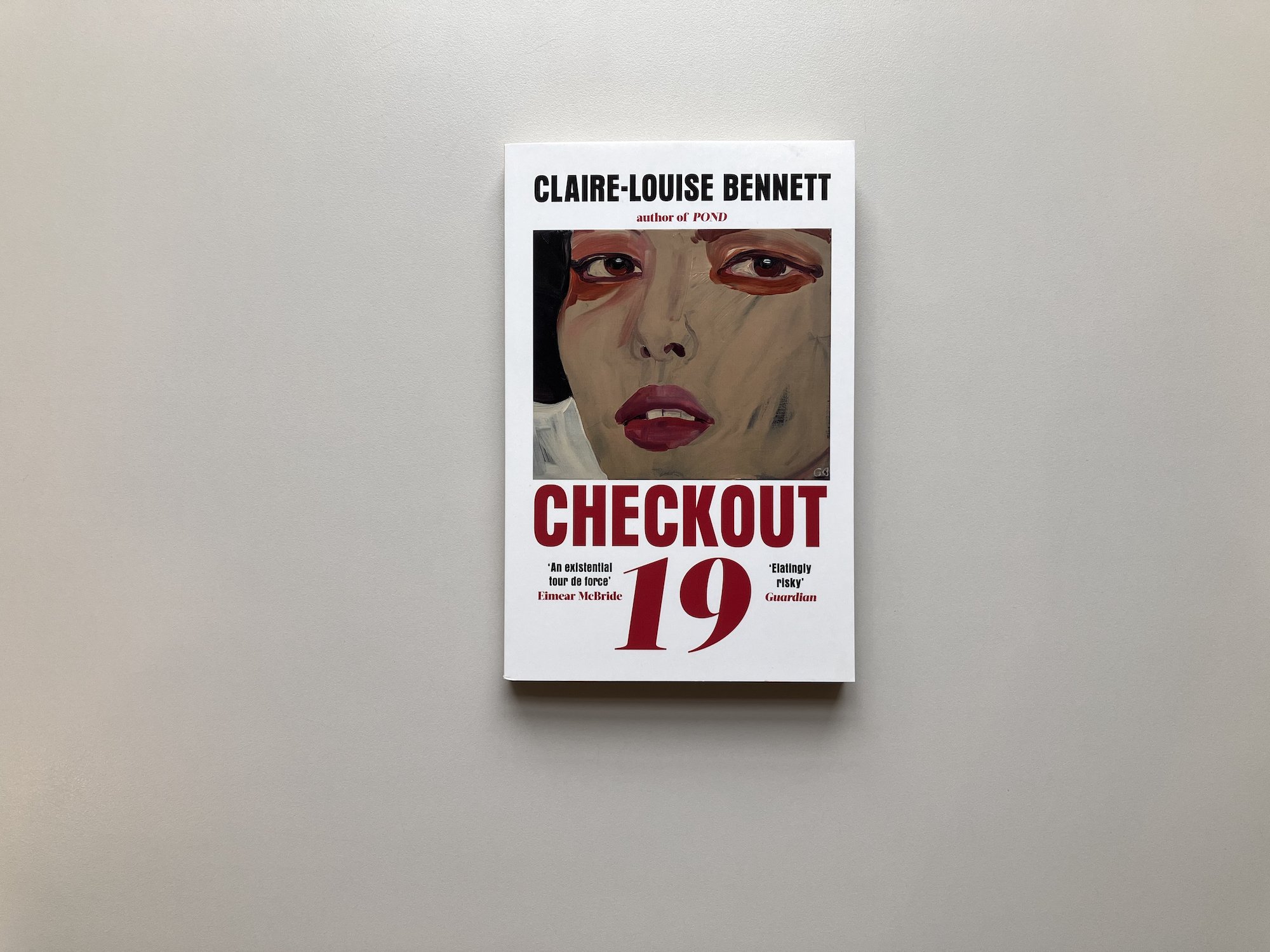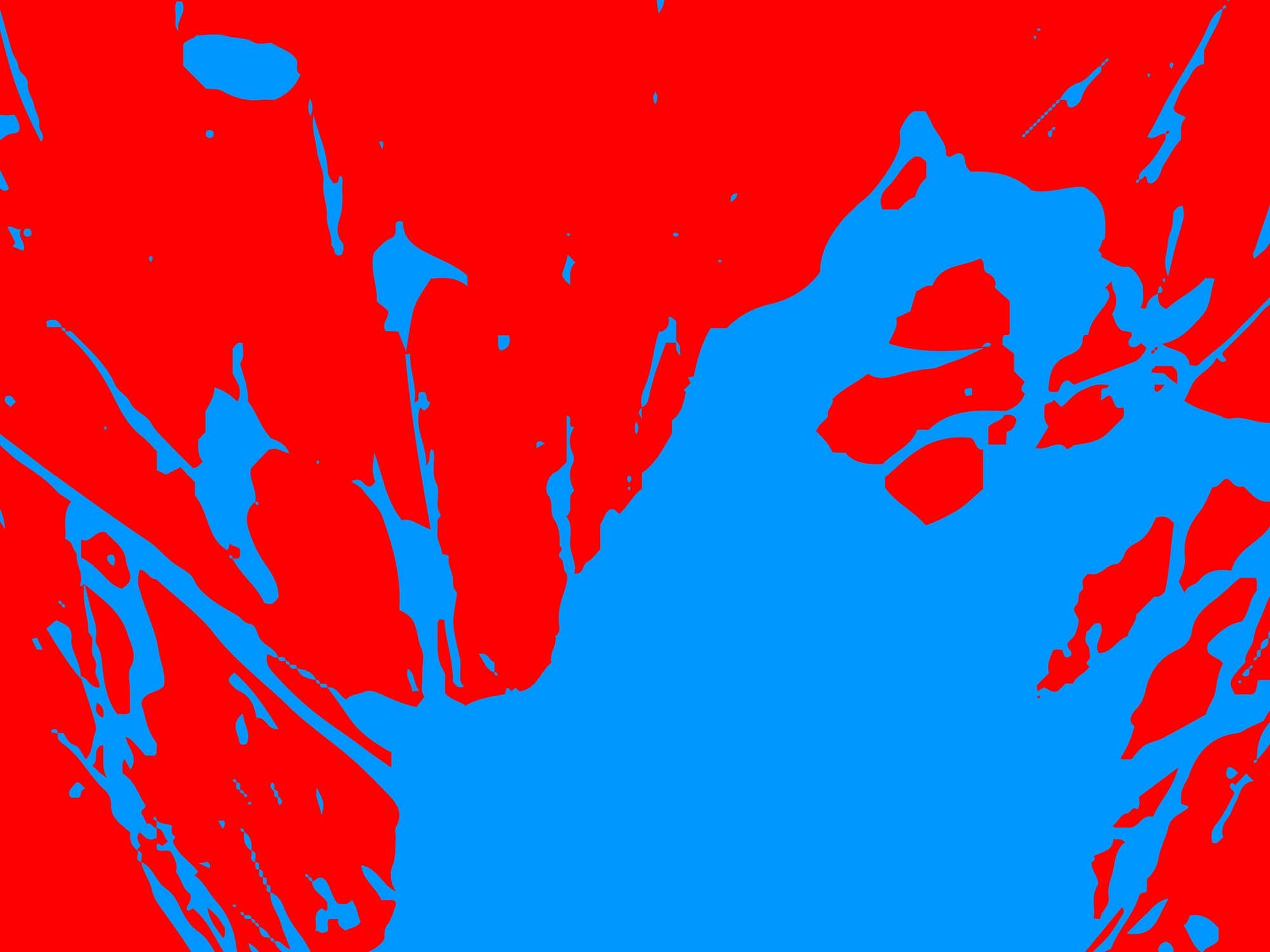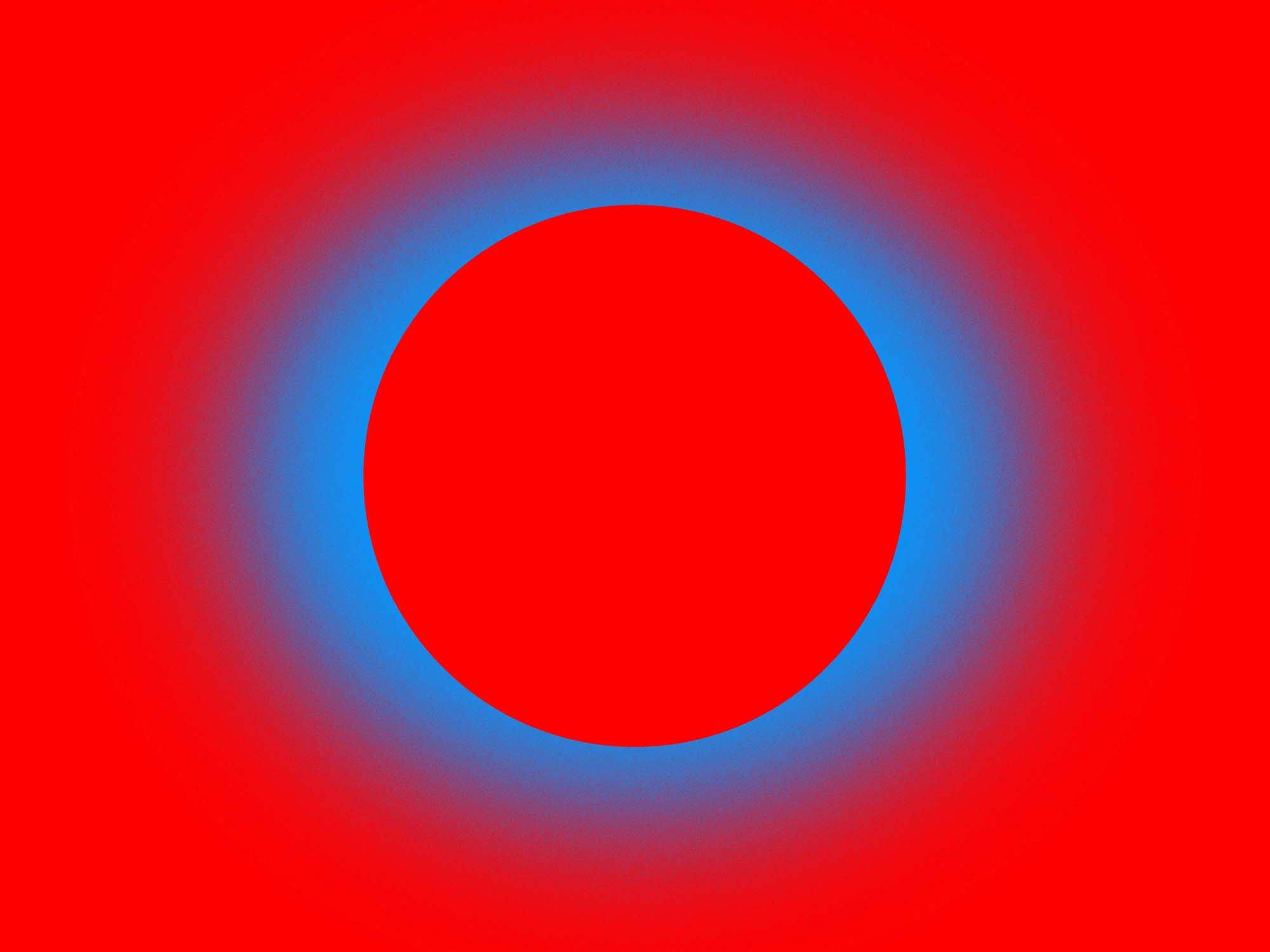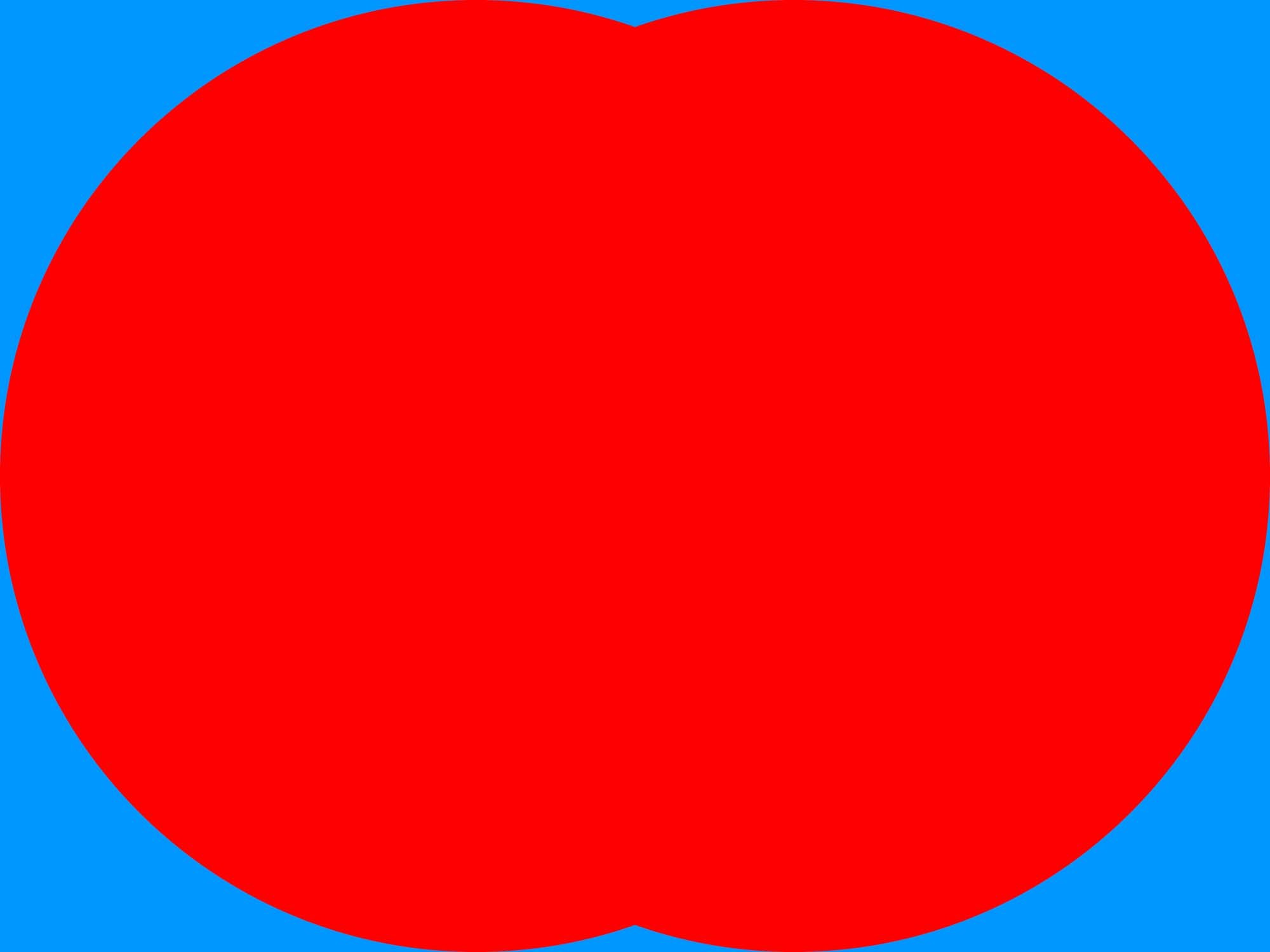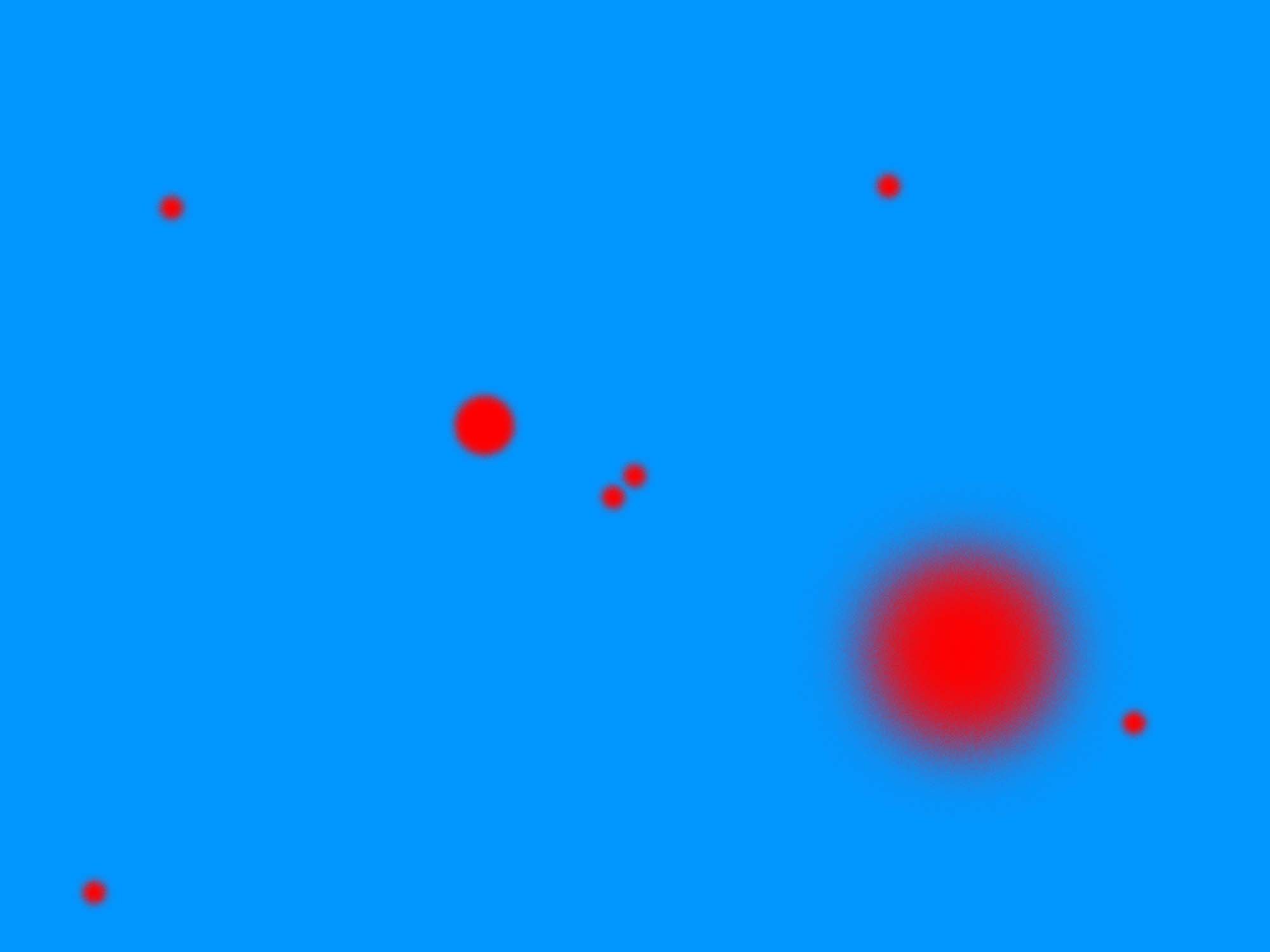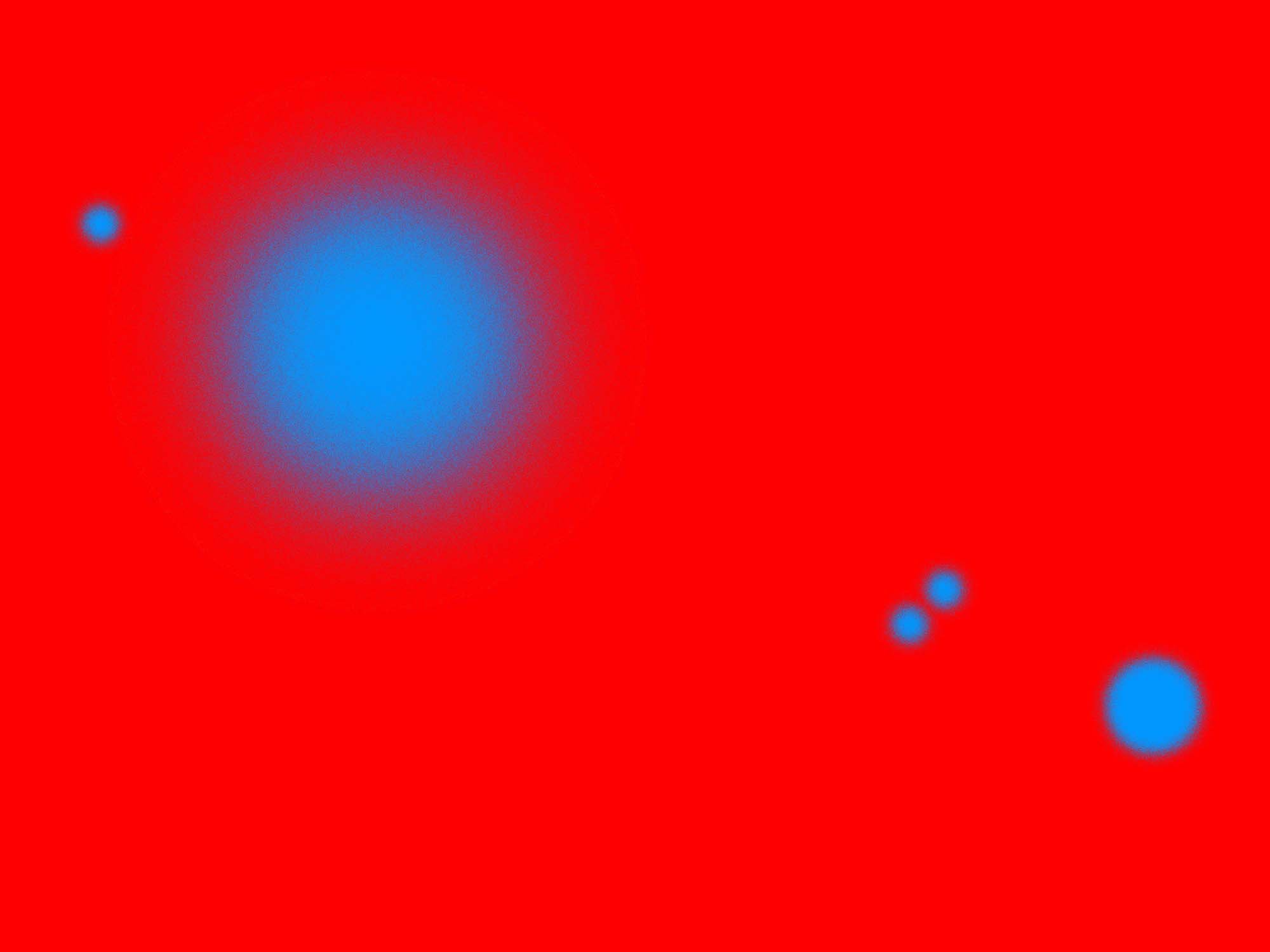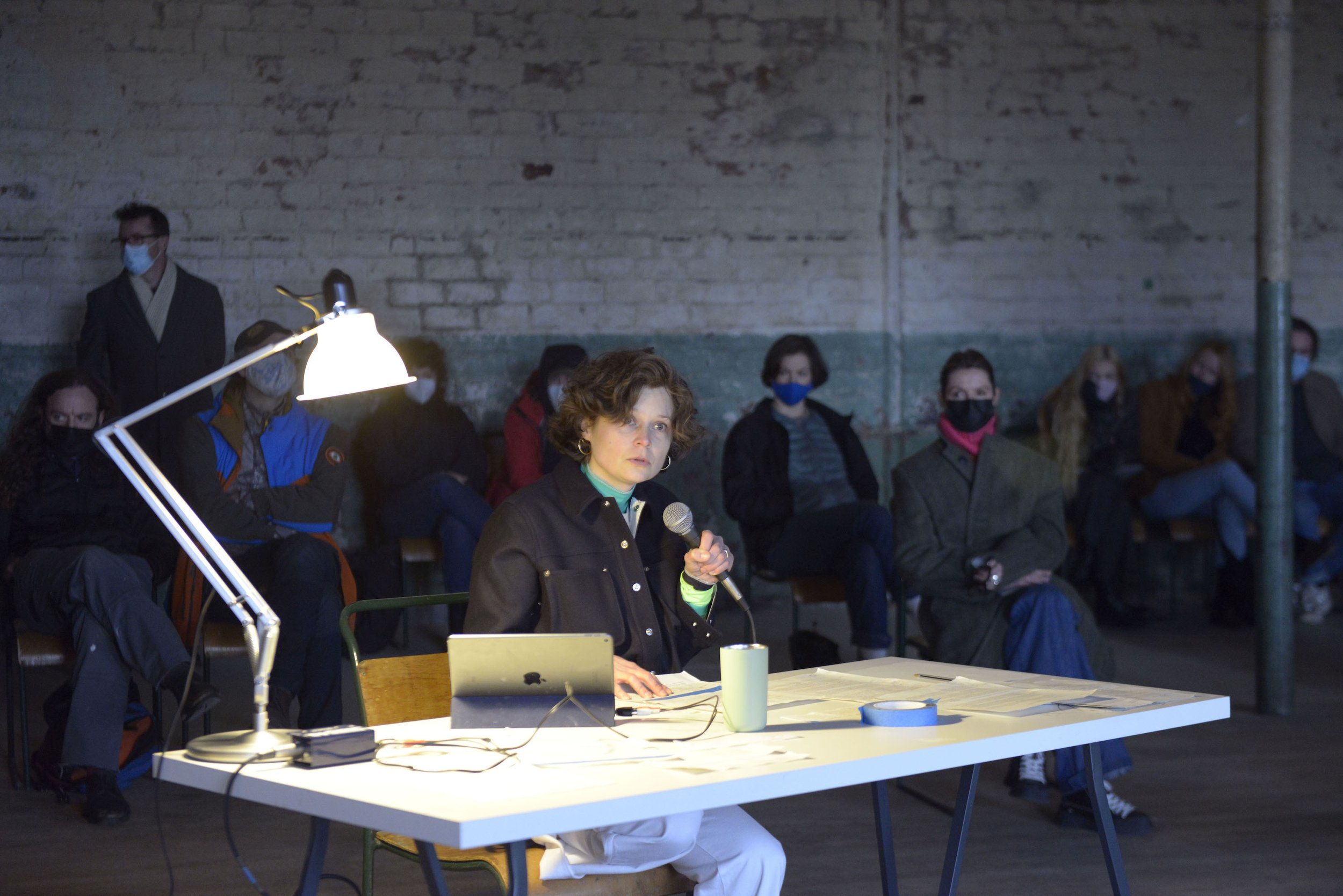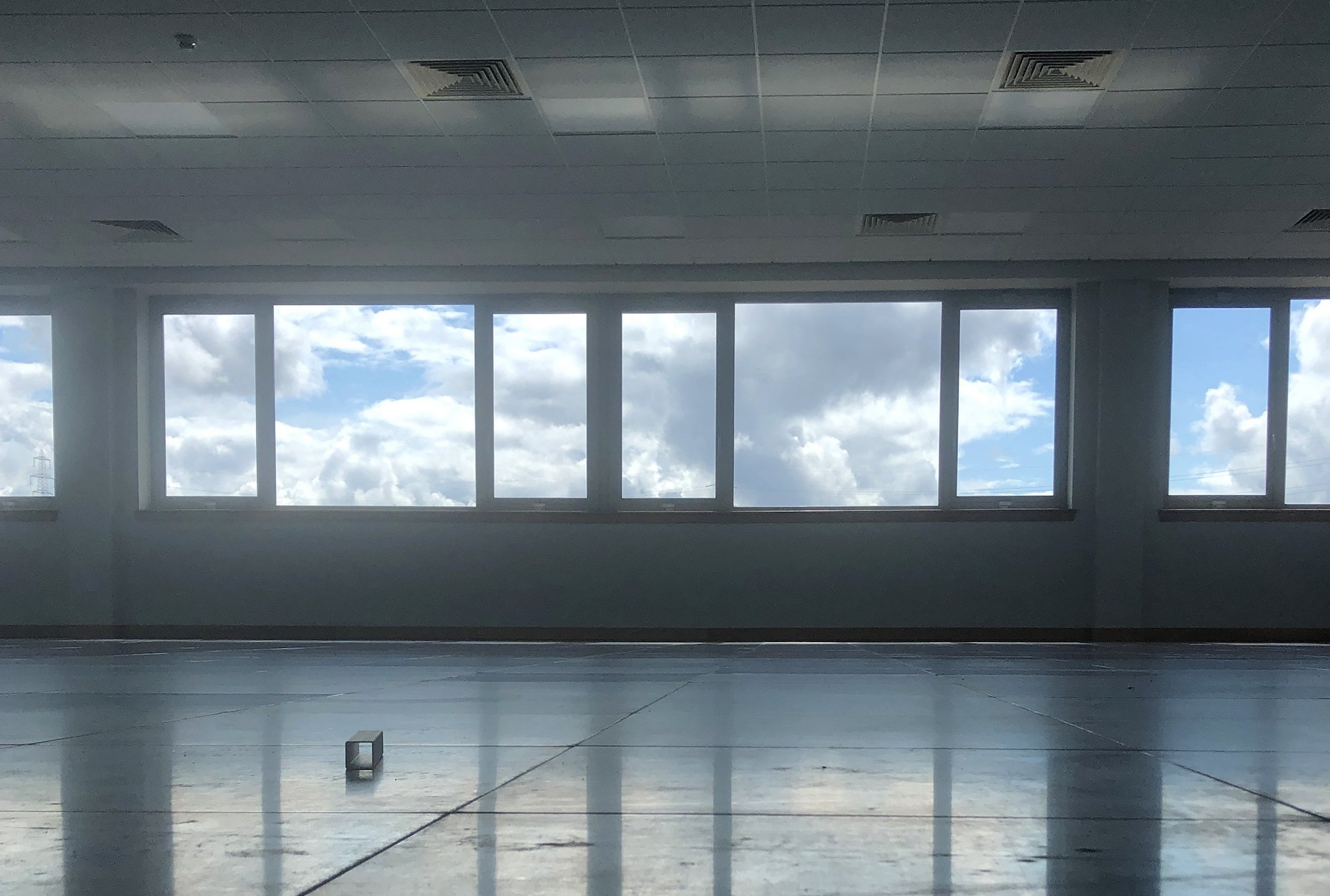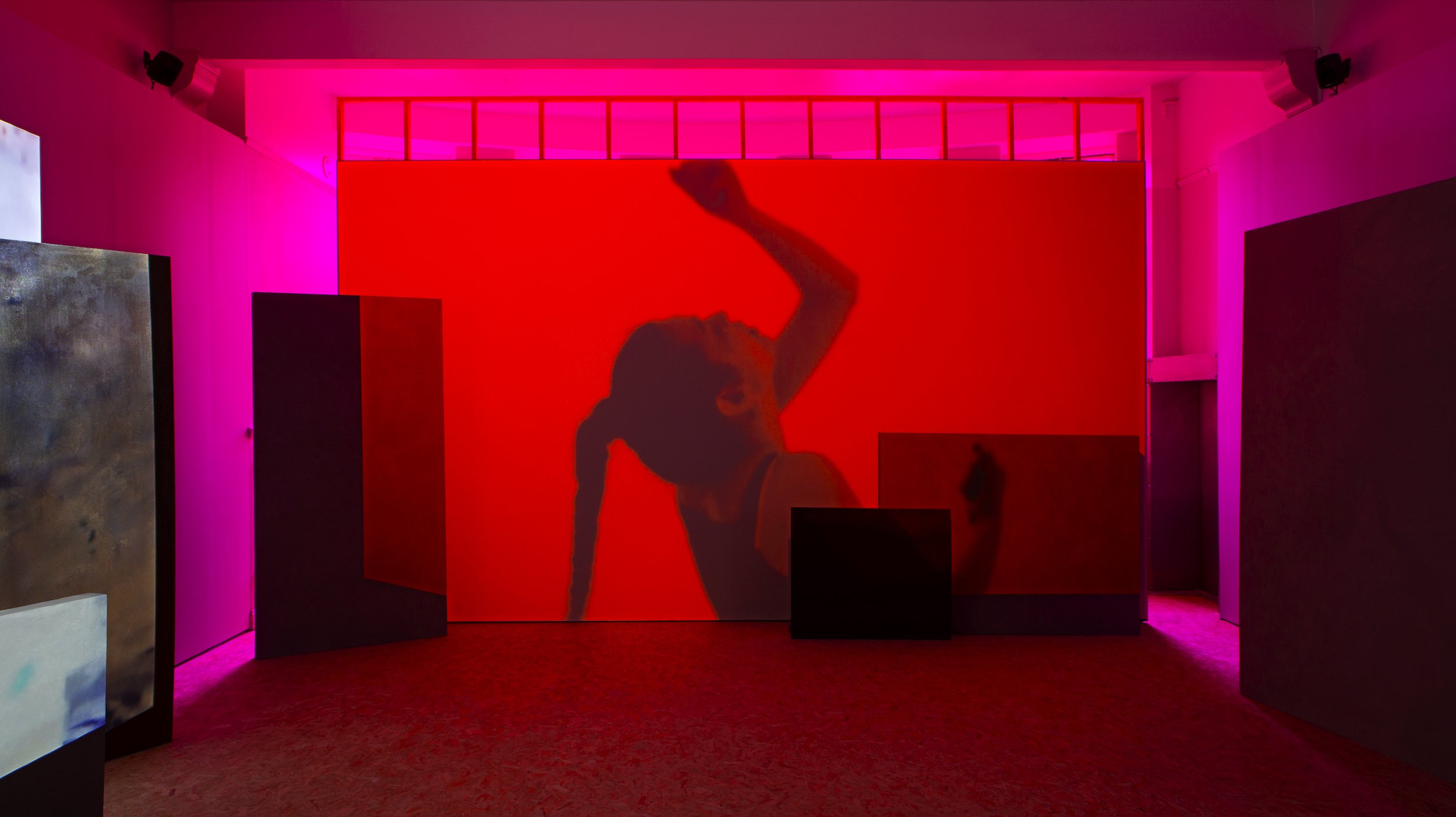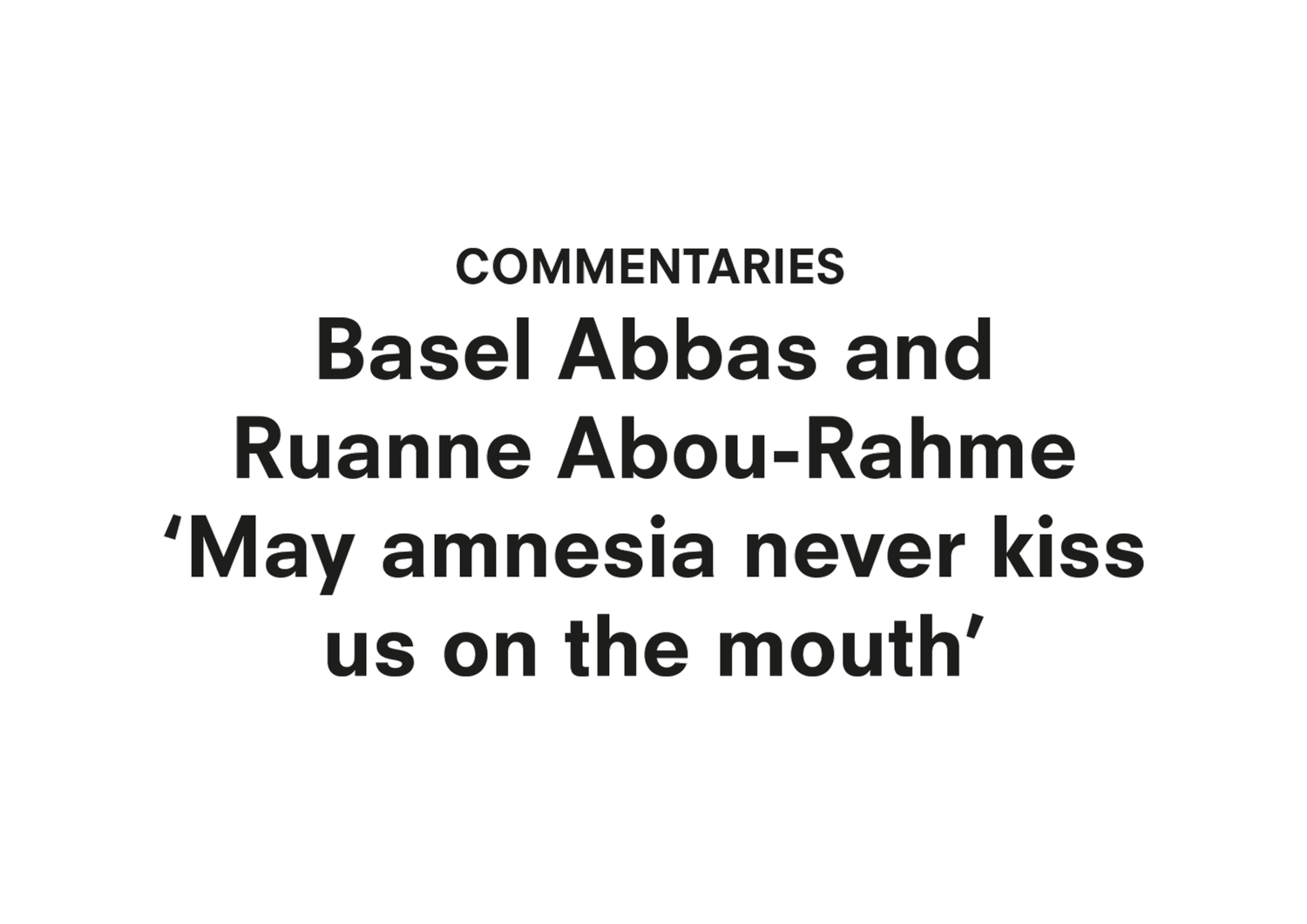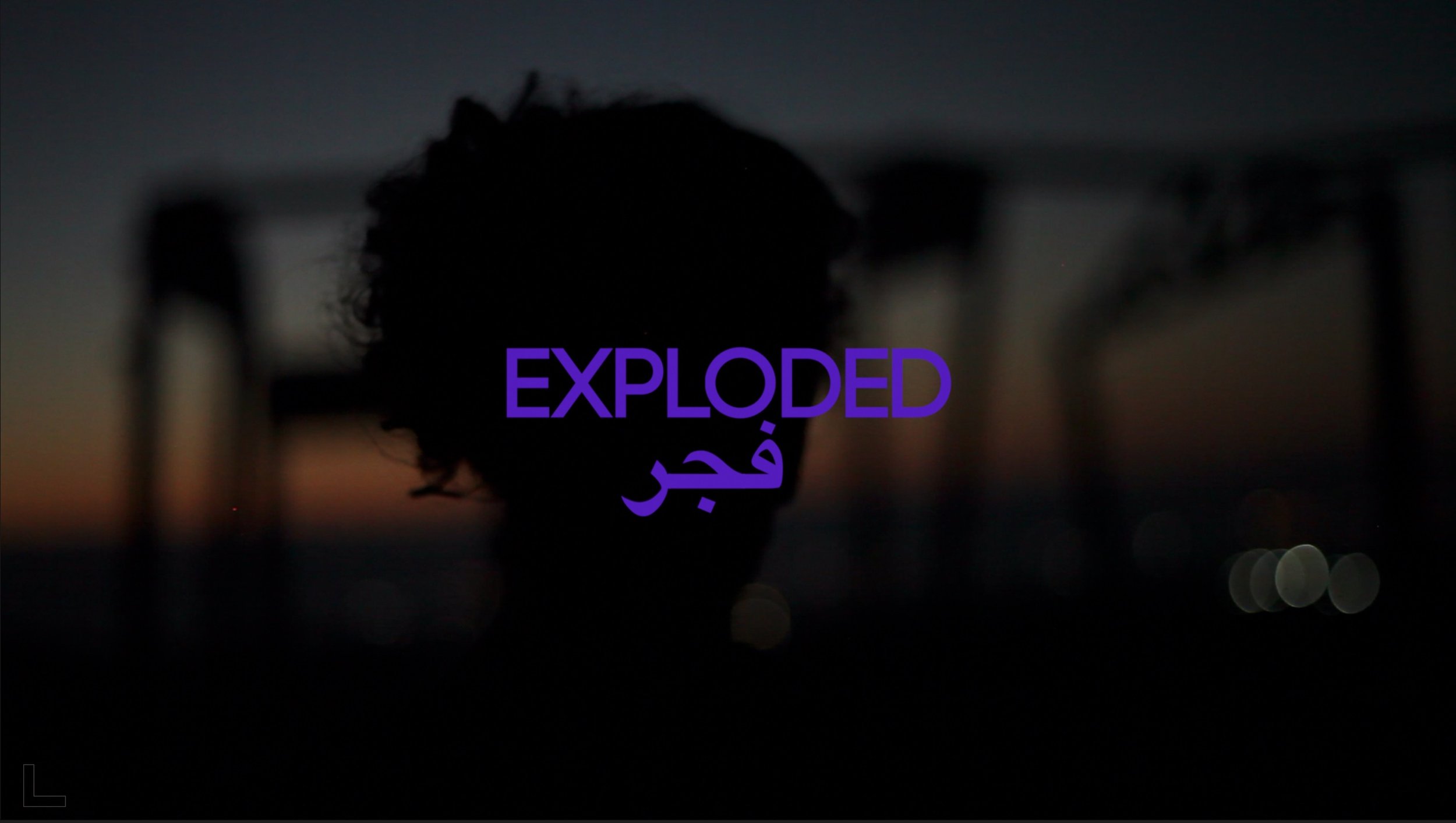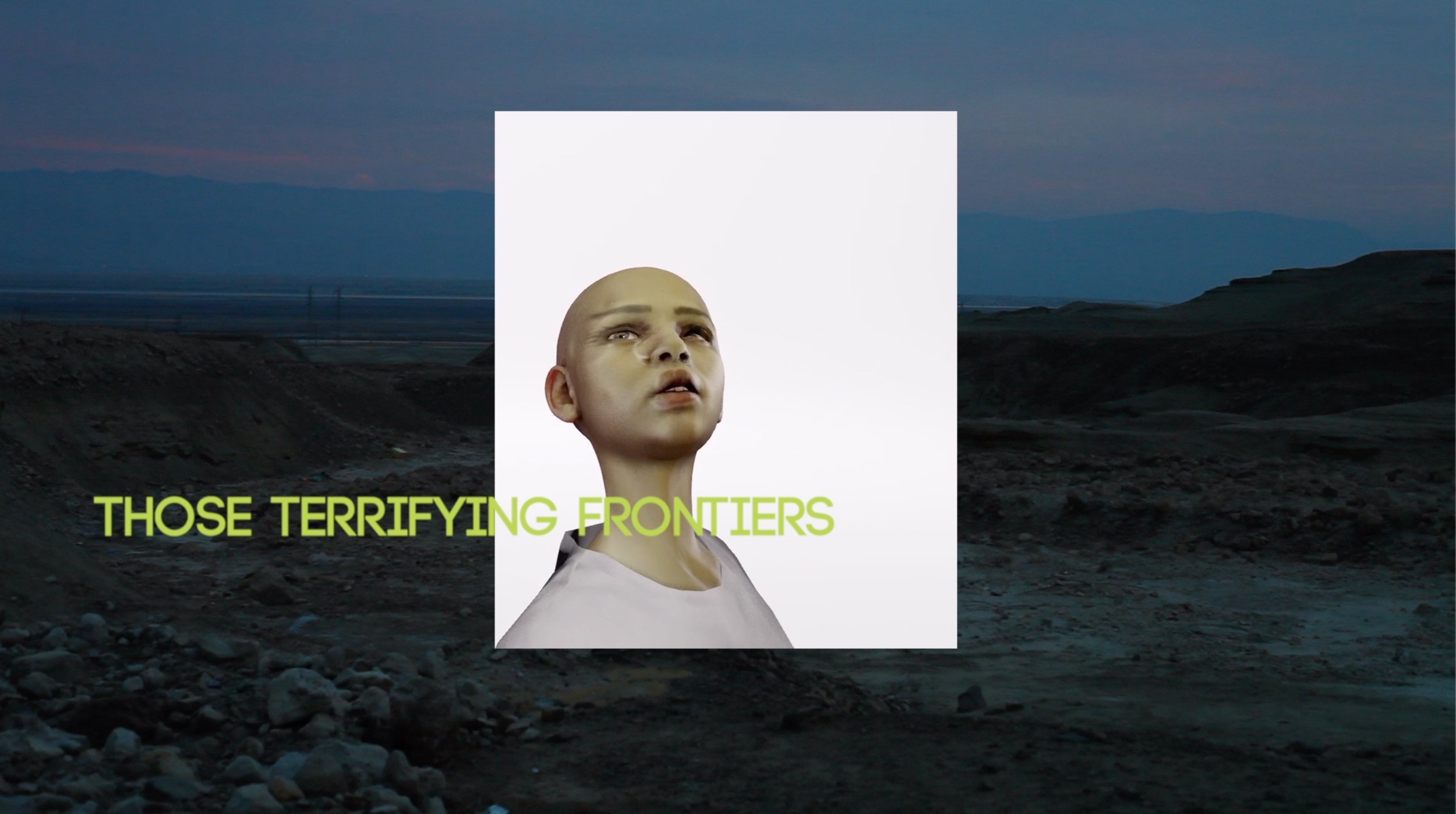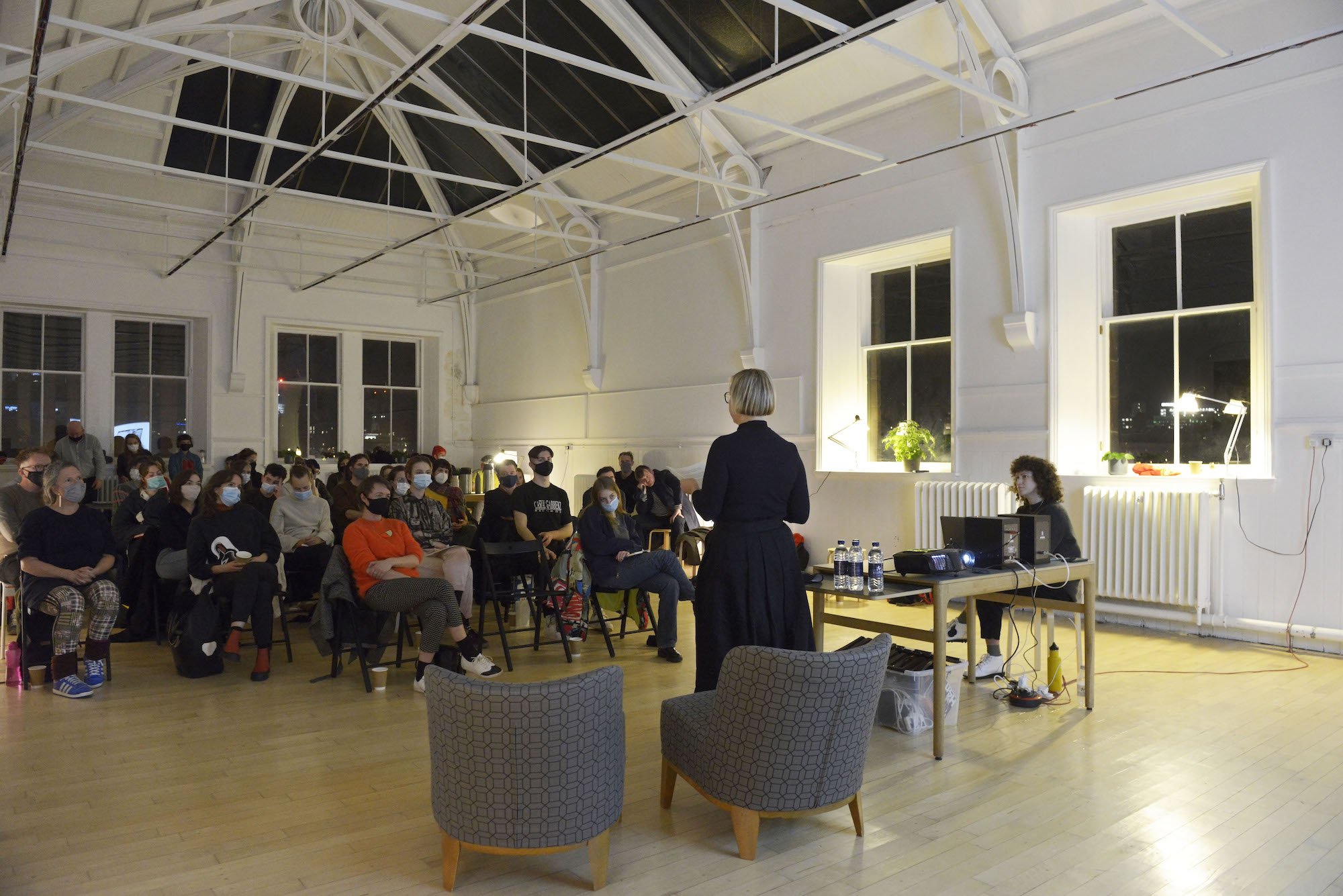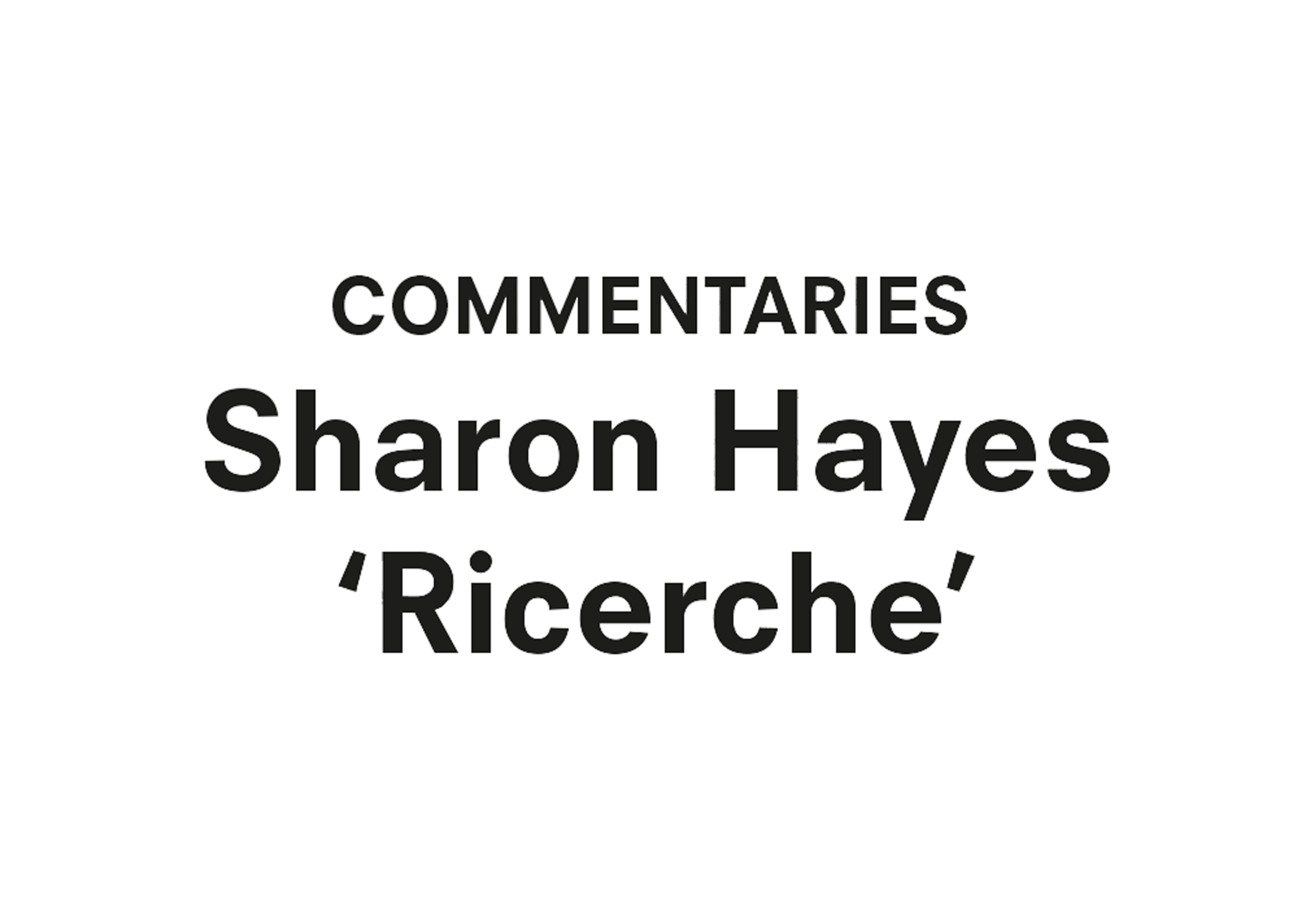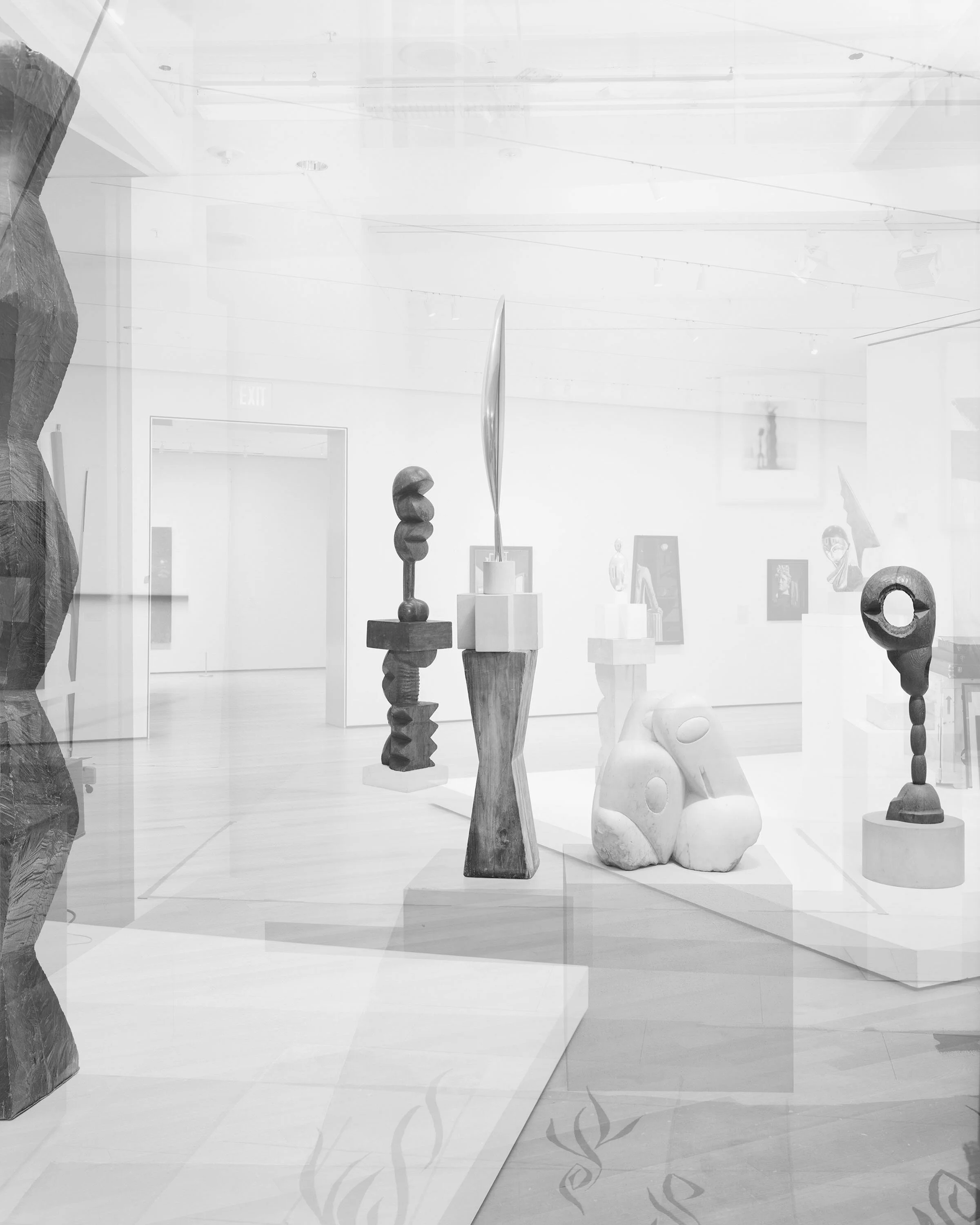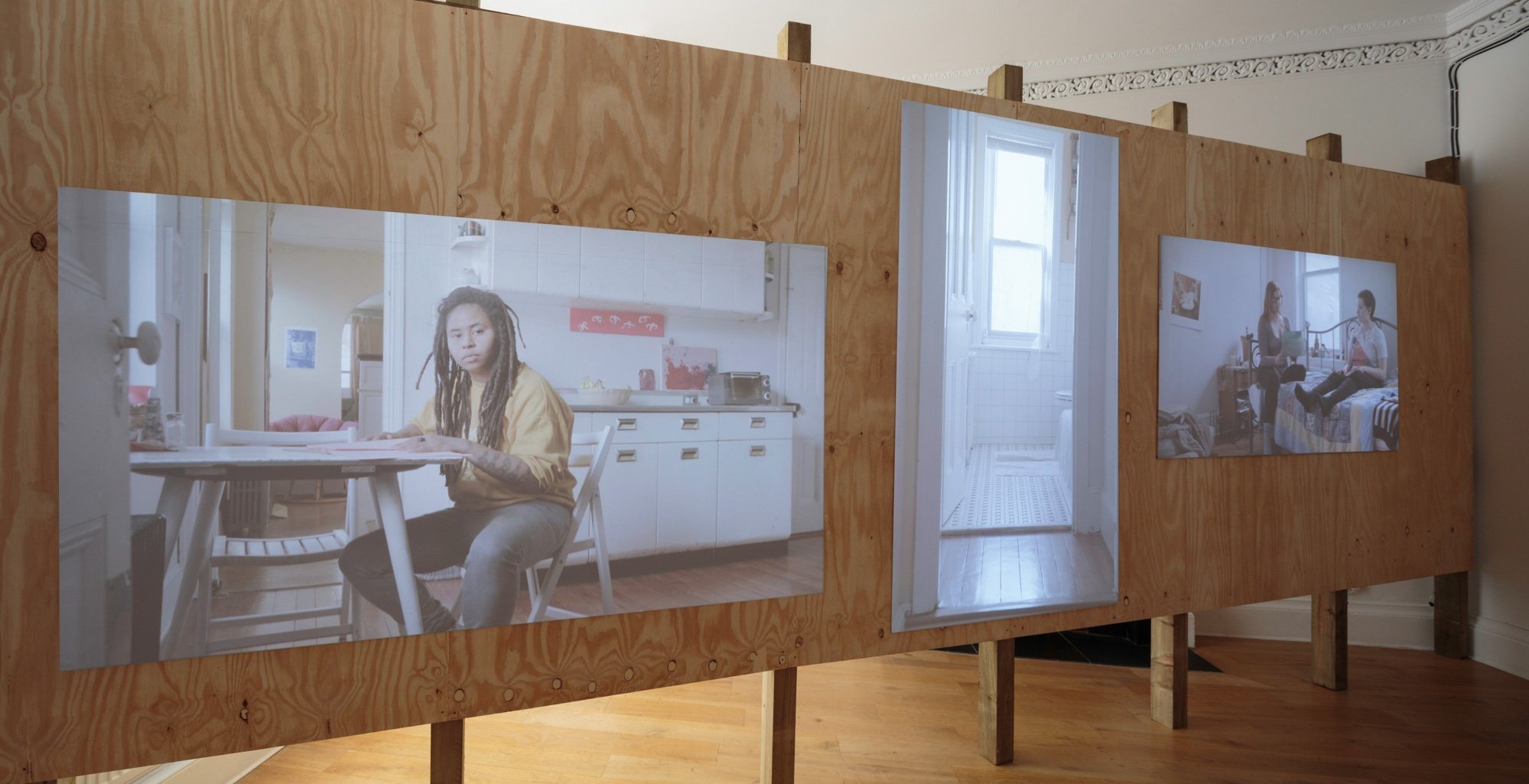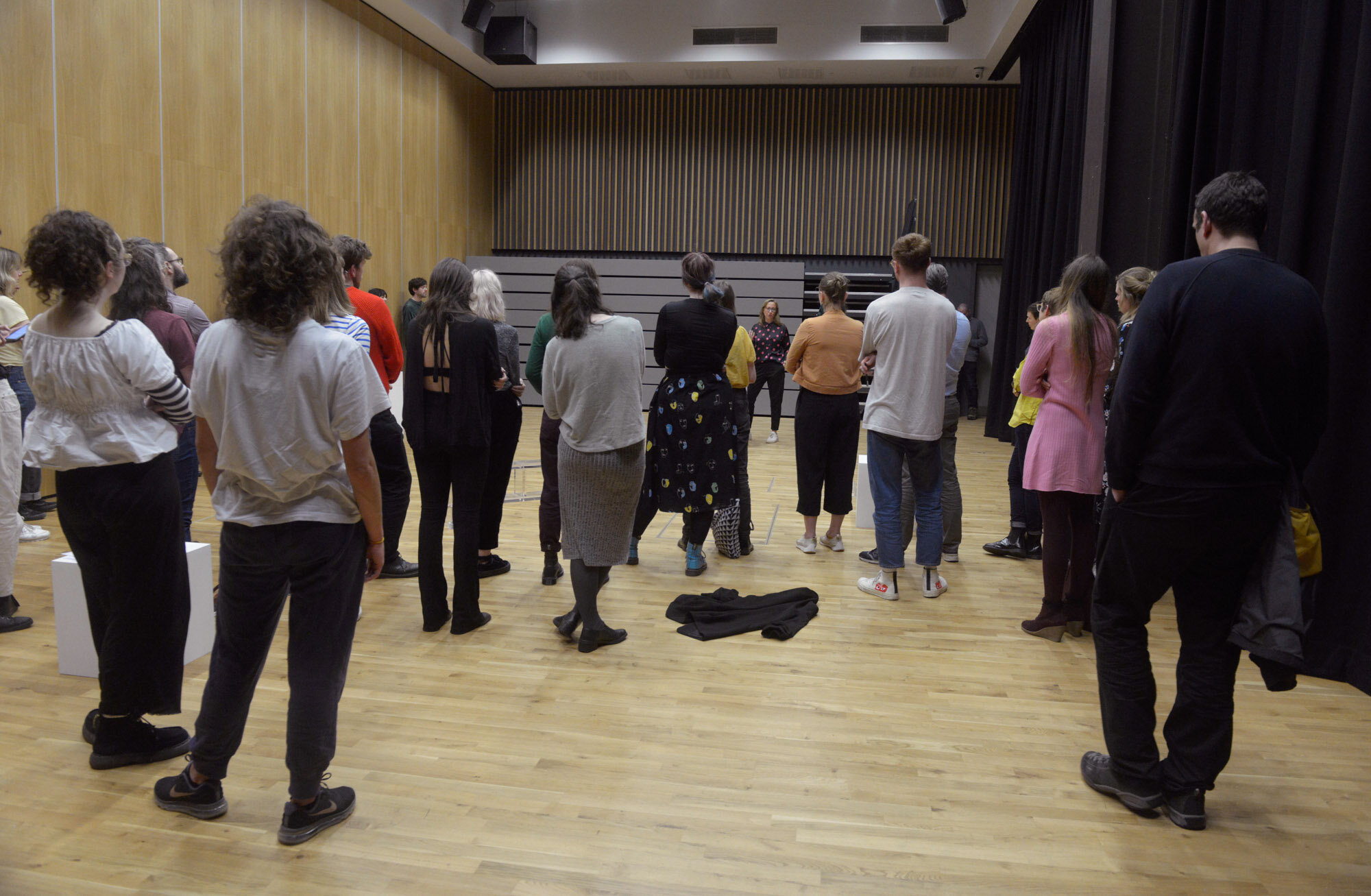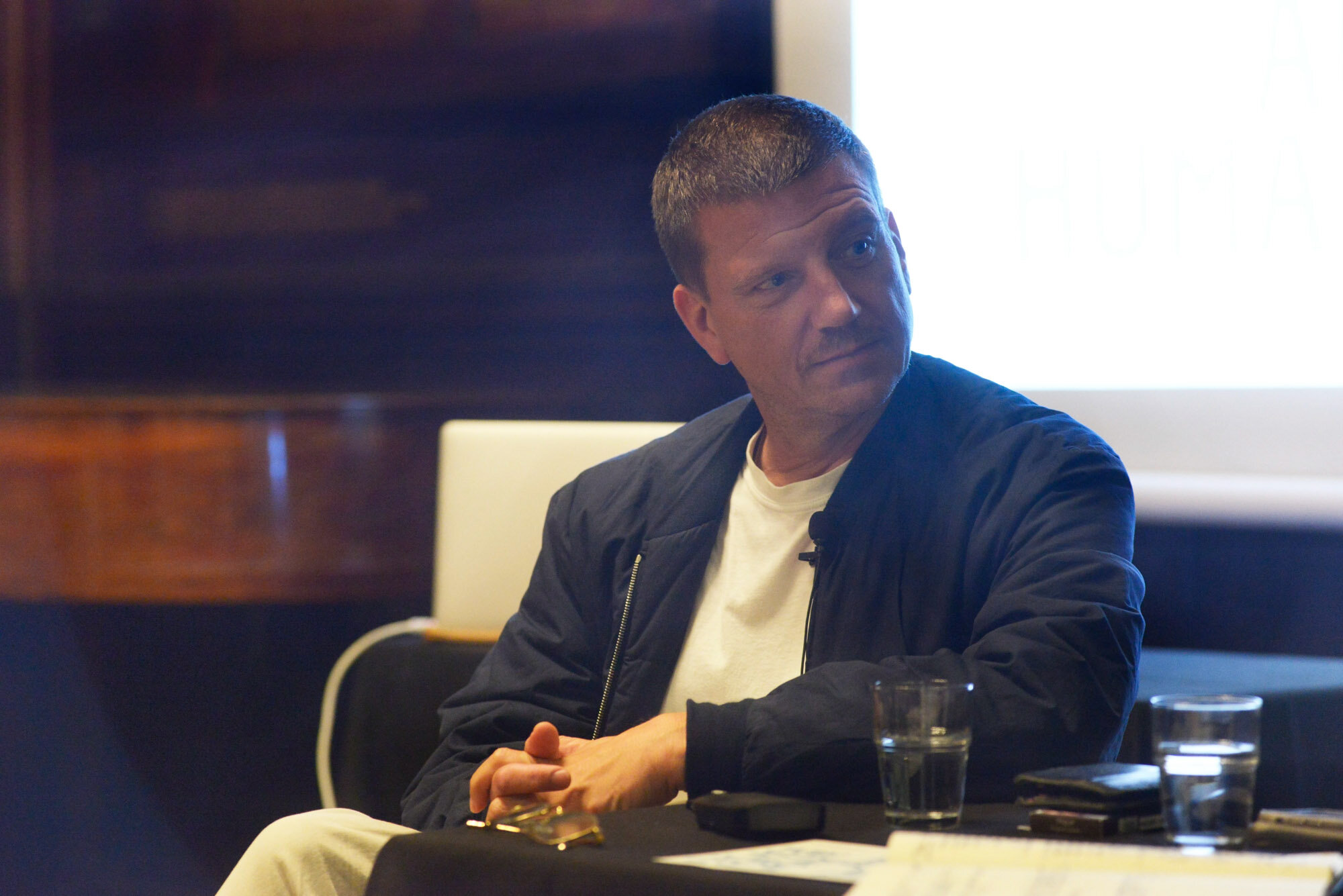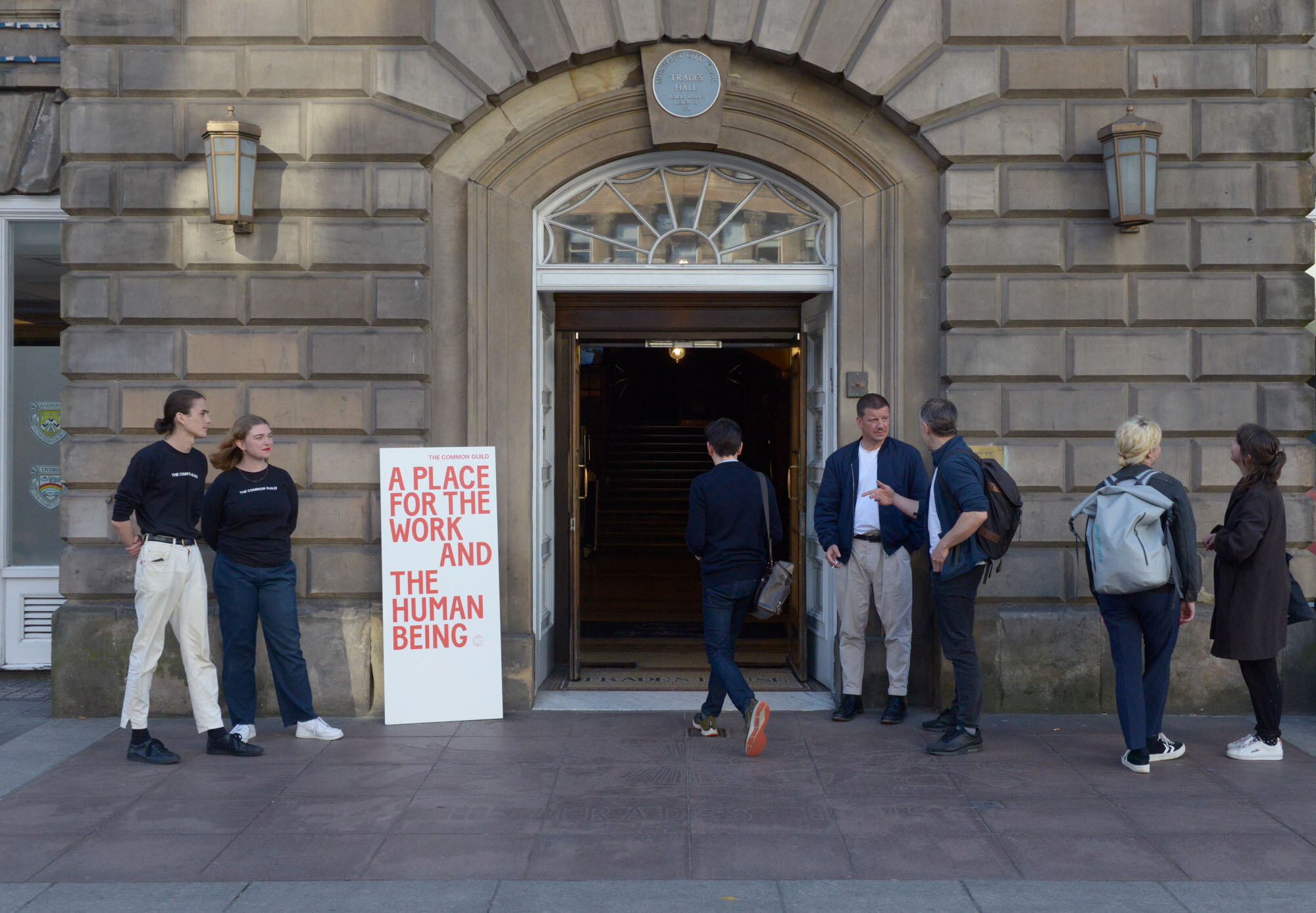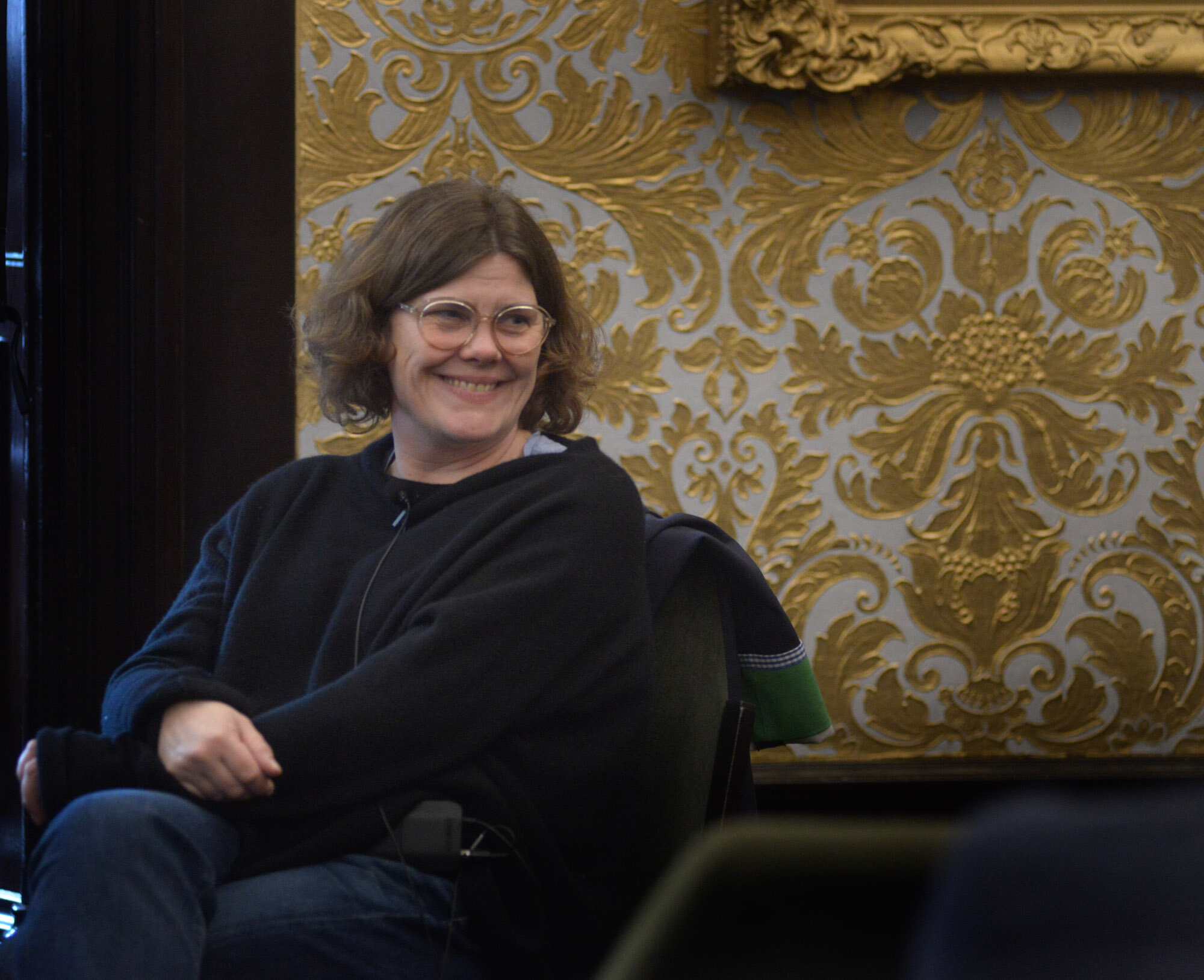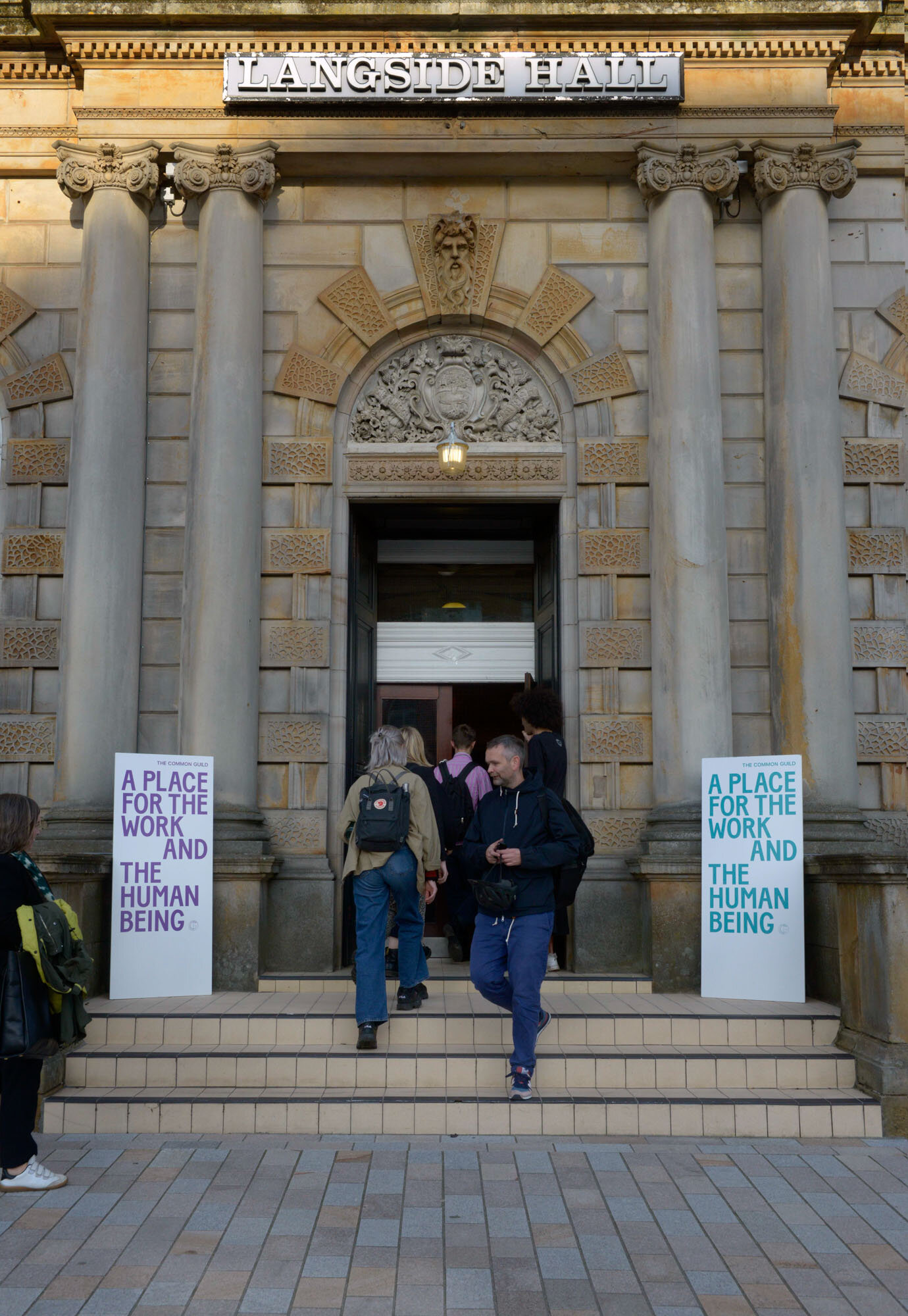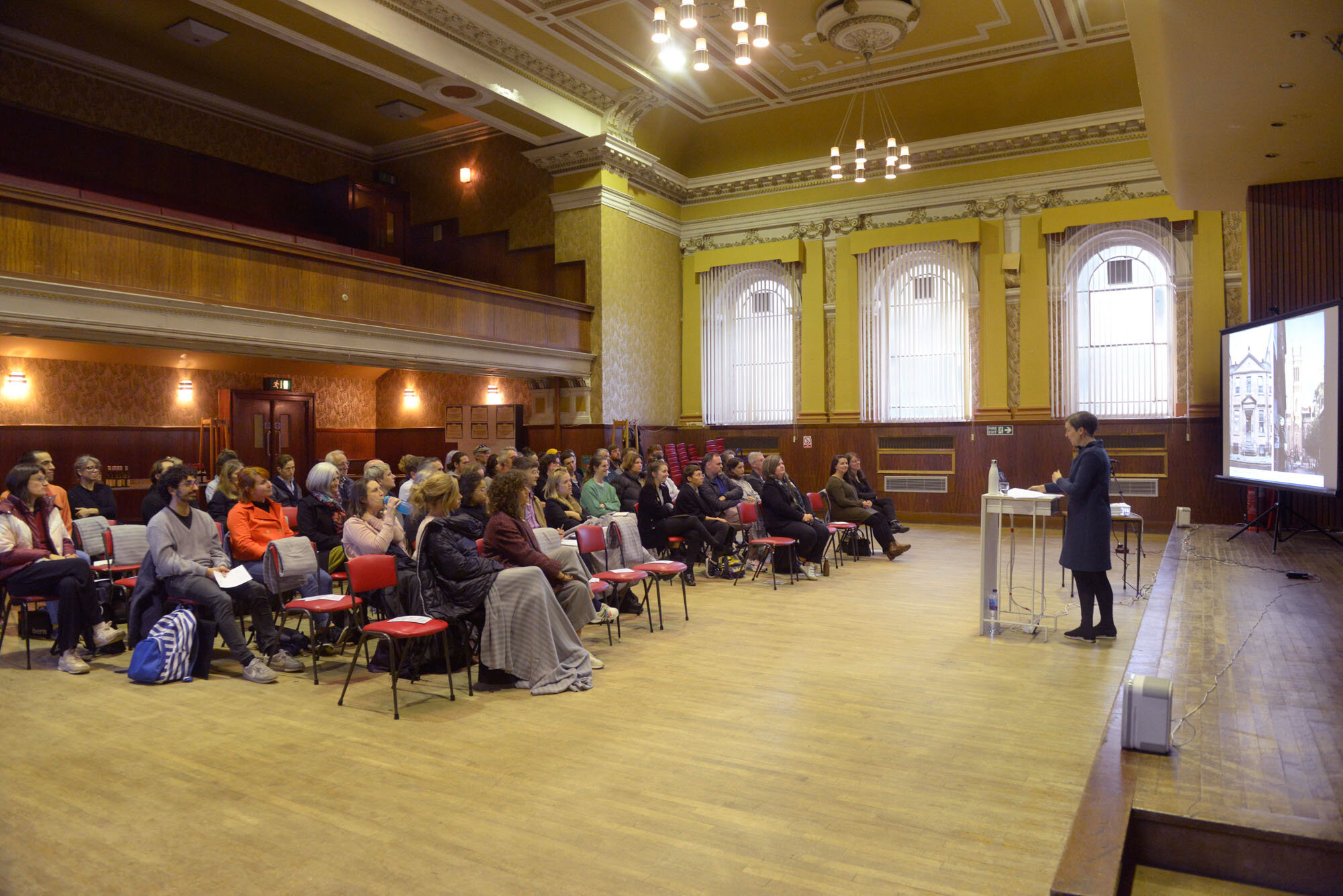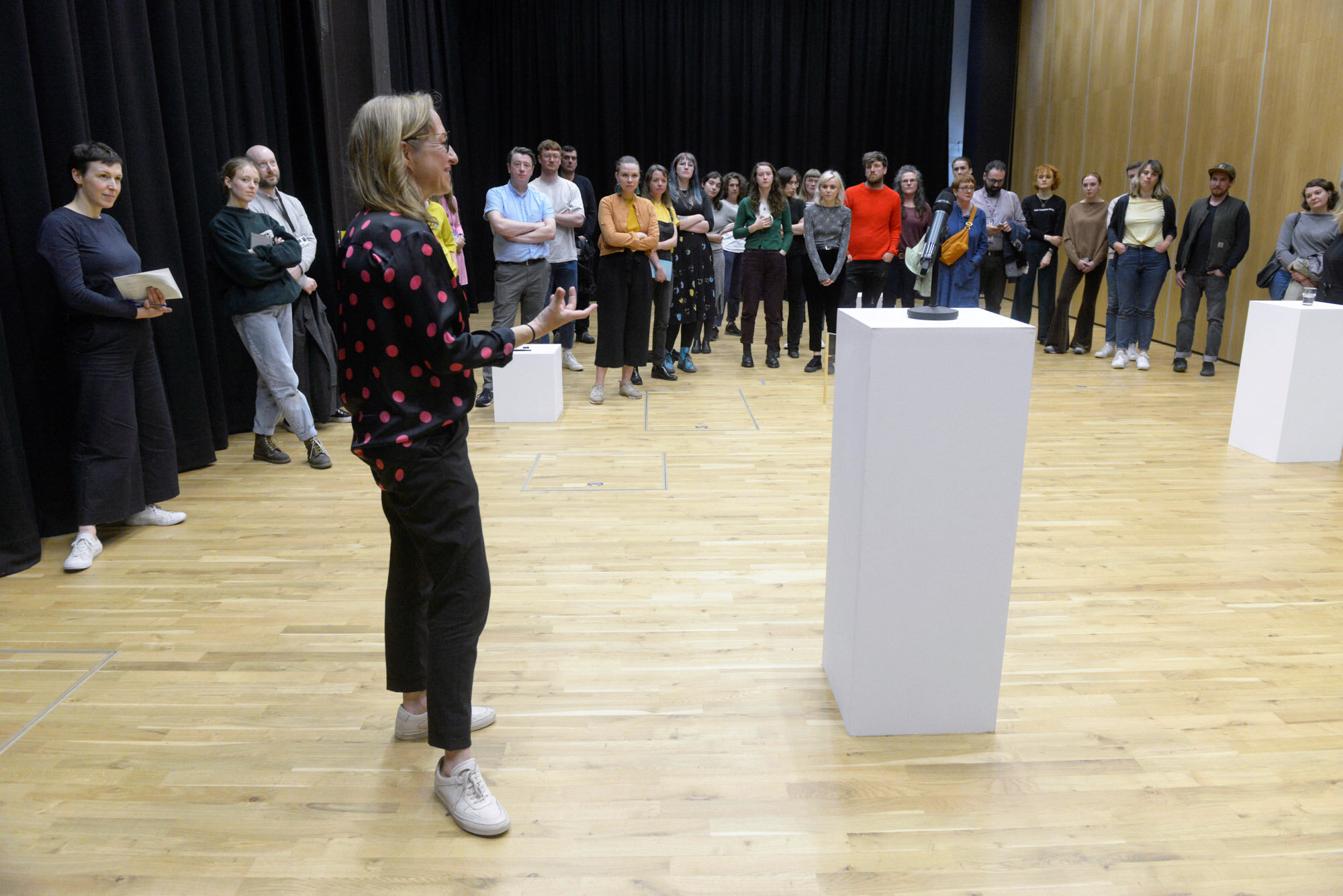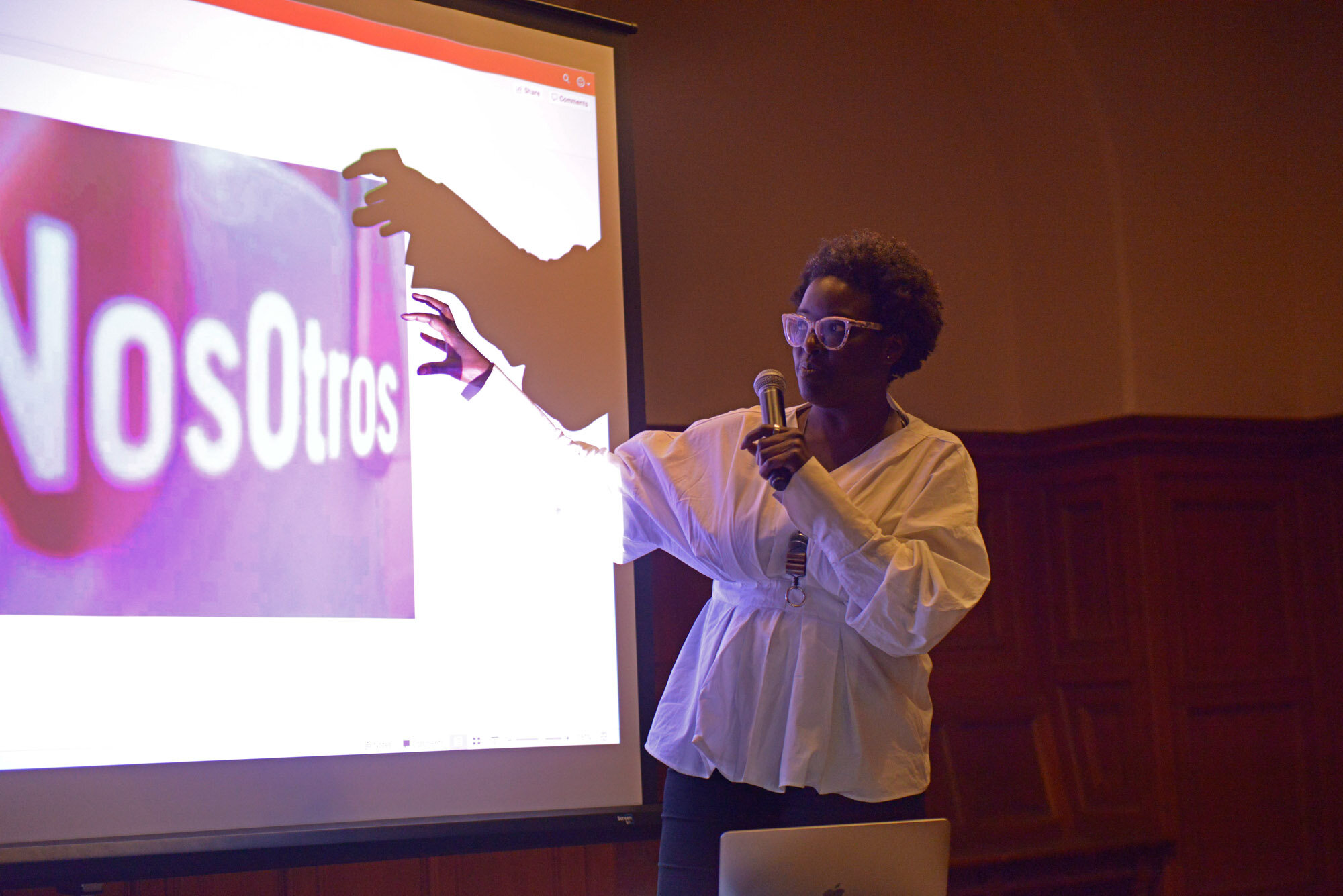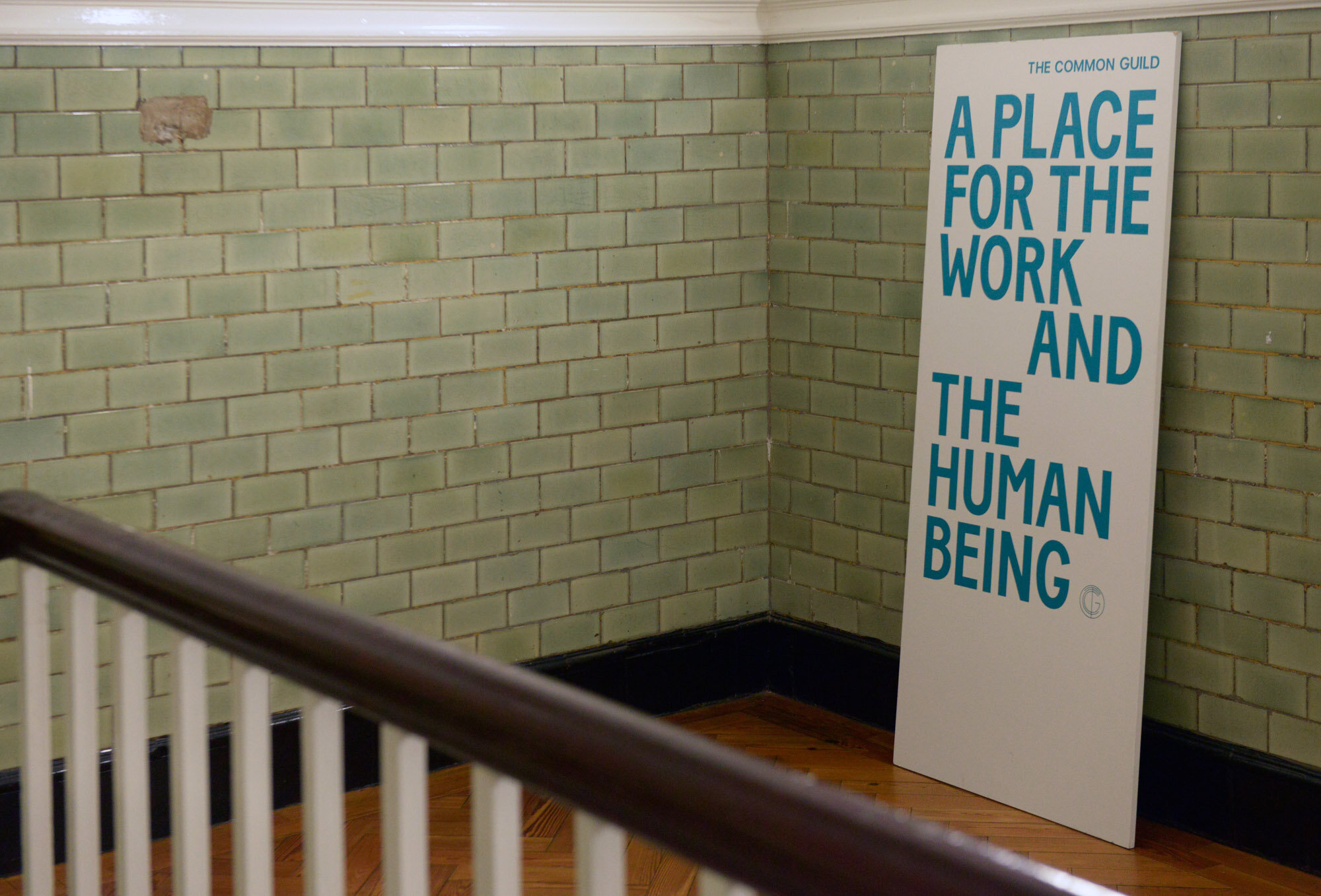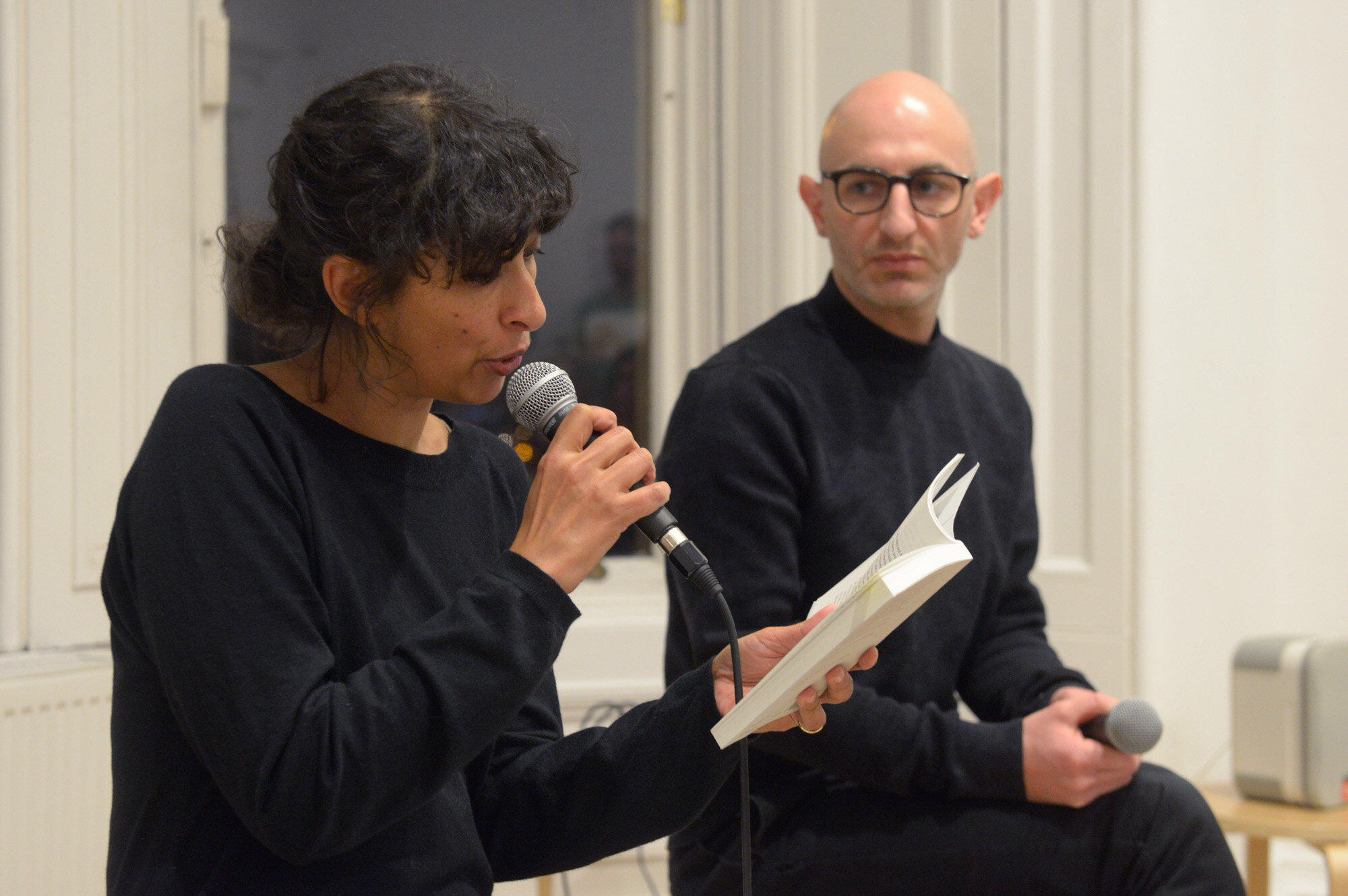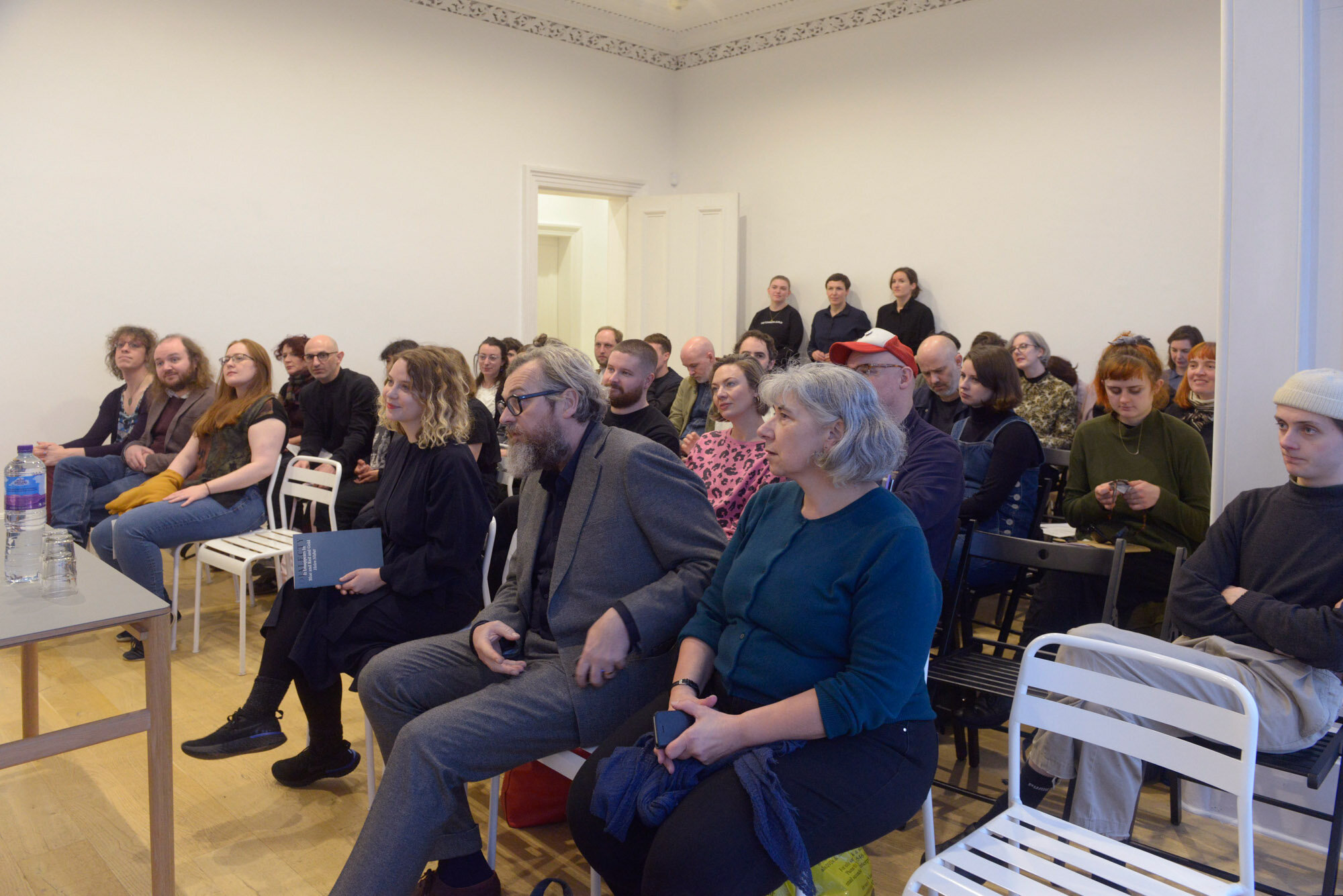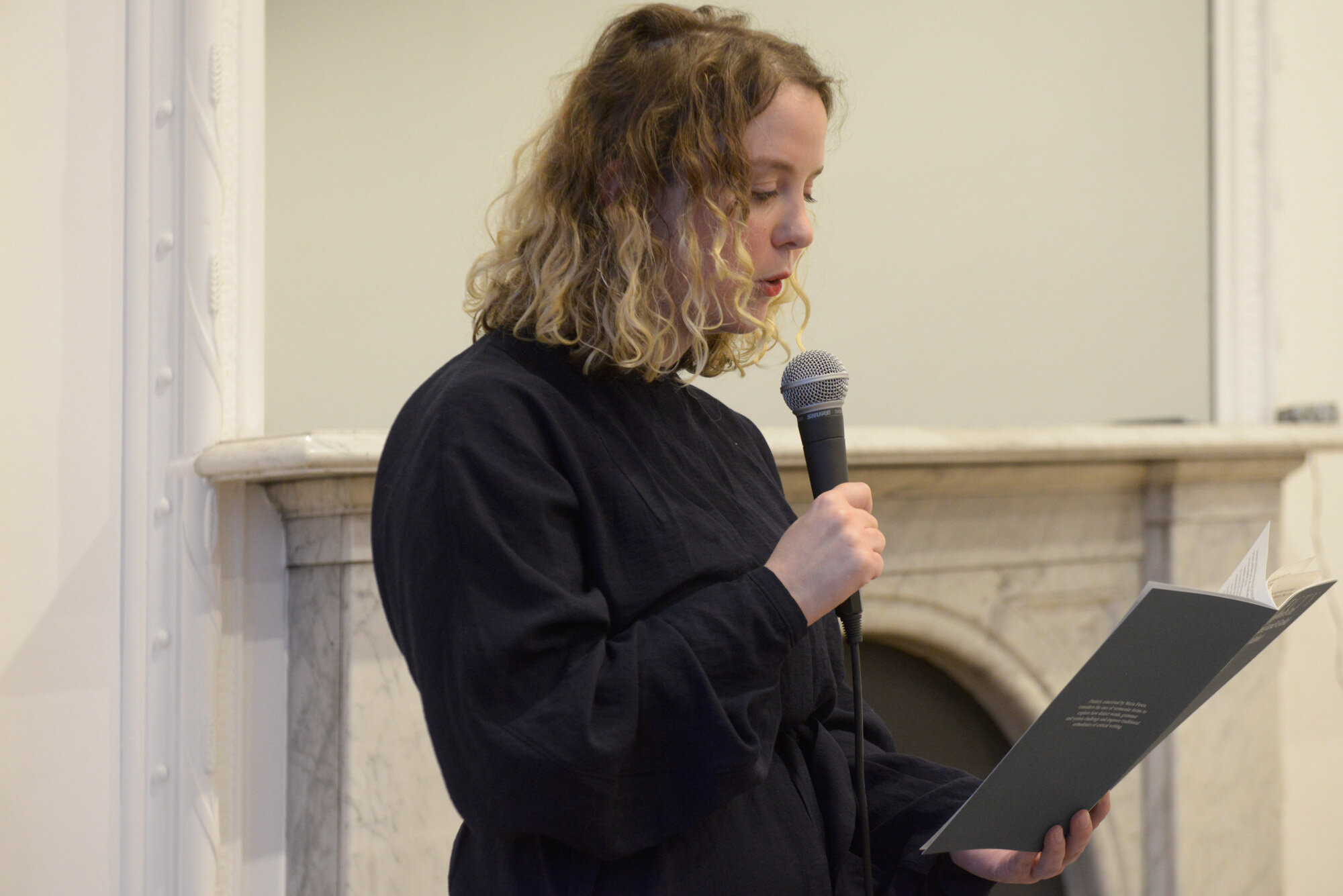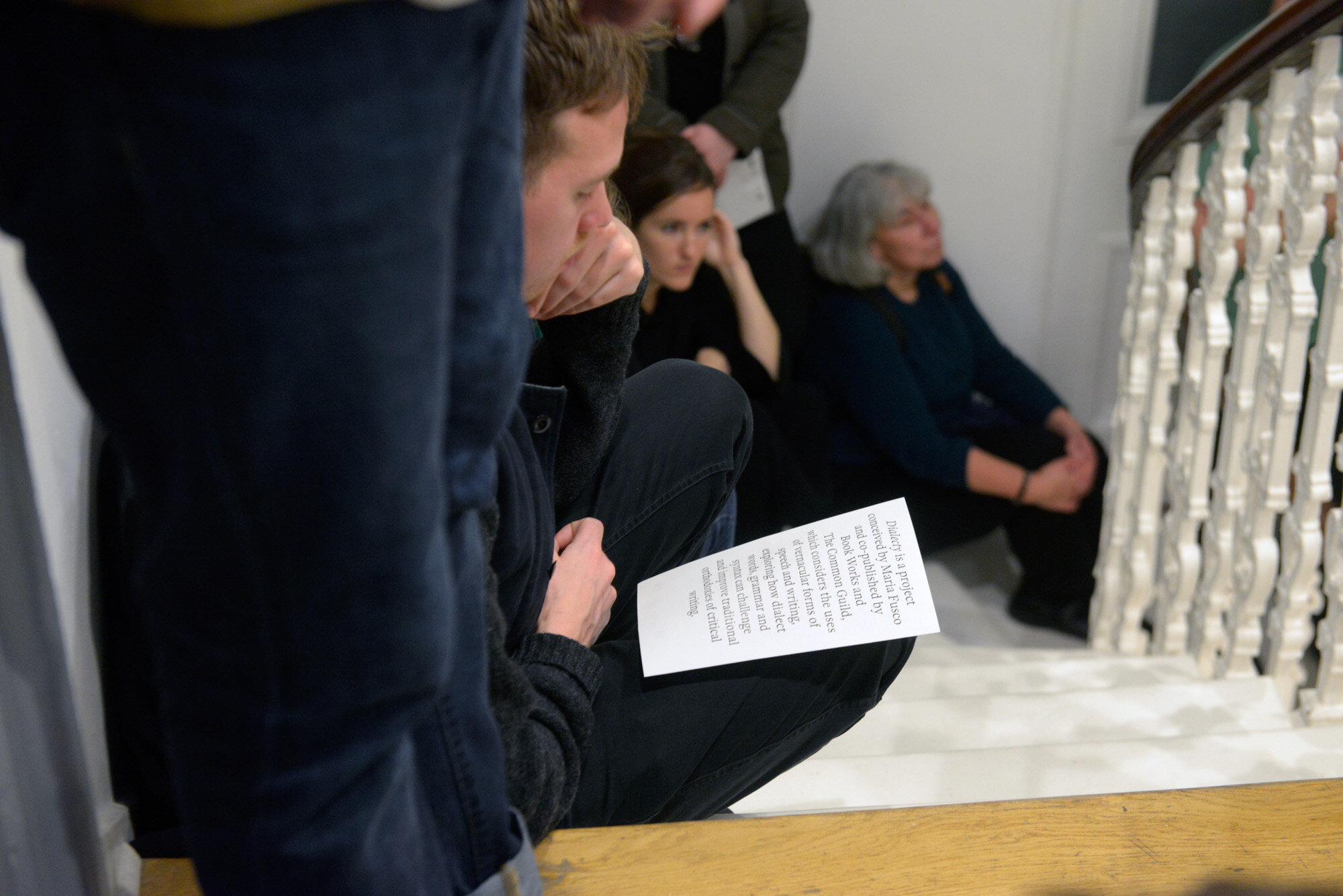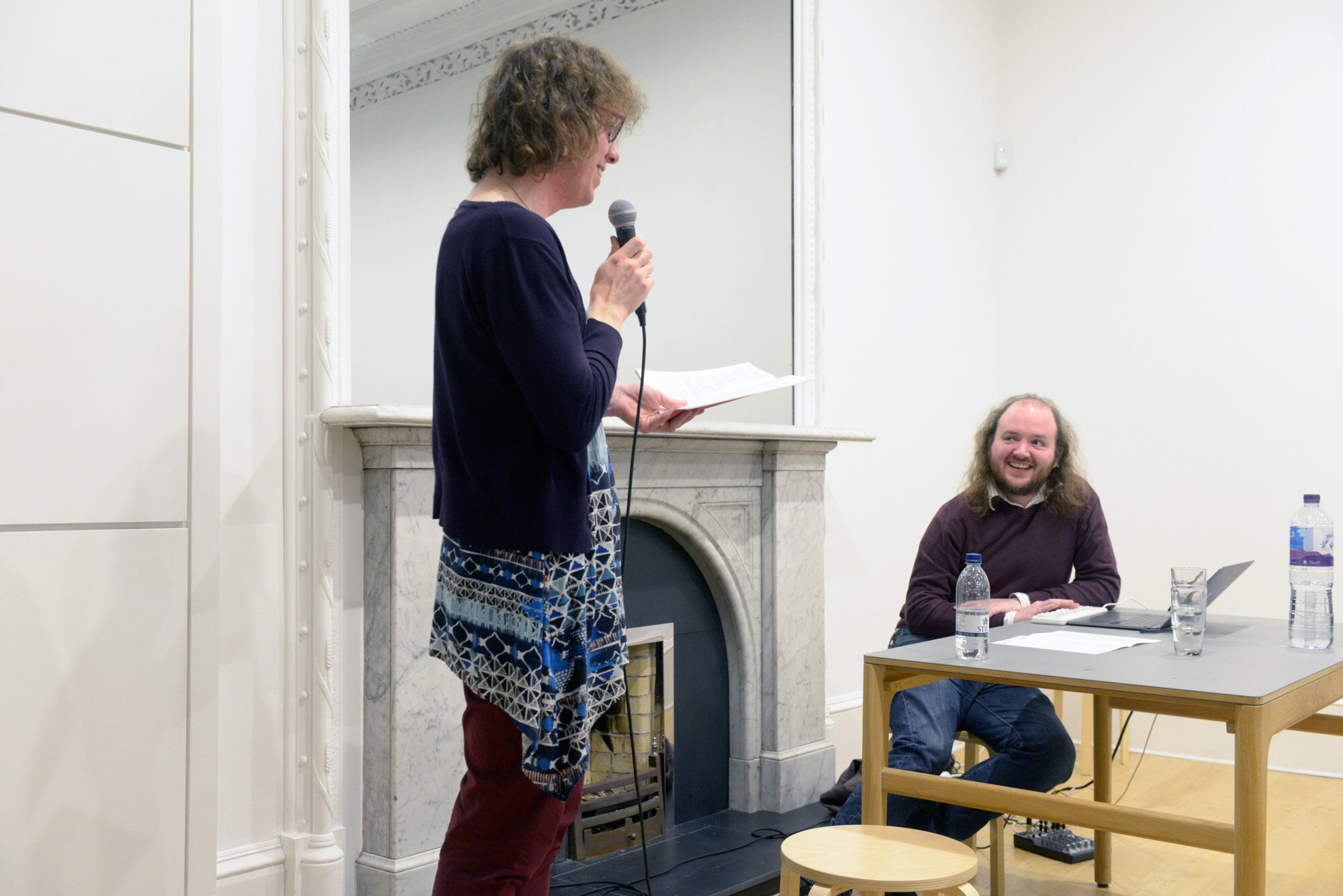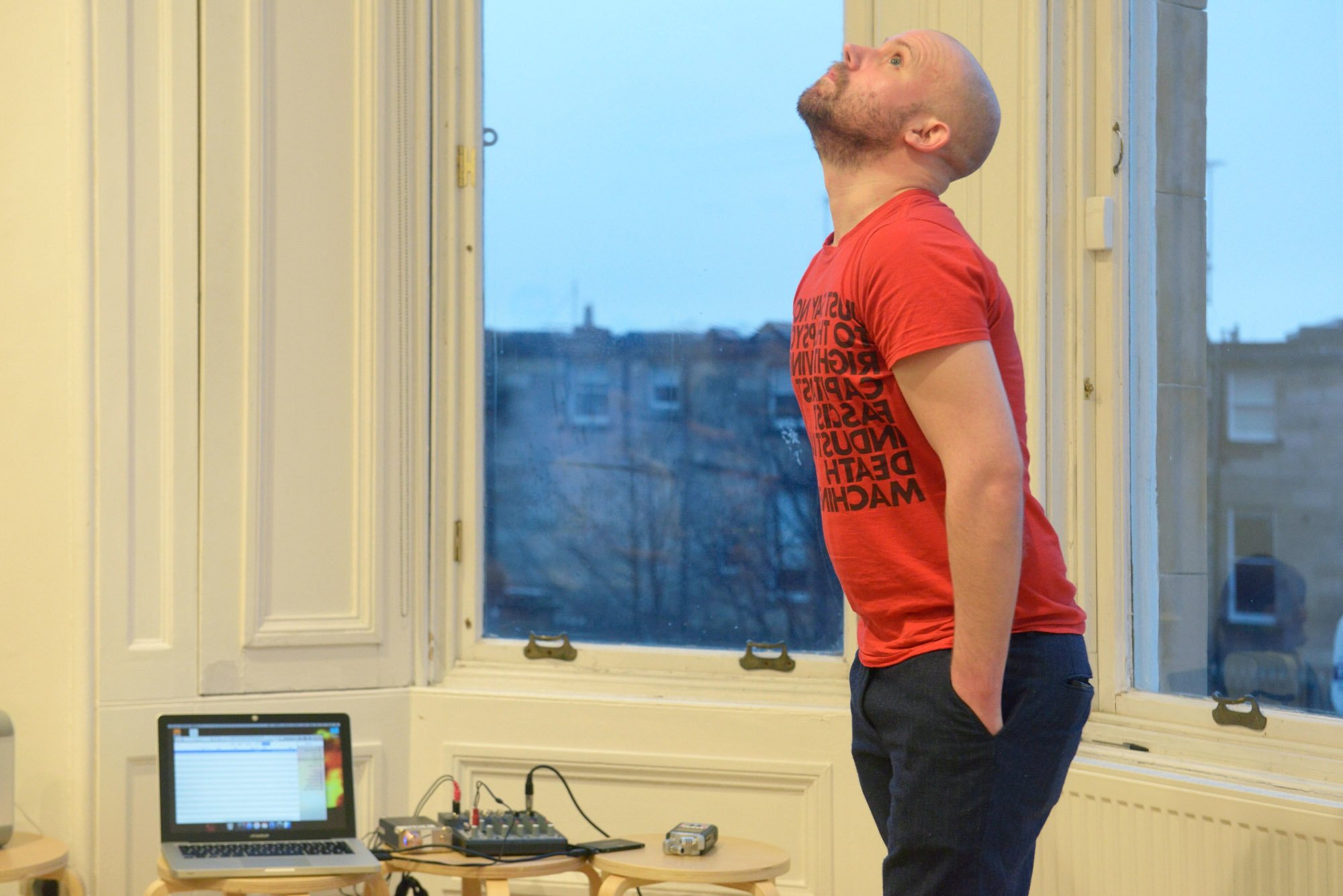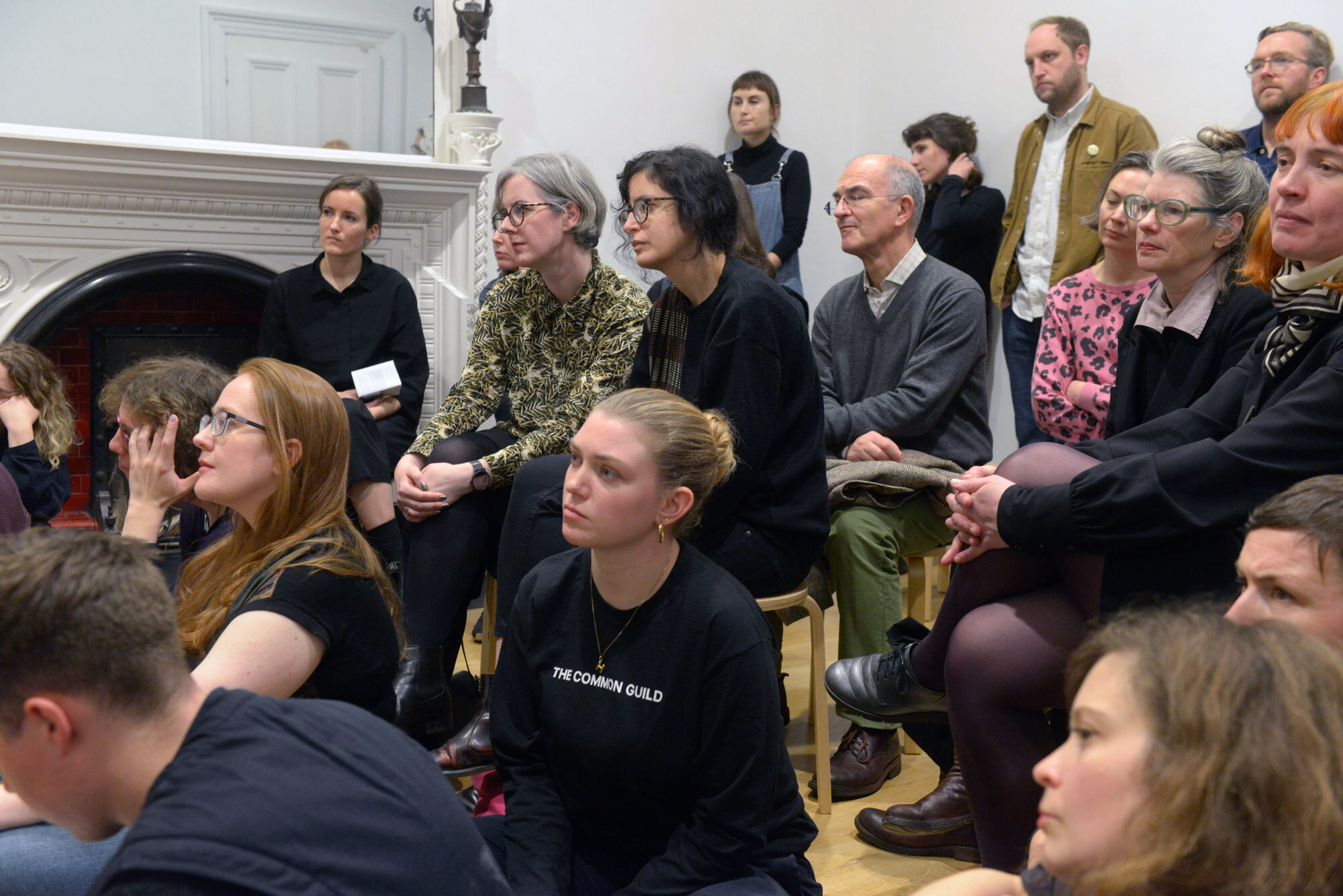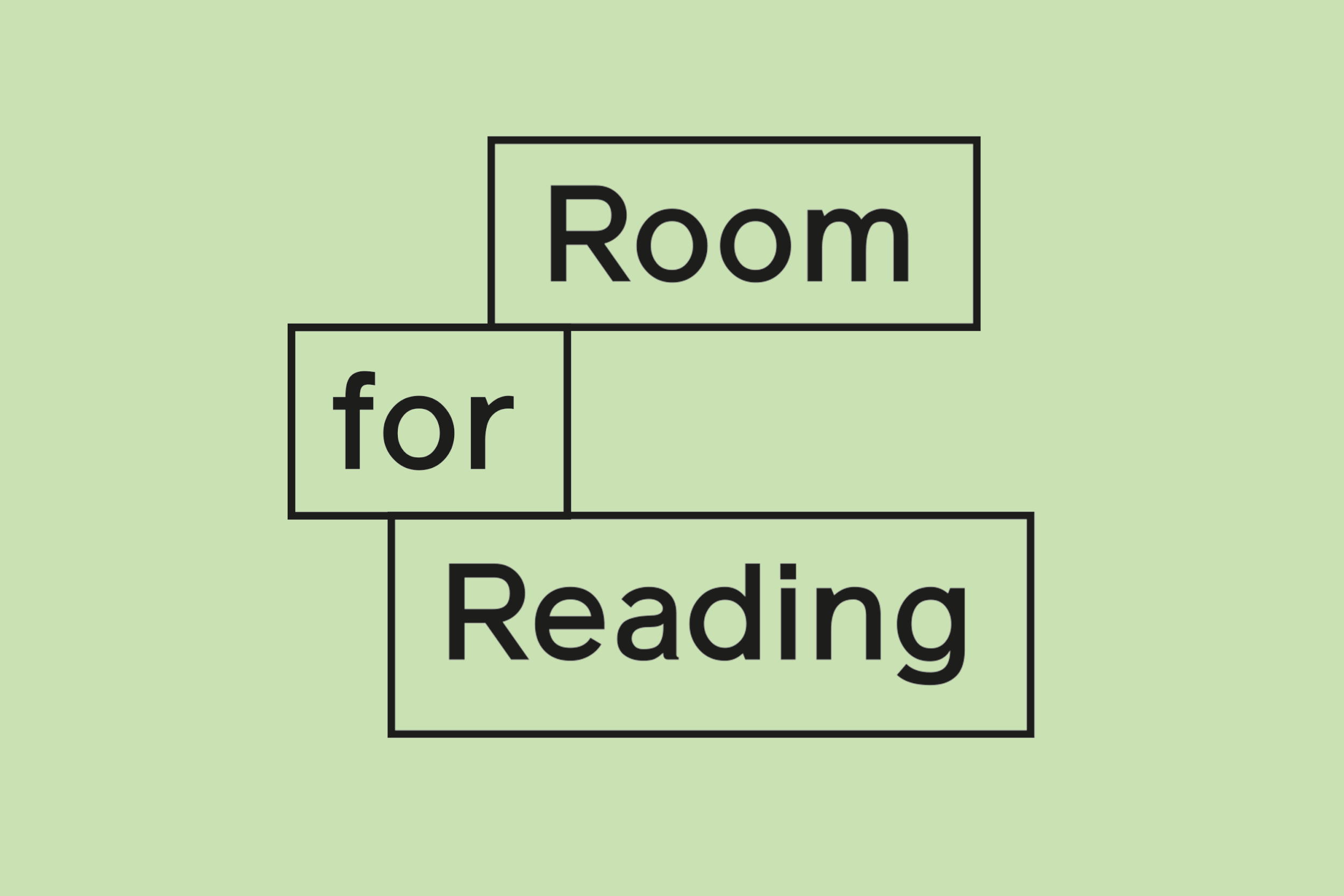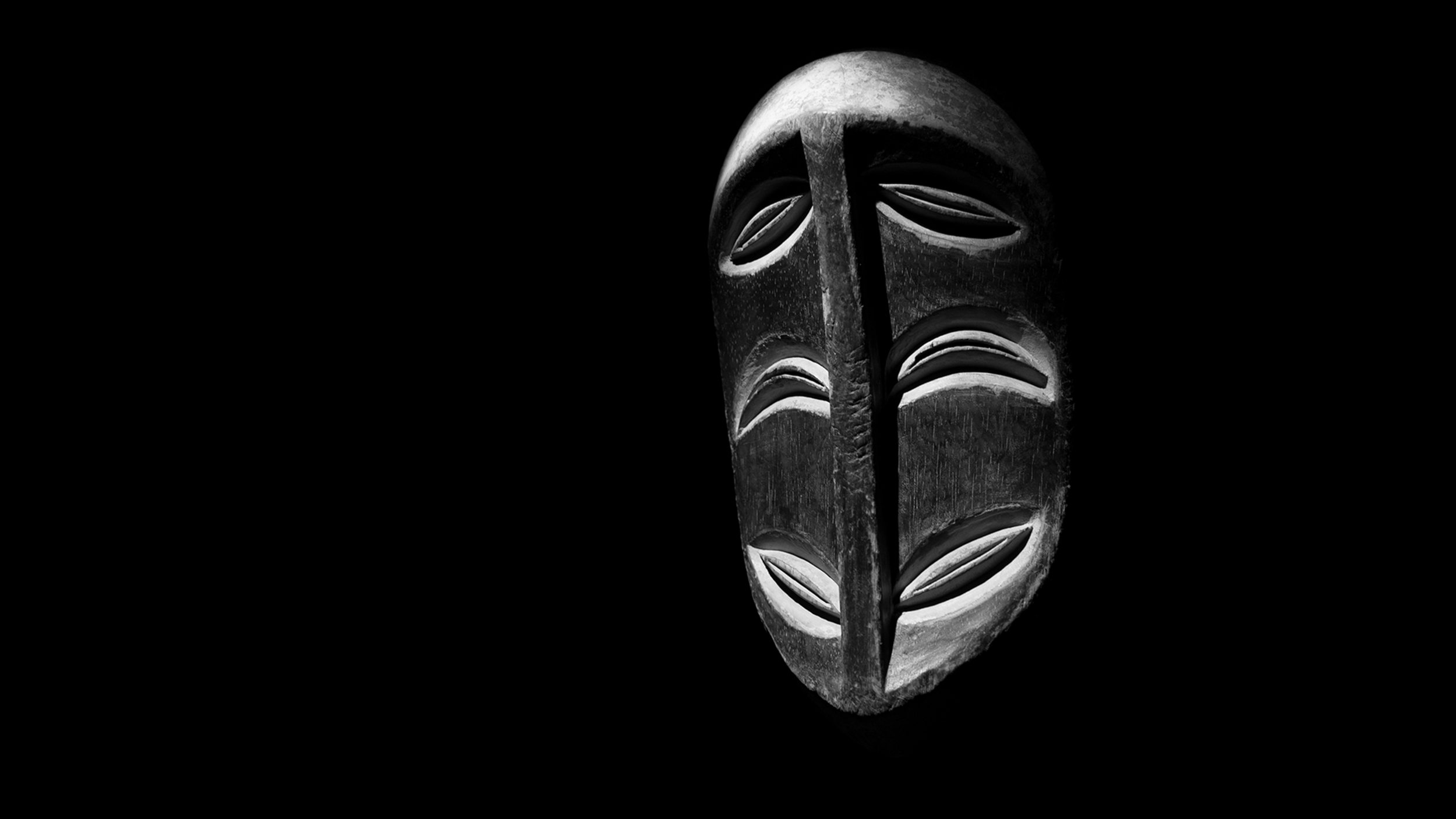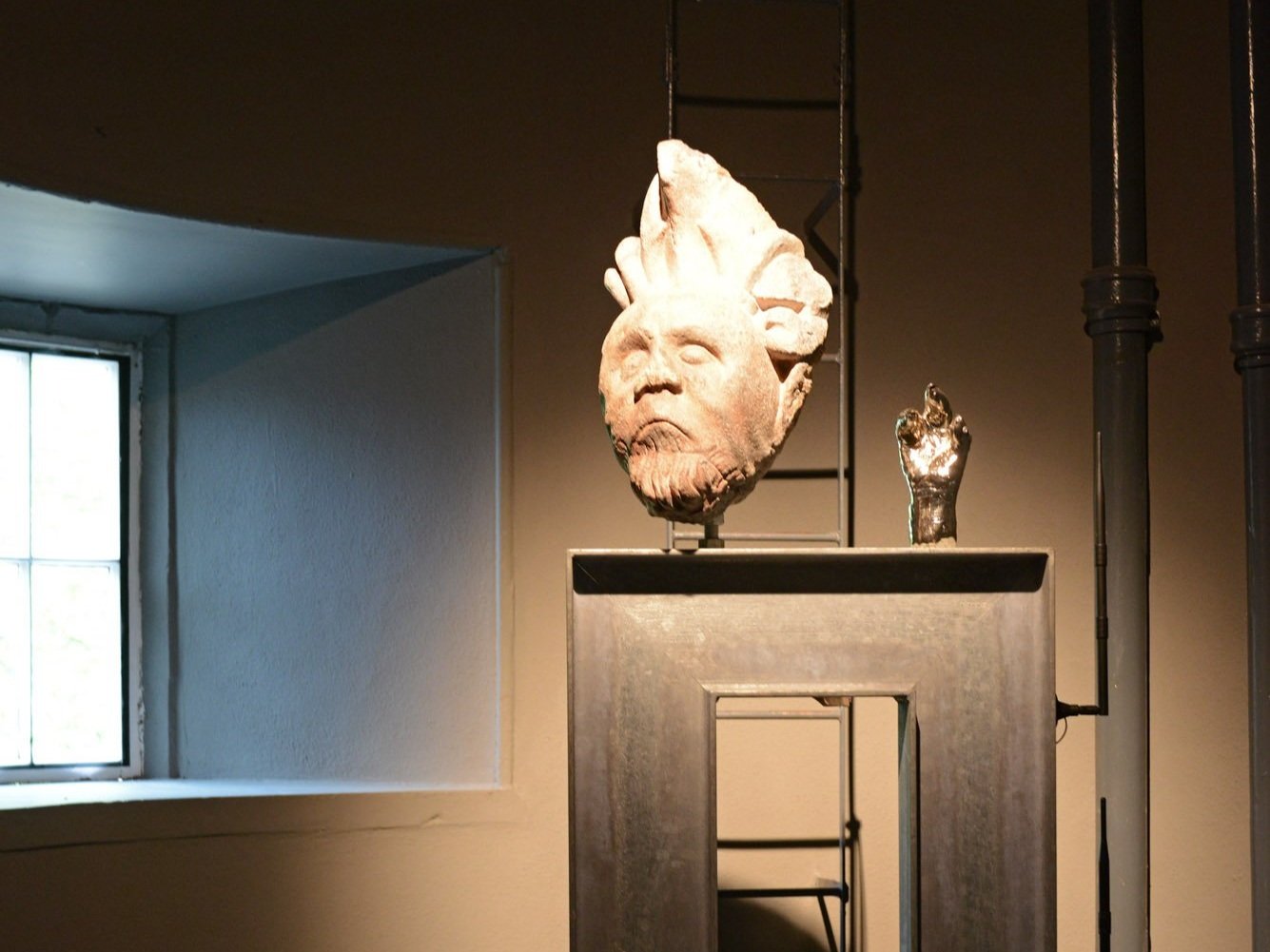
Library Session / Laura Guy & Steven Grainger – ‘Inventing Vocabularies’
Image: Albert Drive near Tramway, Glasgow, 1992. Courtesy of Simon Watney.
Led by writer Laura Guy and artist Steven Grainger, this session introduces a year-long project that explored recent histories of the city of Glasgow through queer and trans cultural practice. Framed by the idea of ‘inventing vocabularies’ – Ann Cvetkovich’s description of telling lesbian stories through oral history approaches – the session will focus on the methods and materials that the project explored.
Coinciding with Grainger’s ‘Power of Things Not Declared’, a poster project across the city, the event will be accompanied by a small display of ephemera that traces queer and trans interventions within Glasgow’s public realm. 'Inventing Vocabularies’ will invite attendees to think through these partial documents alongside practices of storytelling, making, and organising in the present.
Laura Guy is a Reader in Gender, Sexuality and Culture at the Glasgow School of Art. She is editor of Phyllis Christopher’s artist monograph Dark Room: San Francisco Sex and Politics, 1988-2003 (Book Works, 2022) and co-editor, with Glyn Davis, of Queer Print in Europe (Bloomsbury, 2022). With Fiona Anderson, Flora Dunster and Theo Gordon, she is co-editor of a special issue of British Art Studies dedicated to ‘Queer Art in Britain since the 1980s’ (Spring, 2025). Between 2023-24, she was the project lead for ‘Remapping the ‘City of Culture’ through LGBTQ+ Cultural Production’.
Steven Grainger is a Glasgow-based artist, researcher, and lecturer in Fine Art at City of Glasgow College whose sculptural and collage based practice is engaged with ideas of visibility, invisibility and queer history. Between 2023-24, he was the research assistant for ‘Remapping the ‘City of Culture’ through LGBTQ+ Cultural Production’.
Further Info
This event is supported by a Carnegie Trust Research Incentive Grant and by the Glasgow School of Art as part of the research project ‘Remapping the ‘City of Culture’ through LGBTQ+ Cultural Production’.
Event Details
This event took place on Thursday 27th February.
Listen to Laura Guy and Steven Grainger -
About Library Sessions
Centred around books, readings, discussion and the sharing of research, Library Sessions take place in TCG’s library space and include one-off sessions and events in series led by invited artists, writers, academics and researchers. Sessions might use the library as a catalyst, or contribute something new to be added to our evolving library collection.
Related
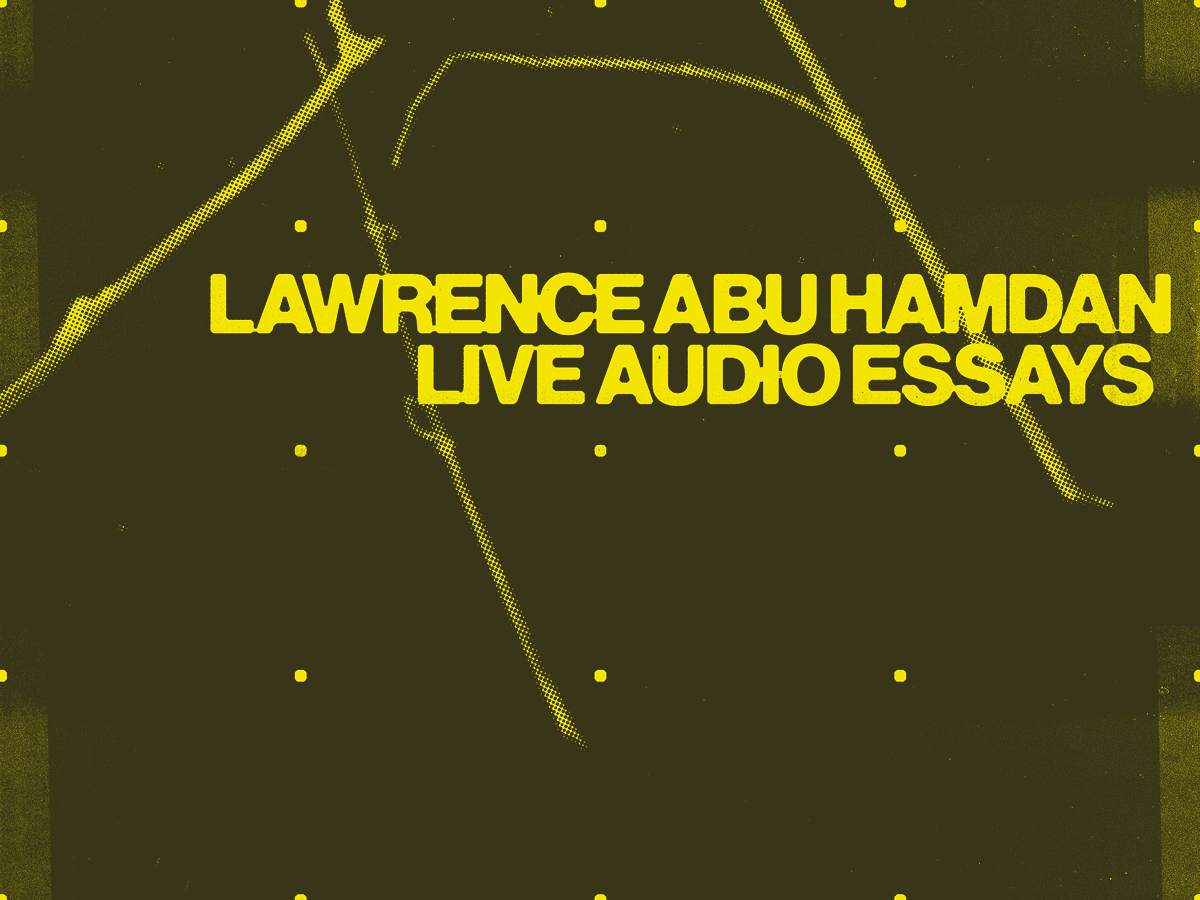
Lawrence Abu Hamdan – ‘Live Audio Essays’
Design: Tom Joyes.
Audio investigator Lawrence Abu Hamdan weaves together urgent political narratives that pivot around acoustic experience and sonic memory. ‘Live Audio Essays’ presents three key live performance works by Abu Hamdan in which sound and politics intersect. Two of the three performances have never previously been performed in the UK.
‘Air Pressure’ (2021), ‘A Thousand White Plastic Chairs’ (2020), and ‘After SFX’ (2018), will each be performed for one night only, each in a different music venue. These performances, delivered by the artist in the form of a monologue or “live audio essay”, present Abu Hamdan’s practice of research and investigative analysis, which is centred around “forensic listening”, auditory evidence and the “ear-witness” as political and legal testimony. Performances feature live percussion and guitar, filmed footage and sound design, with audio conditions enhanced to support careful listening: a conceptual and political tool for the artist.
Performances present narratives and testimonies that detail violence, oppression and aggression, offering strategies for political critique and action. ‘Air Pressure’ draws on research, conducted between May 2020–21, into the aerial soundscape of Lebanon, documenting 22,111 instances of Israeli fighter jets and drones in Lebanese airspace. ‘A Thousand White Plastic Chairs’ draws its scenography from translation techniques deployed during the Nuremberg trials (1945–46) with Abu Hamdan re-performing the asymmetry between technological prowess and the limits of cognitive processing. ‘After SFX’ is prompted by Abu Hamdan’s investigations into crimes that are heard but not seen.
‘Air Pressure’ (2021/2024)
‘Air Pressure’ (2021), the first of the performances, is a diaristic analysis written between May 2020 and May 2021 into the aerial soundscape of Lebanon where, from 2006–2021, there had been over 22,111 instances of Israeli fighter jet and drone violations in Lebanese airspace. Deploying publicly accessible information uploaded to the UN Digital Library, Abu Hamdan’s research and analysis brings this data together for the first time, making clear the scale and intensity of these incursions, and the consistent atmosphere of violence brought to bear across the territory.
Residents of Lebanon live in a state of precarity with the constant background noise of hostile jets and drones overhead. The potential of full-scale aerial bombardment is a daily possibility. Whether they are actively ignoring the noise from above or determined to document the violent aerial machines conspicuously hovering in the near distance, residents have developed modes of resistance.
Abu Hamdan’s account unfolds with live audio processing and countless videos of the rumbling sky, both pulled from open source content and captured by the artist and his team. Abu Hamdan employs the 'atmospheric' both aesthetically and conceptually to explore the ways in which violence is made manifest, reading Lebanon's air as a high pressure nexus in a global weather system.
'Air Pressure' is performed by Lawrence Abu Hamdan with live sound design by Moe Choucair. It has never previously been performed in the UK. With thanks to SWG3.
‘A Thousand White Plastic Chairs’ (2020/2024)
‘A Thousand White Plastic Chairs’ (2020) is performed by Abu Hamdan with electric guitar accompaniments by Fabio Cervi. The scenography for this work – flashing red and yellow lights – is inspired by the system of simultaneous translation deployed during the Nuremberg trials in the aftermath of World War II in 1945–6. This newly developed electronic audio technology enabled simultaneous translation of the trial proceedings from their spoken languages into Russian, French, German, and English.
During the performance Abu Hamdan is illuminated by these lights alone, which command and direct the artist’s speech. The performance departs from this apparatus to examine the inextricable relation between testimony and the technologies by which it is disseminated and distorted. Here, Abu Hamdan re-performs the asymmetry between the speed of the technology – which allowed words to travel through copper cables at 4,600 metres per second – and the speed of the human mind to process what it sees and stores of a given event. ‘A Thousand White Plastic Chairs’ serves as a proposition that the true capacity to bear witness is measured not through acts of coherent testimony and seamless speech but rather through its interruptions and breaking points.
'A Thousand White Plastic Chairs' has never previously been performed in the UK.
‘After SFX’ (2018/2024)
‘After SFX’ (2018) is prompted by sonic evidence, acoustic memories, and Abu Hamdan’s investigations into crimes that had been heard but not seen. The performance explores a series of sounds deriving variously from legal cases and trial transcripts, transhistorical testimonies, and interviews conducted by the artist with earwitnesses. The artist’s earwitnesses include prisoners held in Saydnaya, a brutal prison operated by the Syrian government.
In order to facilitate their testimonies and determine what they heard, Abu Hamdan experimented with pre-existing cinematic sound effects libraries, before developing his ‘Earwitness Inventory’ (2018–ongoing) a self-constructed sound effects library specific to the witnesses’ acoustic memories. The inventory includes everyday objects like a car door, popcorn maker, coins and loaves of bread. These objects operate as sonic analogies, conjuring sounds but also referencing psychological states of mind. A number of objects from the Earwitness Inventory will be activated during the performance.
‘After SFX’ explores sonic recall, and the question of a shared experience of sound. The performance points towards the difficulty of translation and the limits of language, offering a new acoustic vocabulary to articulate witness experience.
‘After SFX’ is performed by Lawrence Abu Hamdan with live sound design by Adam Laschinger and percussion by Iain Stewart. It is presented for the first time in Scotland in a new iteration developed in 2023.
About the artist /
Lawrence Abu Hamdan is an award winning artist, audio investigator and the founder of Earshot, the world’s first not-for-profit organisation producing audio investigations for human rights and environmental advocacy.
Abu Hamdan's work on sound and listening has been presented in the form of forensic reports, lectures and live performances, films, publications, and exhibitions all over the world. He received his PhD in 2017 and has held fellowships and professorships at the University of Chicago, the New School, New York and the Johannes Gutenberg University Mainz, where he developed his research AirPressure.info.
Project Details
Part of Glasgow International 2024 Open Programme.
‘Air Pressure’ was performed at SWG3 on the opening night of Glasgow International, ‘A Thousand White Plastic Chairs’ was performed at Audio, and ‘After SFX’ was performed at Barrowlands at the closing night of GI.
Watch an excerpt of ‘A Thousand White Plastic Chairs’ here –
Watch an excerpt from ‘After SFX’ here -
Read the Commentary by Neil Clements —
Listen to Neil Clements read the Commentary here –
Thanks
With thanks to Fabio Cervi, Moe Choucair, Adam Laschinger, Ambroise Leclerc, Jonny Lyons, Iain Stewart, Duncan Young.
Thanks to Audio, the Barrowlands, SWG3 and Inhouse.
Live captions were provided during performances with thanks to Marta Tycinska.
Related

Artists’ Talk / Martin Boyce & Nicole Wermers with Fatoş Üstek
Nicole Wermers, ‘Day Care’ (2024). Installation view, The Common Guild at 60 York Street, Glasgow. Courtesy the artist; Herald St, London; Tanya Bonakdar Gallery, New York and Los Angeles; Jessica Silverman, San Francisco; and Produzentengalerie Hamburg. Photo: Ruth Clark.
As part of Nicole Wermers’ exhibition ‘Day Care’, and in parallel with Martin Boyce's exhibition ‘Before Behind Between Above Below’ currently at the Fruitmarket, Edinburgh, the artists will be in conversation with the curator and writer Fatoş Üstek.
The artists will discuss their sculptural practice through their respective current exhibitions as well as their shared interest in architecture, the built environment, and the materiality of the everyday.
Fatoş Üstek is an independent curator and writer. She is the author of The Art Institution of Tomorrow, Reinventing the Model (2024), curator of Frieze Sculpture, London and Co-Founder & Managing Director for FRANK Fair Artist Pay. She was previously Director of the Liverpool Biennial, Director of the Roberts Institute of Art, Curator of Art Night, 2017, London and Associate Curator of the 10th Gwangju Biennial, South Korea. In 2015 she was the Art Fund Curator at fig-2, a ground-breaking project which presented 50 projects in 50 weeks at the ICA, London.
Event Details
Listen to Nicole Wermers and Martin Boyce in conversation –
Location
Capella Building
60 York Street Glasgow, G2 8JX
The Common Guild is on the 7th Floor.
Transport Links: Glasgow Central Station is a five minute walk away.
Access
There is ramped access from the street to the ground floor reception.
The 7th floor is accessible by lift from the reception area. Visitors can check in at reception.
There are double doors in the lift lobby on the 7th floor. Please ring the doorbell for assistance.
Live captions will be available on a screen generated by Microsoft Speech Services.
Related

Nicole Wermers – ‘Day Care’
Nicole Wermers, ‘ Reclining Female #3’ (2022) (detail). Courtesy the artist; Herald St, London; Tanya Bonakdar Gallery, New York and Los Angeles; Jessica Silverman, San Francisco; and Produzentengalerie Hamburg. Photo: Gunnar Meier. Design: Tom Joyes.
Nicole Wermers’ ‘Day Care’ is an exhibition of new and recent sculptures set against the backdrop of Glasgow’s urban landscape. The works on show intertwine visions of women’s bodies at work or rest with the economics and politics of (urban) space, and the visibility and value of high art with the invisibility of care and maintenance work.
‘Day Care’ includes two newly commissioned sculptures, alongside sculptural interventions in the corporate office space of The Common Guild’s temporary premises on the seventh floor of 60 York Street. The exhibition marks Wermers’ most substantial institutional UK presentation to date.
Nicole Wermers, ‘Day Care’ (2024). Installation view, The Common Guild at 60 York Street, Glasgow. Courtesy the artist; Herald St, London; Tanya Bonakdar Gallery, New York and Los Angeles; Jessica Silverman, San Francisco; and Produzentengalerie Hamburg. Photo: Ruth Clark.
‘Day Care’ presents work from the artist’s latest series, ‘Reclining Females’ (2022–2024). These sculptures bring together the familiar, art historical trope of the reclining nude, with readymade commercial products and the banal apparatus of the service industry to critically engage with the social, psychological and economic conditions of urban space and architecture.
Wermers’ lounging female nudes appear larger than life-size and are hand-formed in plaster over styrofoam. Striking poses that evoke Henry Moore’s reclining bronze women, these voluptuous figures have the rough-hewn appearance of largescale sculptural studies. Each of the female figures adopts a different posture of repose, heads angled to meet the viewer’s gaze from an elevated position. They balance on wheeled maintenance carts filled with mops, freshly pressed linen, plastic bottles and chemical products for cleaning and disinfecting spaces such as hotels and corporate environments: spaces like the temporary gallery where they will be displayed.
The formal juxtaposition of the figures and carts create tension between ideas of labour and leisure, undermining gestures of decadence and desire routinely expressed by (male) renditions of the female nude. Instead, the figures imply exhausted, overworked bodies: low-waged and typically invisible women’s labour that sustains commercial and business environments. At the same time their size and elevated position asserts their defiant presence and independent agency. In the particular white-collar context of The Common Guild’s temporary space, the artworks generate discourse on corporate structures and overlooked labour hierarchies.
Nicole Wermers, Reclining Female #6 (2024). Courtesy the artist; Herald St, London; Tanya Bonakdar Gallery, New York and Los Angeles; Jessica Silverman, San Francisco; and Produzentengalerie Hamburg. Photo: Ruth Clark.
About the artist /
Nicole Wermers (born 1971 in Emsdetten, Germany) lives and works in London. She studied at Hochschule für bildende Künste, Hamburg from 1991–97 and received an MFA from Central Saint Martins College of Art and Design in 1999. Since 2017 she has been a professor of sculpture at Akademie der Bildenden Künste, Munich. Wermers was short-listed for the Turner Prize in 2015.
Selected solo exhibitions include: ‘Reclining Fanmail’, Kunsthaus Glarus; ‘P4aM2aRF!’, Herald St, London; ‘Emscher Folly’, Urbane Künste Ruhr/ Emscher Kunstweg, Duisburg permanent public art commission, (all 2022); ‘Earring for Cambridge’ public commission for Cambridge Judge Business School, Cambridge University; ‘Women between Buildings’, Kunstverein Hamburg, (both 2018); ‘Grundstück’, Jessica Silverman Gallery, San Francisco, (2017); ‘Givers & Takers’ Tanya Bonakdar Gallery, New York (2016); ‘Infrastruktur’, Herald St, London (2015); ‘The London Shape’ Stanley Picker Gallery, Kingston-upon-Thames (2014); ‘Manners’, site-specific commission for Tate Britain (2013). ‘Hotel Biron‘, Kunstverein für die Rheinlande und Westfalen, Düsseldorf; ’Masse und Auflösung’, Aspen Art Museum, Colorado (2007), ‘Earring‘ public sculpture project, Camden Arts Centre, London; and ’Chemie’, Secession, Vienna (2004-2005).
Selected group exhibitions include: ‘13 Women: Variation III’, Orange County Museum of Art, Costa Mesa, California; ‘Phantom Sculpture’, Mead Gallery, Warwick Arts Centre, Coventry; ‘Your Home Is Where You’re Happy’, Haus Mödrath, Kerpen; ‘Homo Ludens / About the Game of Art’, Woods Art Institute, Hamburg; ‘ Concerning Nature‘, Tanya Bonakdar Gallery, New York; ‘Femmenology‘, Jessica Silverman Gallery, San Francisco (all 2023). ‘Identität nicht nachgewiesen – Neuerwerbungen der Sammlung des Bundes’, Bundeskunsthalle Bonn; ‘SSSSSSSSSCULPTURESQUE’, Kiang Malingue Gallery, Hong Kong; ‘German Caviar’, Kunstmuseum Bonn; ‘On Equal Terms’, Uferhallen, Berlin; ‘By A Thread’, Tenter Ground, London (all 2022).
Her work was also included in ‘Magical Soup‘, Hamburger Bahnhof, Berlin; ‘More More More‘, Tank Shanghai, Shanghai; ‘Grace before Jones‘, Nottingham Contemporary, Nottingham; ‘Museum For Preventive Imagination‘, MACRO, Rome; ‘Design by Time‘, Museum of Craft and Design, San Francisco (all 2020); ‘Crack up Crack Down‘, 33rd Biennial of Graphic Arts Ljubljana, Center for Contemporary Art Ujazdowski Castle, Warsaw; ‘Design by Time‘, Knoxville Museum of Art, Knoxville, Tennessee, College of Wooster Art Museum, Wooster, Ohio; ‘Tainted Love (club edit)‘, Villa Arson, Nice; ‘Das Ruhr Ding‘, different venues in Dortmund, Oberhausen and Bochum, ‘Mein Blick‘, Hamburger Kunsthalle, Hamburg (all 2019); ‘ANTI‘, 6th Athens Biennale, Athens; ‘You Remind Me of Someone‘, FRAC Lorraine, Metz; ‘Die Zelle‘, Kunsthalle Bern, Bern; ‘Dime Store Alchemy‘, Flag Art Foundation, New York (all 2018). ‘Elevation 1049‘, different venues, Gstaad; ‘Quiz 2’, MUDAM Luxembourg; ‘Home Is No Place‘, German Embassy, London; ‘Tainted Love (Where Did Our Love Go)‘, Le Confort Moderne, Poitiers; ‘In Awe’, Kunsthalle Exnergasse, Vienna; ‘You Remind Me of Someone‘, Künstlerhaus Bremen, Bremen; ‘An Idea of Boundary‘, S.F. Arts Comission Gallery, San Francisco; ‘Display Show’, Stroom den Haag; ‘Intensive Nesting‘, Division Gallery, Montreal (all 2017); Turner Prize, Tramway, Glasgow; ‘Function Follows Vision, Vision Follows Reality’, Kunsthalle Wien Karlsplatz, Vienna; ‘Überschönheit’, Salzburger Kunstverein, Salzburg (all 2015); ‘A Singular Form’, Secession, Vienna (2014); ‘Villa Massimo Stipendiaten’, Martin-Gropius Bau, Berlin (2013); ‘Crazy House’, Museum für Moderne Kunst in Frankfurt (2012); ‘The New Décor’, Hayward Gallery, London (2010-2011); ‘A wavy line is drawn across the middle of the original plans’, Kölnischer Kunstverein, Cologne (2012); ‘Weltempfänger’, Galerie der Gegenwart/ Hamburger Kunsthalle, Hamburg (2007); ‘Tate Triennale’, Tate Britain (2006).
Further Info
The exhibition is supported by The Elephant Trust.
With thanks to Sam Talbot PR and Herald St, London.
Additional Links
‘Nicole Wermers Takes Us To The Cleaners’ review by Phin Jennings, Frieze, 25 March 2024.
Nicole Wermers ‘Day Care’ reviewed by Rose Higham-Stainton, Flash Art, 18 March 2024.
‘Invisible Labour’, Nicole Wermers interviewed by Ellen Mara De Wachter, Art Monthly, March 2024.
Interview with Nicole Wermers with Melanie Ohnemus, Kunsthaus Glarus, 2022 (German & English).
Details
‘Day Care’ took place at 60 York Street Glasgow, G2 8JX, The Common Guild’s temporary premises.
Read the Commentary by Caitlin Merrett-King —
Listen to Caitlin Merrett King read the Commentary here -
Exhibition Guide
Thanks
‘Day Care’ was supported by The Elephant Trust.
With thanks to Sam Talbot PR and Herald St, London.
Related
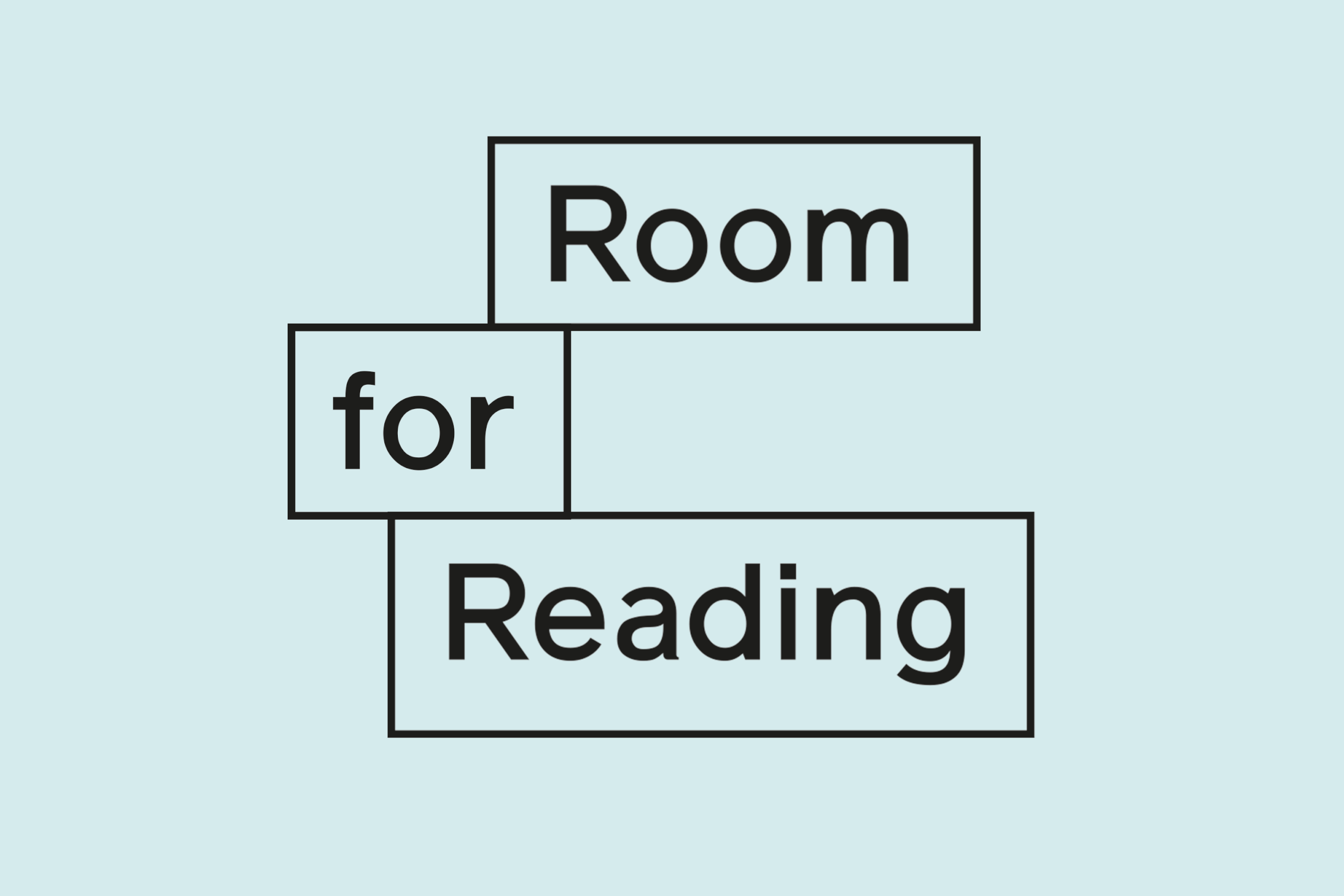
Room for Reading / Sean Edwards
Ahead of his commission as part of ‘anywhere in the universe’, our project looking at the present, past and future of the public library, Sean Edwards shares his recommendations for our Room for Reading.
Edwards selects ‘Index Cards’ by Moyra Davey (2020); ‘Acting Class’ by Drnaso (2020); ‘Libraries of Light’ by Alistair Black (2019); ‘Checkout 19’ (2021) by Claire-Louise Bennett and ‘Help for the Dyslexic Adolescent’ by E.G Stirling (1987).
Moyra Davey, ‘Index Cards’. (2020)
‘Index Cards’ (2020) by Moyra Davey
“I always return to Moyra Davey’s writing. Particularly her writing about reading. There is something about her style and approach that is akin to reading itself. She places the reader in the context of her own reading which in turn informs the text, taking the reader on a research narrative journey guided by her. Until this collection was published the writings were spread across numerous books and catalogues, but to have this collection in one place is like a small gift and one that is never far from my side.”
Listen to Moyra Davey on the Magic Hour podcast here.
Watch ‘Hemlock Forrest’ (2016) by Moyra Davey here.
Nick Drnaso, ‘Acting Class’. (2020)
‘Acting Class’ (2020) by Nick Drnaso
“Graphic Novels and picture books in general were my way into reading, and as a child of the 1980’s I mined the library for the small selections of ‘comics’ that they had in stock. Thankfully for young adults there are now far greater selections of these books at libraries. I still prefer to read images and Drnaso’s ‘Acting Class’ published last year is one that has remained with me. The sparse artwork and disorientating narrative arc about a group of strangers collected together through their attendance at an amateur acting class is both beautiful and deeply unsettling.”
Read an excerpt from Nick Drnaso’s ‘Acting Class’ here.
Alistair Black, ‘Librareis of Light: British Public Library Desig in the Long 1960s’. (2019)
‘Libraries of Light’ (2019) by Alistair Black
“Black’s book looks at the emergence of a new type of architectural design for British Public libraries in the 1960’s that broke with traditions and began to consider a new type of design. The book features a range of case studies, including Cardonald Library in Glasgow, to illustrate Black’s idea of ‘libraries of light’. Within the book, he proposes that the particular architectural design of these spaces convey the principles of a shared social egalitarianism.”
Read Alistair Black on the importance of public libraries in Apollo Magazine here.
Claire-Louise Bennett. ‘Checkout 19’.(2021)
‘Checkout 19’ (2021) by Claire-Louise Bennett
“This is a book about books, and about reading. It is also about the transformative power of books as objects. Bennett’s writing is recognisable to me in its the repetitions, loops and fragmentation. I think of her style as being immensely physical and object-like. The writing on the page carries gravity.”
Read an extract from ‘Checkout 19’ here.
E.G Stirling, ‘Help for the Dyslexic Adolescent’. (1987)
‘Help for the Dyslexic Adolescent’ (1987) by E.G Stirling
“I was diagnosed with dyslexia in the final year of my Masters. I found this book shortly after in a charity shop. It was first published in 1985 and the edition I own was reprinted in 1993 – the particular timespan when I would have, could have, needed it. Regardless, this absence has allowed it to be a tool ever since, one I mine regularly for work, thinking about reading, and looking. The techniques I self-developed to deal with dyslexia became a way to consider how the act of reading and looking can be used within my practice.”
Details
In conjunction with our projects, exhibitions and events, Room for Reading offers artists we work with an opportunity to contribute to The Common Guild library and share the books and resources that have influenced their artistic practice.
Every artist’s selection is added to The Common Guild’s expansive reference library of artist books, catalogues, and cultural and critical theory.
Related
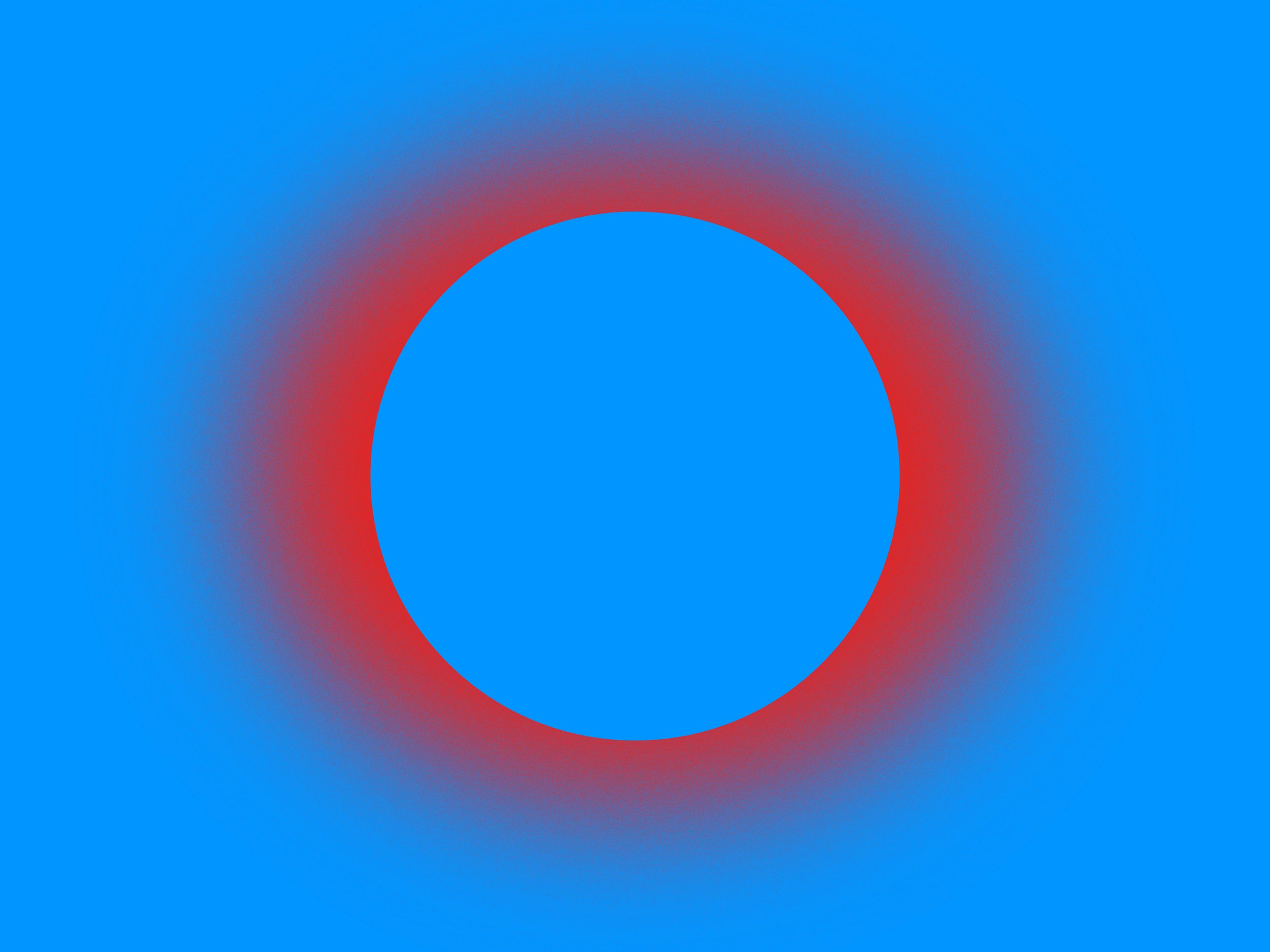
Onyeka Igwe – ‘The Last Librarian in Glasgow’
Design: Tom Joyes
Onyeka Igwe’s play for libraries is informed by socialist-realist participatory theatre and educational plays to think through ways meaning is made collectively and how we tend to look upon the institutions we interact with in everyday life.
‘The Last Librarian in Glasgow’ is a short play set in the near future. The play follows two individuals who join forces in an attempt to resurrect the now-lost tradition of the public lending library. Working through their own indistinct, hazy childhood memories, and instructions from a zine, they start to assemble what they think might be the essentials of a community library, in an old, empty warehouse building.
Onyeka Igwe, ‘The Last Librarian in Glasgow’, Hillhead Library, 2023. Courtesy of the artist. Photo: Alan Dimmick.
Through dialogue and interaction with their new library visitors, the characters work through the assumptions, ideologies and complications of institutional formation. In enacting their new roles as librarians and custodians of an organisation, they call into question the ways institutions have developed and the structures and systems we have inherited in our own public spaces. Through a process of trial and error, they propose ways in which things might be different, and in turn speculate what is needed in society now and in an unknown future.
‘The Last Librarian in Glasgow’ points towards cycles of knowledge loss and reformation, and explores what is valued, inherited and saved for public use. The play highlights how information is accessed and exchanged, as well as changing notions of the civic, and habits of sharing in present times.
Igwe’s play was accompanied by a short piece of writing by the writer and researcher Lola Olufemi. Olufemi’s writing was available from Hillhead Library, Langside Library and Woodside Library, for the duration of the project and is included in the publication ‘anywhere in the universe’, available to buy in our Shop..
Onyeka Igwe is an artist and researcher working between cinema and installation, living and working in London, UK. Her work is animated by the question “how do we live together?” with a particular interest in sensorial, spatial, and non-canonical ways of knowing. She uses embodiment, voice, archives, narration and text to create structural “figure-of-eights”, a format that exposes a multiplicity of narratives.
Solo exhibitions and commissions include ‘A Repertoire of Protest (No Dance, No Palaver)’, MoMA PS1, New York (2023) ; ‘The Miracle on George Green’, Highline, New York (2022); ‘a so-called archive’, LUX, London; ‘THE REAL STORY IS WHAT’S IN THAT ROOM’, Mercer Union, Toronto, Canada, (both 2021), ‘There Were Two Brothers’, Jerwood Arts, (2019), and ‘Corrections’ with Aliya Pabani, Trinity Square Video, Toronto, Canada (2018).
In 2022 Igwe was nominated for the Jarman Award and shortlisted for the Max Mara Art Prize for Women 2022–2024. She was awarded the 2021 Foundwork Artist Prize; the 2020 Arts Foundation Futures Award for Experimental Short Film; and was the 2019 recipient of the Berwick New Cinema Award in 2019.
Lola Olufemi is a black feminist writer and Stuart Hall foundation researcher from London based in the Centre for Research and Education in Art and Media at the University of Westminster. Her work focuses on the uses of the feminist imagination and its relationship to cultural production, political demands and futurity. She is author of ‘Feminism Interrupted: Disrupting Power’ (Pluto Press, 2020), ‘Experiments in Imagining Otherwise’ (Hajar Press, 2021) and a member of 'bare minimum', an interdisciplinary anti-work arts collective.
About the Libraries
Located in Battlefield in the southside of Glasgow, Langside Library was opened in 1915, the last of the Carnegie libraries to be built in the city. Built on the principle of open access, the library was designed by architect George Simpson. The library features a mural of the Battle of Langside, which was painted by staff and students at the Glasgow School of Art and completed in 1921.
One of the largest Carnegie libraries in Glasgow, Woodside Library was designed by J R Rhind and opened in 1905. A large, glazed dome on the roof is a distinctive feature, and sculpture on the front of the building is attributed to William Kellock Brown. After a refurbishment, the library reopened in 2022, and is now home to a flexible community space, new study areas and a colourful woodland-themed children’s area stocked with books chosen by pupils from local primary schools.
The most used branch library in Glasgow, Hillhead Library has been a fixture of Glasgow’s West End since opening in 1975. The building was designed in Modernist architectural style by architects Rogerson & Spence, and the library’s interior open plan arrangement with spiral staircases represents a shift towards fully open access libraries.
Project Details
‘The Last Librarian in Glasgow’ was performed in Langside Library, Woodside Library and Hillhead Library across three days.
Performed by Elicia Daly, Pauline Goldsmith and Louis Pearson.
It is now available as an audio play - listen below.
Listen to ‘The Last Librarian in Glasgow’ –
Thanks
With thanks to staff at Glasgow Life.
Onyeka Igwe would like to thank Gordon Douglas; David Allan; Elly Goodman and Neil Packham at the Citizens Theatre; the Citizens Theatre Community Collective Group; February Workshop participants; and the Red Sunday School.
Thanks to the performers, Elicia Daly, Pauline Goldsmith and Louis Pearson, and to Chizu Anucha for the sound mix.
Related

Room for Reading / Kate Davis
Kate Davis shares her recommendations for our Room for Reading, ahead of her forthcoming commission as part of ‘anywhere in the universe’.
Davis has recommended Deborah Levy’s Living Autobiography Trilogy (2014–2021), Ruth Todasco’s 1970’s Feminist English Dictionary, and a lecture by artist Amy Sillman. Read more on Davis’ recommendations and their relationship to the development of her new work, below.
Deborah Levy, ‘Things I Don’t Want to Know’ (2014); ‘The Cost of Living’ (2018); ‘Real Estate’ (2021).
Deborah Levy, ‘Things I Don’t Want to Know’ (2014), ‘The Cost of Living’ (2018) and ‘Real Estate’ (2021).
“On the back of my copy of ‘Things I Don’t Want to Know’ there is a quote from Levy: ‘Even the most arrogant female writer has to work overtime to build an ego that is robust enough to get her through January, never mind all the way to December”. Levy’s questioning of how to pursue a creative self alongside everyday life is a key theme in this trilogy. It helped get me through the period before, during and after the pandemic and ‘Real Estate’ provided a direction for my ‘anywhere in the universe’ project.”
Listen to ‘The Cost of Living: Deborah Levy and Olivia Laing’, London Review Bookshop Podcast, April 2018 here.
Ruth Todasco,‘An Intelligent Woman's Guide to Dirty Words: Volume One of the Feminist English Dictionary’ (1973).
‘An Intelligent Woman's Guide to Dirty Words: Volume One of the Feminist English Dictionary’ (1973) by Ruth Todasco.
“I discovered this excellently-titled publication when doing research for ‘anywhere in the universe’. It was made by a group of women in Chicago and has a bold urgency that seems characteristic of much of the feminist activity being generated in America in the early 1970s. The ‘dirty words’ of the title are ‘english words and phrases reflecting sexist attitudes toward women in patriarchal society, arranged according to usage and idea’– and many of these derogatory terms are still so familiar.”
Read ‘Feminists Find That Words Fail Them’, a New York Times review of ‘An Intelligent Woman's Guide to Dirty Words’, January 1974, here.
‘Conversation with Amy Sillman: Drawing in the Continuous Present, The Menil Collection’ (2017).
This generous lecture fizzes with Sillman’s intelligent curiosity and humour. Drawing is key to my practice and I am often questioning what certain forms of mark-making mean today. I appreciate how Sillman manages to both critique and embrace such a wide range of approaches to drawing. I am also grateful to Sillman for introducing me to Manny Farber’s ‘Termite art’ and its articulation of ‘a bug like immersion in what is close to hand’. I am regularly seeking that sort of immersion in the studio.
Watch Amy Sillman’s lecture ‘Drawing in the Continuous Present’, The Menil Collection, February 2017, above.
Details
In conjunction with our projects, exhibitions and events, Room for Reading offers artists we work with an opportunity to contribute to The Common Guild library and share the books and resources that have influenced their artistic practice.
Every artist’s selection is added to The Common Guild’s expansive reference library of artist books, catalogues, and cultural and critical theory.
Related

Moving in Relation 3. Louise Amoore interviewed by Corin Sworn
Corin Sworn & Claricia Parinussa, 'eco-co-location' (2021). Photo: George Hampton Wale.
The third instalment in Corin Sworn's research series 'Moving in relation' takes the form of a conversation between Corin Sworn and political philosopher Louise Amoore, now available to listen online.
Louise Amoore is author of 'Cloud Ethics: Algorithms and the Attributes of Ourselves and Others' (2020) and lecturer at Durham University whose research has informed Sworn’s current investigative performance practice.
Sworn and Amoore discuss understanding algorithms, AI ethics, and the intimacy that connects together human and algorithmic relations. With reference to Sworn’s performances ‘eco-co-location’ and ‘This Harmonic Chamber’ they consider what place these technologies occupy in the world.
Touching on different histories of science and the prioritisation of rationality over embodied knowledge, algorithms are understood as an arrangement of propositions which are often used to model likelihood. Algorithms shape and are shaped by their porous engagement with the world; they participate in generative algorithm-to-algorithm relationships and demonstrate fallibility through enacting logics of misrecognition or ‘algorithmic madness’. Sworn and Amoore’s conversation reflects on the ways algorithms inform our everyday perception and impact how we interact with one another from an interpersonal to a judicial level.
Event Details
Listen –
With thanks to Louise Amoore.
Sound Editing: Corin Sworn
Additional Sound Editing: Duncan Marquiss
Related

Basel Abbas and Ruanne Abou-Rahme – ‘May amnesia never kiss us on the mouth’
Basel Abbas and Ruanne Abou-Rahme, ‘May amnesia never kiss us on the mouth: Only sounds that tremble through us’(2020–2022). Installation view, The Common Guild, 2022. Photo: Isobel Lutz-Smith.
‘May amnesia never kiss us on the mouth’ (2020-ongoing) by the New York and Ramallah-based artists Basel Abbas and Ruanne Abou-Rahme is an evolving multipart project featuring sound, moving-image installation and live performance.
The project foregrounds Abbas and Abou-Rahme’s remarkable personal archive of found video clips and ephemeral recorded footage, collected by the artists since the early 2010s and the beginning of the Arab Revolutions. Posted online and on social media by ordinary people living in and around Palestine, Iraq and Syria, the video clips, often ad hoc and recorded on mobile devices, focus on song, dance, protest and performance – affirmative acts of vocalisation and physical gesture.
Basel Abbas and Ruanne Abou-Rahme, ‘May amnesia never kiss us on the mouth: Only sounds that tremble through us’(2020–2022). Installation view, The Common Guild, 2022. Photo: Isobel Lutz-Smith.
This collected material forms the foundation of Abbas and Abou-Rahme’s multi-layered installation 'Only sounds that tremble through us' (2022). The digital traces of these performing bodies are brought together with new performances created by the artists with dancer Rima Baransi and musicians Haykal, Julmud, and Makimakkuk, working in Ramallah, Palestine. Footage is looped, manipulated and superimposed upon images that include solarised landscapes and destroyed dwellings. Projections are rhythmic and augmented with a fragmentary script in both Arabic and English, detailing experiences of violence, trauma, displacement and resistance. The sound, composed by the artists, shifts between the solo voice, singing dirge-like, and a reverberating audio, heavy with bass notes. As sound and moving image accumulates, a testimony of shared experience begins to emerge, and in turn a collective body of knowledge.
Basel Abbas and Ruanne Abou-Rahme, ‘May amnesia never kiss us on the mouth: Only sounds that tremble through us’(2020–2022). Installation view, The Common Guild, 2022. Photo: Isobel Lutz-Smith.
‘May amnesia never kiss us on the mouth’ bears witness to geopolitical upheavals, forced migration and community disintegration whilst simultaneously enacting modes of survival for those marginalised by colonial-capitalist conditions – reclaiming space for alternative political logics to persist. The project’s overarching title, ‘May amnesia never kiss us on the mouth’ is borrowed from the English translation of Chilean writer Roberto Bolaño’s ‘Infrarealist Manifesto’ (1976), used here by Abbas and Abou-Rahme as a reminder to resist forgetfulness and the erasure of personal, political and community histories that disappear all too quickly from consciousness.
Abbas and Abou-Rahme will activate the installation with the live performance ‘an echo buried, buried, but calling still’ (2022). Drawing upon further sound, video, and text from the artist’s larger archive and combining this with live vocals, electronics, sound sampling and projections. This new work examines the significance of voice and embodiment through song as a testimony to the resilience of communities under threat.
This is the most substantial presentation of the work of Abbas and Abou-Rahme in the UK to date. The project has been commissioned by the Museum of Modern Art and the DIA Art Foundation, New York City, and presented at Migros Museum für Gegenwartskunst, Zurich.
Basel Abbas (b. Nicosia, Cyprus, 1983) and Ruanne Abou-Rahme (b. Boston, USA, 1983) have had solo exhibitions at, among others, the Art Institute of Chicago (2021); Kunstverein in Hamburg (2018); Art Jameel Project Space Dubai (2017); Alt Bomontiada, Istanbul (2017); and Carroll / Fletcher, London (2016).
Their work has been included in major international biennials such as the 12th Sharjah Biennial (2015), the 10th Gwangju Biennale, the 31st São Paulo Biennial (both 2014), the 13th Istanbul Biennial (2013), and the 53rd Venice Biennale (2009). They are currently participating in the 12th Berlin Biennale (2022).
Project Details
‘May amnesia never kiss us on the mouth: Only sounds that tremble through us’ (2020–2022) was presented at 5 Florence Street from the 9 September to 9 October 2022. The exhibition was open Thursday – Sunday, 12–6pm and free to enter.
Read the Commentary by Priya Jay –
Listen to Priya Jay read the Commentary here –
Location –
Related
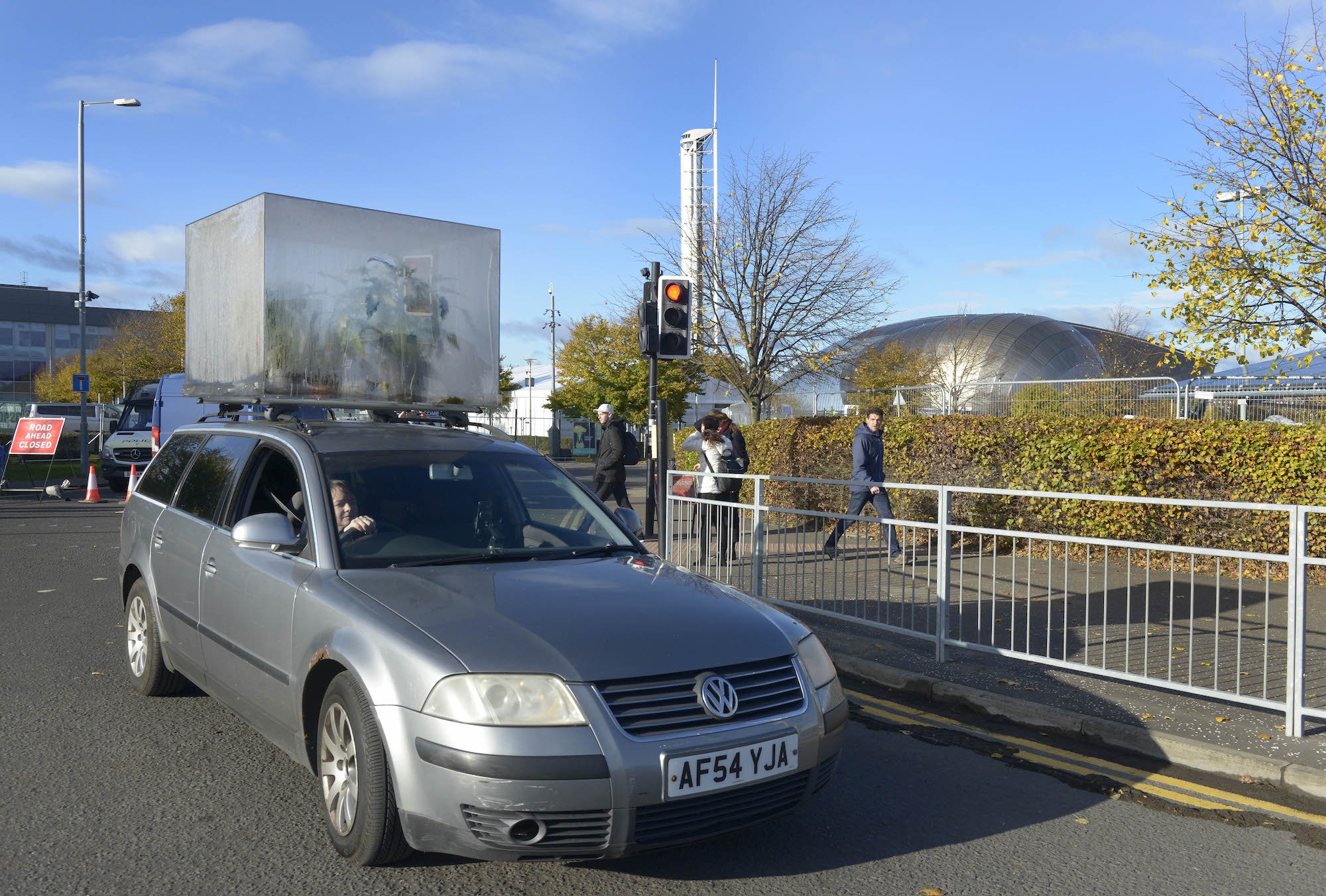
Discussion / 'The Art of Gustav Metzger and Climate Activism'
Gustav Metzger, ‘Mobbile’ (1970/2021). Courtesy the Gustav Metzger Foundation. Photo: Alan Dimmick.
'The Art of Gustav Metzger and Climate Activism' marks the end of Mobbile’s journeying around Glasgow with an informal discussion about the work of Gustav Metzger, his call for us to ‘Remember Nature’, and the relationship between art and activism.
The discussion includes contributions from artist and writer Ross Birrell, Ula Dajerling, Co-director of the Gustav Metzger Foundation, and artist and co-director of Sculpture Placement Group, Kate V Robertson.
Introduced by Dominic Paterson of the University of Glasgow.
Photo: Alan Dimmick.
About ‘Mobbile’
As the United Nations Climate Change Conference (COP26) takes place in Glasgow, The Common Guild is re-presenting Gustav Metzger’s sculpture, ‘Mobbile’, a modified car that collects and stores its own carbon emissions, originally made in 1970 to demonstrate the destructive and harmful effects of manmade pollutants on the natural world.
Gustav Metzger was a visionary artist and radical thinker. Born in Nuremberg, Germany on 10 April 1926 to Polish-Jewish parents, Metzger came to the UK in 1939 as a refugee. He dedicated his entire creative practice to social activism and challenging our perception of public art as a vehicle for change.
At the heart of his practice, which spanned over 65 years, are a series of constantly opposing yet interdependent forces such as destruction and creation. Metzger’s involvement in anti-nuclear movements such as the Committee of 100 and his life-long activism to combat environmental destruction was fundamental to his provocative questioning of the role of artist and of conventional forms of artmaking and display. His auto-destructive art, meant as a public art form that would instigate social change, sought to provide a mirror of a social and political system that he felt was indifferently progressing towards total obliteration. He also sought to place the emphasis on action over creation of the art object, inviting viewers to interact with some of his work to heighten their impact.
The artist’s legacy is profoundly rooted in activism in both the political and artistic realms. Metzger envisaged art as a means of communicating the futility and horrors of conflict and war. By 1958, Metzger had become heavily involved in anti-capitalist, anti-consumerist movements and the Campaign for Nuclear Disarmament. In 1960, he was a founder member of the Committee of 100 and this led to a short imprisonment in 1961 with Bertrand Russell and other members of the Committee for encouraging mass non-violent civil disobedience.
Event Details
Listen to the discussion -
Related

Sharon Hayes – 'Ricerche'
Sharon Hayes, 'Ricerche: two' (2020) Film still, Pictured: Courtnei “Luckey” Townson.
Courtesy of the artist and Tanya Leighton, Berlin and Los Angeles.
American artist Sharon Hayes’ new project with The Common Guild is a suite of three films, shown together for the first time. It is the continuation of Hayes’ on-going ‘Ricerche’ project, including a new commission. ‘Ricerche’ (meaning ‘research’) is comprised of several video works that use the 1964 film ‘Comizi d’Amore’ (Love Meetings) by Italian director, Pier Paolo Pasolini, as a guidepost and framework for an examination of gender, sexuality and contemporary collective identifications.
‘Ricerche’ constitutes an inquiry into the relations between sex, sexuality, gender and politics in the United States today, with nonetheless striking resonance with contemporary discourse across societies elsewhere. It continues Hayes investigation of the act of public speech, and its intersections with history, politics, activism, queer theory, love and sexuality, through both the collective and the individual voice.
Filmed by Hayes at different times since 2013, including during 2020’s critical election year in the US, the works feature a range of individuals, from students at an all-women’s college in Massachusetts, to children of queer or gender non-conforming parents, and members of two women’s tackle football teams. Each film is presented as ‘ricerche’ or research. The most recent, ‘Ricerche: two’, was filmed in Dallas/Fort Worth, Texas, just before the onset of the pandemic. It was commissioned by The Common Guild. The extended interview asks the players what they like about the sport, whether they feel different on and off the field and how playing football relates to other aspects of their lives. This new work will be presented alongside the two existing works in the series; the single-channel video ‘Ricerche: three’ (2013), and a diptych, ‘Ricerche: one’ (2019).
Sharon Hayes, ‘Ricerche: two’ (2020). Installation view, The Common Guild at the former Adelphi Terrace Public School, Glasgow. Photo: Isobel Lutz-Smith.
‘Ricerche’ is presented in the former Adelphi Terrace Public School, south of the river Clyde, opposite Glasgow Green. Originally opened in 1894 following the Education (Scotland) Act of 1872, which made schooling free and compulsory for five to thirteen year olds, the building was used as a site of education for children and young adults until 2010. With thanks to our venue partner Urban Office.
Sharon Hayes (b. 1970, Baltimore, Maryland, USA) lives and works in Philadelphia, USA.
Hayes is one of the most influential politically and socially committed artists working in the United States. She has been the subject of retrospectives at the Whitney Museum of American Art, New York; Museo Nacional Centro de Arte Reina Sofía, Madrid; and Moderna Museet, Stockholm. Hayes’ work is part of the public collections of Tate, London; Museum of Modern Art, New York; Solomon R. Guggenheim Museum, New York; Whitney Museum of American Art, New York; Dallas Museum of Art; San Francisco Museum of Modern Art; Kunstmuseum St. Gallen; Museum of Modern Art Warsaw, Warsaw; among many others. Hayes’ 5-channel video installation 'In My Little Corner of the World, Anyone Would Love You’ (2016) was co-commissioned by The Common Guild and Studio Voltaire, London.
Sharon Hayes holds the position of Professor of Fine Arts at the University of Pennsylvania.
Further Info
With thanks to Tanya Leighton, Berlin and Los Angeles.
Documents
E-flux Announcement – Sharon Hayes: ‘Ricerche’
Sharon Hayes interviewed by Adam Benmaklouf, The Skinny, October 2021
Related
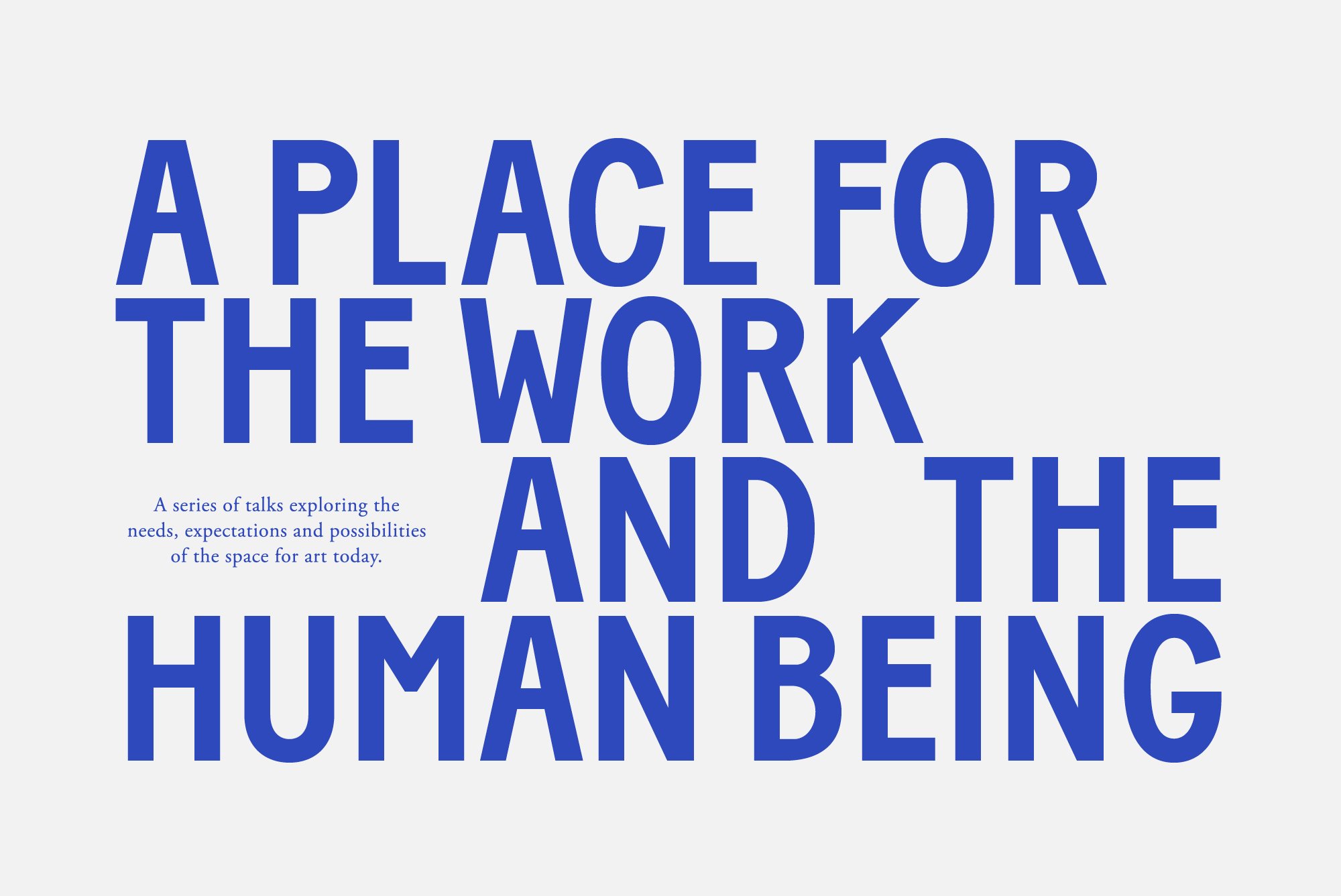
10. Panel Discussion led by Tom Jeffreys followed by Dinner – 'A Place for the Work and the Human Being'
Design: A Practice For Everyday Life.
‘A Place for the Work and the Human Being’ concludes with the tenth and final event in the series, reflecting on a year of talks and discussions with artists, architects, curators and academics throughout 2019.
Writer Tom Jeffreys leads a conversation between artist Ruth Ewan; writer and Transmission Committee member, Colm Guo-Lin Peare; Ed Hollis, Professor of Interior Design at Edinburgh College of Art; and Director of The Common Guild, Katrina Brown. The discussion reflects on the histories, themes and ideas presented by earlier speakers, drawing upon propositions from Rémy Zaugg’s seminal 1986 text, ‘The Art Museum of My Dreams’, the central catalyst for this series of talks.
After the discussion Civic House Kitchen will serve a delicious, plant-based meal.
Tom Jeffreys is an Edinburgh-based writer, who is especially interested in art that engages with environmental questions. His writing has been published in numerous magazines, newspapers and websites, and he frequently writes essays for exhibition publications. Jeffreys is editor of the online arts magazine, ‘The Learned Pig’, and he runs the Edinburgh branch of ‘The Political Animal’ monthly reading group. He is the author of ‘Signal Failure: London to Birmingham, HS2 on Foot’ (Influx Press, 2017) and is now working on a new book about the birch tree in Russian art, landscape and identity.
Jeffreys has been commissioned to write a reflection on the ‘A Place for the Work and the Human Being’ series, which will be published in spring 2020.
Ruth Ewan is an artist based in Glasgow. Her work stems from context-specific research resulting in a wide variety of forms including events, performance, writing, installation and print. For some time, Ewan’s practice has extended beyond making artworks and exhibitions. She has worked with collaborators to create music projects, guided walks, radio programmes, design projects, education workshops and books. These build on Ewan’s long-term interests in creativity and social justice, alternative systems and radical histories.
She has previously exhibited at venues including Yorkshire Sculpture Park, CAPC Bordeaux, Victoria and Albert Museum, Camden Arts Centre, Tate Britain, Collective Gallery Edinburgh, Kunsthal Charlottenborg Copenhagen, Badischer Kunstverein Karlsruhe, Dundee Contemporary Arts, CAAC Seville, the ICA London and Studio Voltaire. Her work was included in the São Paulo Biennial (2016); Glasgow International (2012); Folkestone Triennial (2011); New Museum Triennial, New York and Tate Triennial, London (2009). She has created public commissions for High Line, New York (2019), Edinburgh Art Festival, Edinburgh (2018) and Artangel, London (2013 and 2007). Her work is included in the collections of Tate, The Scottish Parliament, Museum of Modern Art Warsaw, FRAC Champagne-Ardenne and CAAC Seville.
Colm Guo-Lin Peare currently sits on the committee of Transmission Gallery, Glasgow. Peare recently contributed to the Reorganising Cultural Institutions conference at BALTIC Centre for Contemporary Art, Gateshead and is the Writer-in-Residence at the 2019 Berwick Film and Media Arts Festival. Peare’s paper, ‘Recapturing Difference: The Assimilative Desire of Late Liberalism and the Errantry of Joy’, was awarded the Honour for Excellence in the Field of Critical Theory by the Fine Art Critical Studies selection panel at the Glasgow School of Art in 2019.
Ed Hollis is a recovering architect. He started his career practicing in Sri Lanka, and then in Edinburgh. In 1999, he began lecturing in Interior Architecture at Napier University, moving to Edinburgh College of Art in 2004, where he is now Professor of Interior Design and Deputy Dean of Research, College of Arts, Humanities, Social Sciences, University of Edinburgh.
Hollis has published three books including, a collection of folk tales and stories about mythical buildings, ‘The Secret Lives of Buildings: From the Ruins of the Parthenon to the Vegas Strip in Thirteen Stories’ (2009); ‘The Memory Palace: A Book of Lost Interiors’ (2013); and most recently ‘How to Make a Home’ (2016), published for the School of Life.
He has been involved in diverse projects using storytelling to help develop new uses for old buildings from St Peter’s Seminary at Cardross to Riddles Court, the oldest house in Edinburgh, and Asansol, an Indian city built by Scots engineers in the nineteenth century.
Civic House is a workspace, venue and canteen that supports creative learning and socially engaged approaches to city making. Located in Speirs Locks, north Glasgow, Civic House provides space and a public programme that stimulates ideas for a positive future for the city. Built in the 1920s for ‘Civic Press LTD’ – a print works that specialised in publishing posters and pamphlets for unions and political movements – the building was acquired in 2016 by Agile City, a community interest company, with the support of Scottish Government’s Regeneration Capital Grant Fund.
Related

9. Jeremy Shaw – 'A Place for the Work and the Human Being'
Design: A Practice for Everyday Life.
'A Place for the Work and the Human Being' runs throughout 2019 and takes place in a range of venues, new and old, around Glasgow. The series explores the needs, expectations and possibilities of the space for art today and speakers include artists, architects, curators and others.
For the ninth event in the series artist Jeremy Shaw presents a screening of 'Liminals' (2017) followed by a Q&A.
Photo: Alan Dimmick.
Jeremy Shaw works in a variety of media to explore altered states and the cultural and scientific practices that aspire to map transcendental experience. His works create a post-documentary space in which disparate belief systems and histories are thrown into an interpretive limbo.
Recent solo exhibitions include: ‘Quantification Trilogy', Kunstverein in Hamburg and ‘Liminals’, Musee des beaux-arts de Montreal. Jeremy participated in the 57th Venice Biennale (2017) and will have a solo exhibition at the Centre Pompidou in 2020.
Glasgow Film Theatre is an independent cinema that opened more than 40 years ago, taking over the historic Cosmo Cinema’s Rose Street premises. The Cosmo opened in 1939 as the UK’s first purpose built art-house cinema outside of London and was initiated by Scotland’s first film association, The Film Society of Glasgow in order to present cinema as a form of art and entertainment that could contribute to the cultural vigour of the city’s democratic and social life. Today GFT is the most diverse and best publicly attended independent cinema in Scotland and remains a treasured institution.
Event Details
Listen to Jeremy Shaw –
Further Info
Related

8. Elvira Dyangani Ose – 'A Place for the Work and the Human Being'
Design: A Practice for Everyday Life.
'A Place for the Work and the Human Being' runs throughout 2019 and takes place in a range of venues, new and old, around Glasgow. The series explores the needs, expectations and possibilities of the space for art today and speakers include artists, architects, curators and others.
For event number eight in the series we are delighted to present Elvira Dyangani Ose.
Elvira Dyangani Ose is Director of The Showroom, London. She is currently affiliated to the Department of Visual Cultures at Goldsmiths, the Thought Council at the Fondazione Prada and Tate Modern Advisory Council. Until November 2018, she served as Creative Time Senior Curator, where she most recently curated the 11th edition of their Summit. Previously, she curated Laura Lima’s 'Horse Takes King', the last iteration of the four-part project, ' Slight Agitation' at the Fondazione Prada, where since 2015 she has curated exhibitions such as Theaster Gates’s ' True Value', and ' Betye Saar: Uneasy Dancer'.
The Pearce Institute is one of Govan’s most significant historic buildings. Designed by Sir Rowand Anderson and completed in 1906, the Institute was gifted to the working men and women of Govan by Lady Pearce in memory of her late husband, the shipbuilder Sir William Pearce.
The Institute served the local community with reading rooms, a gymnasium and educational activities and continues to support the people of Govan through work with community groups and social organisations.
Project Details
Listen to Elvira Dyangani Ose –
Related
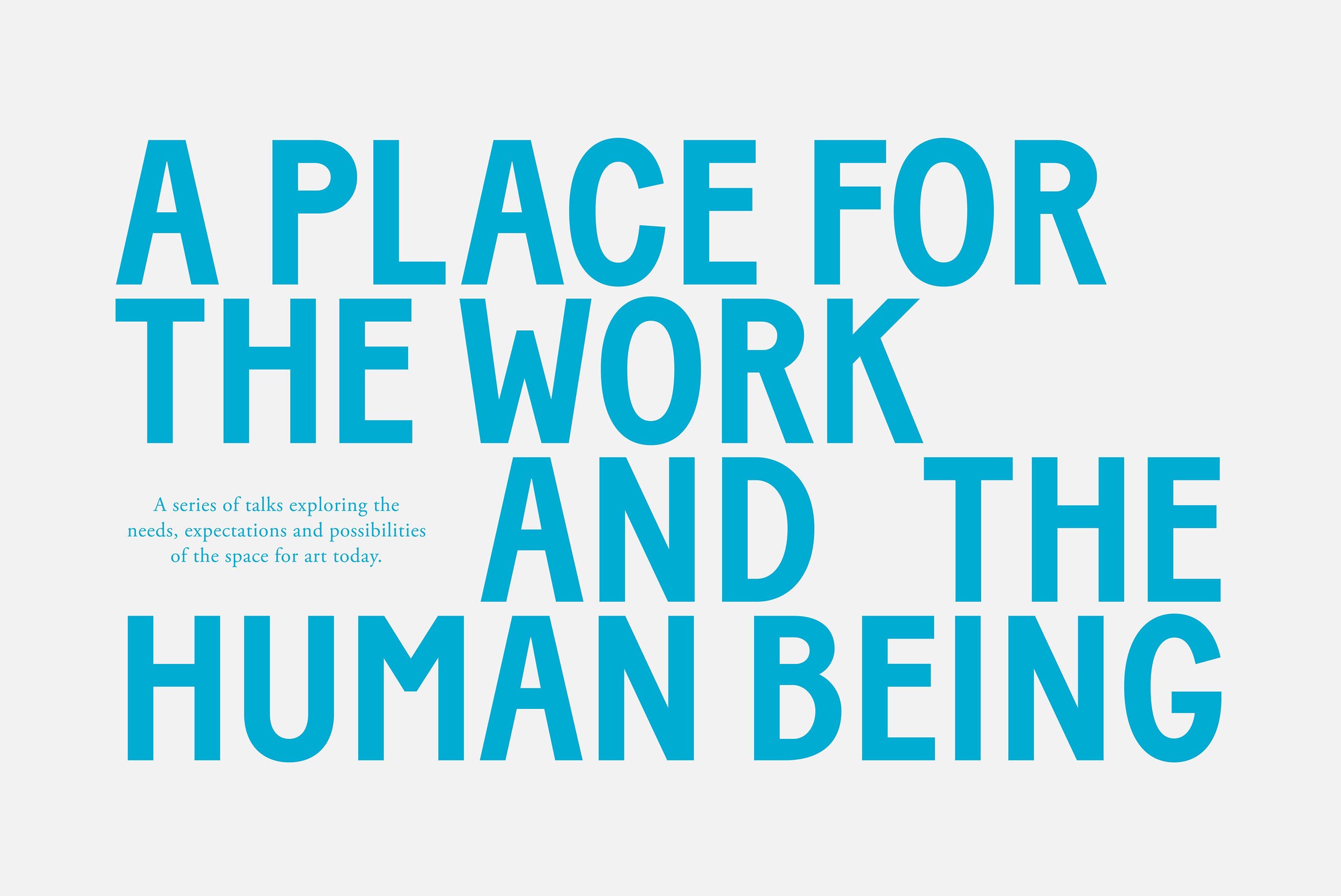
6. Jude Barber – 'A Place for the Work and the Human Being'
Design: A Practice for Everyday Life.
'A Place for the Work and the Human Being' runs throughout 2019 and takes place in a range of venues, new and old, around Glasgow. The series explores the needs, expectations and possibilities of the space for art today and speakers include artists, architects, curators and others.
For our sixth talk in the series, we were delighted to present the Glasgow-based architect, Jude Barber.
Photo: Alan Dimmick
Jude Barber is a director at Collective Architecture. The 48-strong, employee-owned and controlled studio is founded on principles of creative freedom, equity and sustainability. In 2018 Collective Architecture was named 2018 AJ Architect of the Year. Together, the team has delivered several key civic and cultural projects around the UK including the new home for Collective, Edinburgh, at the City Observatory on Calton Hill, which was awarded a RIBA National Award 2019.
Langside Halls were designed by John Gibson in 1847. It was originally the National Bank of Scotland in Queen Street, but the buidling was dismantled and moved brick by brick to its present location in 1902.
Project Details
Listen to Jude Barber –
Related

5. Jamie Fobert – 'A Place for the Work and the Human Being'
Design: A Practice for Everyday Life.
'A Place for the Work and the Human Being' runs throughout 2019 and takes place in a range of venues, new and old, around Glasgow. The series explores the needs, expectations and possibilities of the space for art today and speakers include artists, architects, curators and others.
Photo: Alan Dimmick.
Jamie Fobert is a London-based architect and designer, recently announced as winner of the BD Architect of the Year Gold Award 2019. Since establishing Jamie Fobert Architects in 1996, he has consistently produced innovative and inspiring architecture in projects ranging from individual houses to high quality retail and significant public buildings for the arts. During this time, the practice has won a number of major public commissions for cultural organisations including the new Tate St Ives, which opened to great public acclaim in October 2017, extensions to Kettle’s Yard Gallery and Charleston House, both of which opened to the public last year and most recently, The National Portrait Gallery.
Mackintosh Queens Cross is one of Glasgow's hidden architectural gems. Built in 1898, it is the only church designed by Charles Rennie Mackintosh.
Project Details
Listen to Jamie Fobert –
Related

4. Dorothea von Hantelmann – 'A Place for the Work and the Human Being'
Design: A Practice for Everyday Life.
'A Place for the Work and the Human Being' runs throughout 2019 and takes place in a range of venues, new and old, around Glasgow. The series explores the needs, expectations and possibilities of the space for art today and speakers include artists, architects, curators and others.
Photo: Alan Dimmick
Dorothea von Hantelmann is Professor of Art and Society at Bard College Berlin. Her main fields of research are contemporary art and theory as well as the history and theory of exhibitions. Among her publications are 'How to Do Things with Art' (JRP|Editions, 2010) and 'Notes on the Exhibition' (Hatje Cantz, 2012).
City of Glasgow College City Campus was designed by Reiach & Hall and Michael Laird Architects. The building opened in 2016 and was awarded the RIBA Award for Scotland 2017 and RIBA National Award 2017. It was shortlisted for the RIBA Stirling Prize 2017.
Project Details
Listen to Dorothea von Hantelmann –
Related

3. Stefan Kalmár – 'A Place for the Work and the Human Being'
Design: A Practice for Everyday Life.
'A Place for the Work and the Human Being’ runs throughout 2019 and takes place in a range of venues, new and old, around Glasgow. The series explores the needs, expectations and possibilities of the space for art today and speakers include artists, architects, curators and others.
Photo: Alan Dimmick
Stefan Kalmár joined the Institute of Contemporary Arts, London, as Director in January 2017 and is part of the artistic team for Manifesta 13 Marseille 2020. He was previously Executive Director & Curator at Artists Space, New York; Director of Kunstverein München; Director of the Institute of Visual Culture, Cambridge; and Artistic Director at Cubitt Gallery, London.
Trades Hall of Glasgow was designed by Robert Adam in 1791–1794. The medieval cathedral aside, Trades Hall is the oldest building in Glasgow still in regular use for its original purpose.
Project Details
Listen to Stefan Kalmàr
Further Info
Additional Links
Room for Reading / Stefan Kalmàr
Institute of Contemporary Arts, London
Manifesta 13 Marseille 2020
Related

2. Stephanie Macdonald – 'A Place for the Work and the Human Being'
Design: A Practice for Everyday Life.
'A Place for the Work and the Human Being’ runs throughout 2019 and takes place in a range of venues, new and old, around Glasgow. The series explores the needs, expectations and possibilities of the space for art today and speakers include artists, architects, curators and others.
The title is borrowed from the sub-title of a text by Swiss artist Rémy Zaugg (1943 – 2005), ‘The Art Museum of My Dreams’, written in 1986, translated into English in 2013 and now out of print.
MK Gallery, Milton Keynes, designed by 6a architects (2019).
Stephanie Macdonald co-founded 6a architects. with Tom Emerson in 2001. She has developed the practice’s collaboration with artists, designers, scientists and manufacturers in building projects encompassing exhibitions, products and furniture alongside these. Stephanie talks about 6a’s recent projects, which include South London Gallery Fire Station and Milton Keynes Gallery, which opens later this month.
The Merchants House of Glasgow is one of the oldest and most important bodies in the City of Glasgow. Its current premises, on the corner of George Square and West George Street, was designed by John Burnet and completed in 1877.
Project Details
Listen to Stephanie Macdonald –
Related

1. Nicole Wermers – 'A Place for the Work and the Human Being'
Design: A Practice for Everyday Life.
'A Place for the Work and the Human Being’ runs throughout 2019 and takes place in a range of venues, new and old, around Glasgow. The series explores the needs, expectations and possibilities of the space for art today and speakers include artists, architects, curators and others.
The title is borrowed from the subtitle of a text by Swiss artist Rémy Zaugg (1943 – 2005), ‘The Art Museum of My Dreams’, written in 1986, translated into English in 2013 and now out of print.
Nicole Wermers, ‘Women Between Buildings’ (2018). Installation view, Kunstverein in Hamburg.
Nicole Wermers talks about her recent work and her comprehensive solo show, ‘Women Between Buildings’, which took place at Kunstverein in Hamburg in 2018. Nicole was shortlisted for the Turner Prize 2015 and her work was shown at Tramway, Glasgow. She is currently a professor of sculpture, ceramics and glass at Akademie der Bildenden Künste in Munich.
The Humanities Lecture Theatre is the University of Glasgow’s only lecture theatre that remains largely unchanged since its construction in 1870, maintaining its original Victorian amphitheatre layout, wood panelling and 17th century benches from the University's original campus on High Street.
Project Details
Listen to Nicole Wermers –
Related
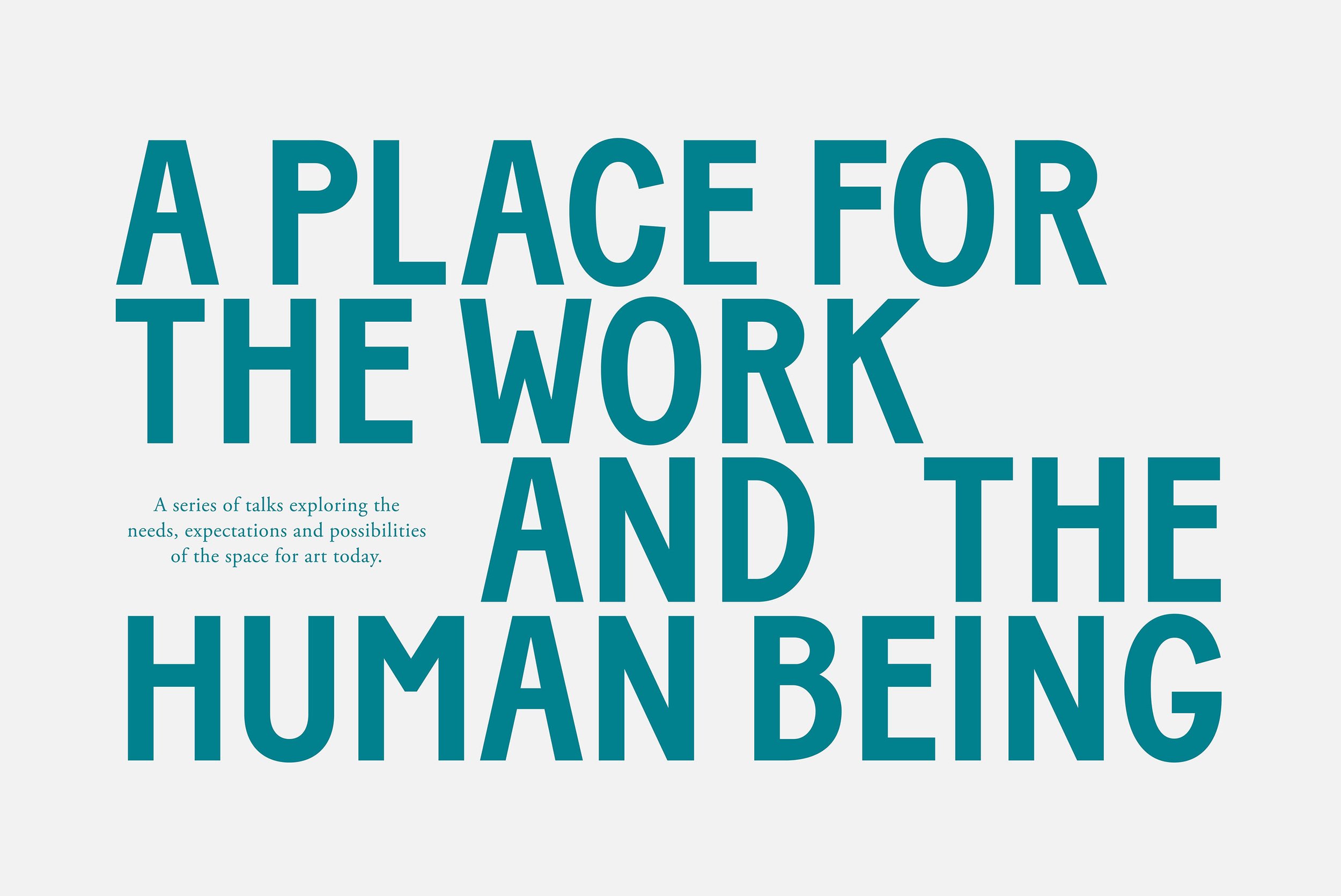
'A Place for the Work and the Human Being'
Design: A Practice for Everyday Life.
'A Place for the Work and the Human Being’ runs throughout 2019 and takes place in a range of venues, new and old, around Glasgow. The series explores the needs, expectations and possibilities of the space for art today and speakers include artists, architects, curators and others.
Photos: Alan Dimmick
The title is borrowed from the sub-title of a text by Swiss artist Rémy Zaugg (1943 – 2005), ‘The Art Museum of My Dreams’, written in 1986, translated into English in 2013 and now out of print.
Conceived to run in parallel with our transition, having drawn our exhibition programme at 21 Woodlands Terrace to a close after 10 years and 30 exhibitions, the series takes place while we develop plans for projects and exhibitions in new locations.
Related

Dialecty – ‘Sometimes Here Has No Walls’
A special launch event for the 'Dialecty' chapbooks series. 'Dialecty', conceived by Maria Fusco and co-published by Book Works and The Common Guild, considers the uses of vernacular forms to explore how dialect words, grammar and syntax challenge and improve traditional orthodoxies of critical writing.
The event included live readings by the contributors: Harry Josephine Giles & Martin O’Leary, Robert Herbert McClean, Helen Nisbet, Lisa Robertson, Adam Pendleton, Natasha Soobramanien & Luke Williams.
Project Details
Listen to selected Dialecty Readings –
Related

Exhibition Talk / Minty Donald on Janice Kerbel
Janice Kerbel, ‘Sink’ (2018). Photo: Alan Dimmick.
Minty Donald, Artist and Professor of Contemporary Performance Practice at the University of Glasgow, discusses Janice Kerbel’s synchronised swimming performance ‘Sink' (2018).
Minty considers ‘Sink’ in relation to artists’ documentation of live performance through performance scores and reconstructions.
Event Details
Listen to Minty Donald –
Related

Publication Launch / 'Radio Piombino'
We are celebrating the launch of Katinka Bock's publication 'Radio Piombino', designed by Åbäke, with our neighbours the Goethe Institut, Glasgow. The evening includes a conversation between Katinka Bock and Kitty Anderson, Curator at The Common Guild, and an opportunity to purchase the new publication.
The 16-page publication includes an essay by Anne Bonnin, an art critic and exhibition curator based in Paris, alongside a selection of production photographs taken by the artist as well as installation images of her exhibition 'Radio Piombino', at The Common Guild earlier this year.
Event Details
The book launch took place at the Goethe Institute Glasgow.
Related

Exhibition Talk / Moira Jeffrey on Katinka Bock
Katinka Bock, ‘Radio Piombino’ (2018). Installation view, The Common Guild. Photo: Ruth Clark.
Moira Jeffrey responds to Katinka Bock's exhibition, ‘Radio Piombino’.
Moira Jeffrey is a writer based in Glasgow. Her published works include short fiction, criticism and commissioned essays on artists including Alice Neel, Monika Sosnowska and Esther Shalev-Gerz. Most recently she has contributed to new monographs on artists Carol Rhodes and Jacqueline Donachie and the documentary photographer Alan Dimmick.
Event Details
Listen to Moira Jeffrey on Katinka Bock here –
Related
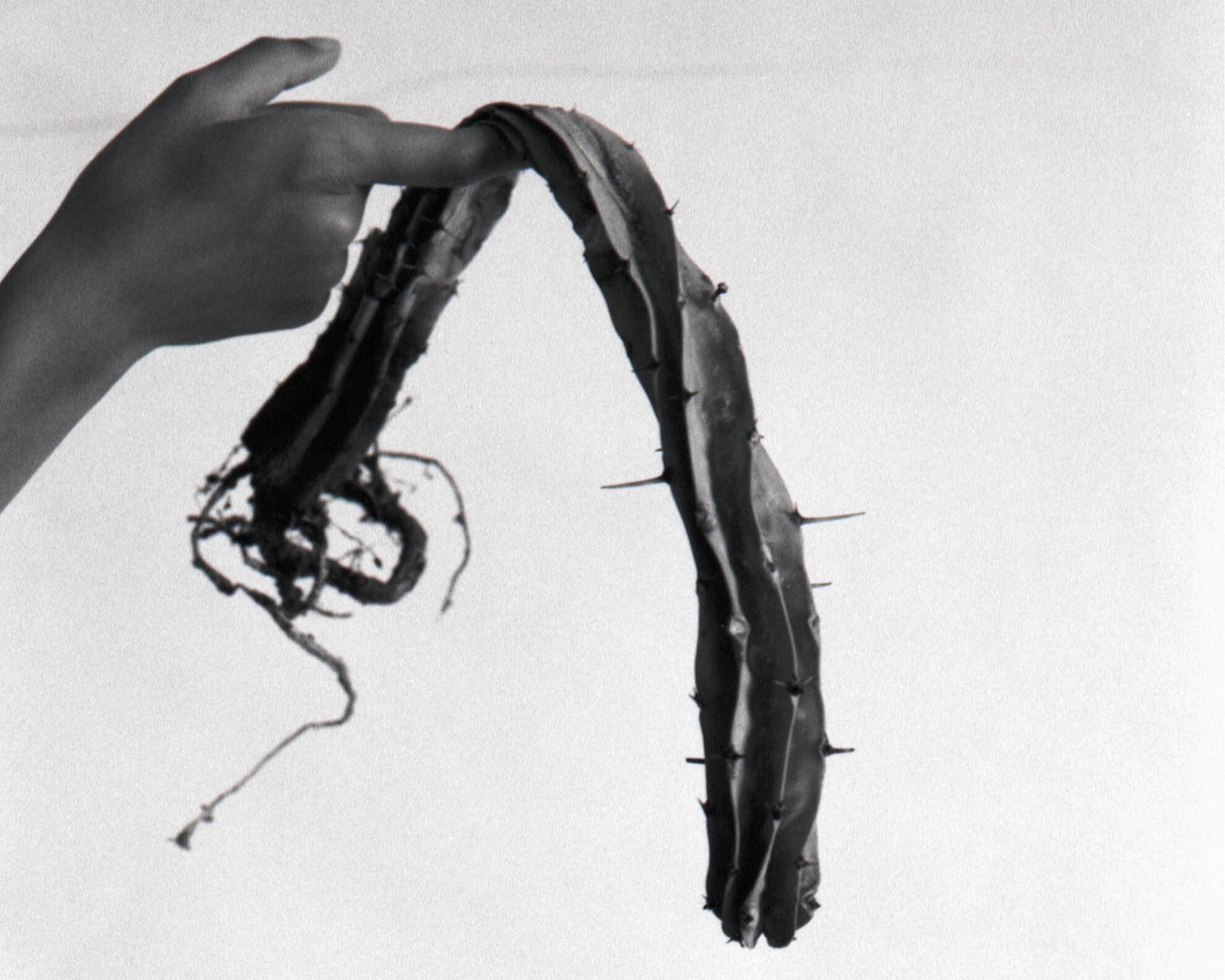
Katinka Bock – 'Radio Piombino'
Katinka Bock, ‘Dead Cactus’ (2016). Courtesy Galerie Jocelyn Wolff and Galerie Greta Meert.
‘Radio Piombino’ is an exhibition of new, sculptural works by artist Katinka Bock. Bock works with a range of materials, including natural substances, such as copper, lead and clay, and found or given forms. Her materials are often altered through natural processes and the effects of time – heat, moisture or sunlight, for example – such that the potential of becoming or disintegrating seems constantly present. Her sculptures appear as the result of events, at times seeming precarious and at others immutable.
Bock often takes the peculiarities or context of a given space as a starting point for her work, and her project for Glasgow taps into the nature of 21 Woodlands Terrace as a domestic building and the history of Glasgow as a major port, a place of exchange and transaction. Prior to the exhibition several parts of these works inhabited the city of Glasgow and its environs. Copper oxidised; fabric was exposed to the elements; ceramic forms ‘lived’ with city-centre residents and businesses, or were secreted in the woods above Loch Lomond. Bock gathers these elements in their transformed state, looping the references of geological, industrial, meteorological and personal history into her working materials, seeking to reflect the systems that produced the materials, place and people. 'Radio Piombino’ re-imagines 21 Woodlands Terrace as a landscape of sculptural elements that turn the building into what Bock terms a "poisoned body”.
Katinka Bock, 'Radio Piombino' installation view, The Common Guild, 2018. Photo: Ruth Clark.
Katinka Bock is a Paris-based, German artist. ‘Radio Piombino’ is the first presentation of her work in Scotland and follows her only previous project in the UK, ‘Mesonya’, with Siobhan Davies Dance (London) in 2017.
The exhibition is presented as part of Glasgow International 2018 and follows our previous Glasgow International exhibitions with leading international artists including Gabriel Kuri (2014) and Akram Zaatari (2016) and will be accompanied by a series of related talks and events.
Related

Exhibition Talk / Chris Fite-Wassilak on 'Slow Objects'
Vanessa Billy, ‘Refresh, Refresh (Mould Squeeze)’ (2016). Photo: Ruth Clark.
Writer, art critic and curator Chris Fite-Wassilak offers his thoughts on ‘Slow Objects’ and the work of Vanessa Billy, Edith Dekyndt and Erin Shirreff.
Chris Fite-Wassilak is a regular contributor to Frieze, Art Review, Art Monthly and Art Papers and has written about Vanessa Billy’s work for Frieze. His short book of essays ‘Ha-Ha Crystal’ is published by Copy Press.
Event Details
Listen to Chris Fite-Wassilak –
Related

Maria Fusco presents Dr Scott Hames
The third event for Maria Fusco's project 'Dialecty’ is a talk by Dr Scott Hames, Lecturer in Scottish Literature at Stirling University.
Hames is interested in ‘vernacular’ writing and cultural politics, especially in modern Scotland. His talk explores aesthetic possibilities for dialect which run counter to the romantic and realist paradigms that usually govern our perception of non-standard language.
'Dialecty' is a new project conceived by writer Maria Fusco considering the critical uses of vernacular forms of speaking and writing. The project explores the occurrences and potential uses of dialect words, syntax and language within the field of contemporary art and question traditional orthodoxies of creative and critical writing within contemporary art.
Events with Lisa Robertson, Dr Lauren Hall-Lew and Scott Hames took place in 2017 and a series of chapbooks with writing by Harry Josephine Giles & Martin O’Leary, Robert McClean, Helen Nisbet, Lisa Robertson, Adam Pendleton and Natasha Soobramanien & Luke Williams have been co-published by Book Works and The Common Guild, as part of Co-series.
Further Info
The Dialecty chapbooks series is available from Bookworks
Event Details
Listen to Dr Scott Hames –
Related

Talk / Tiffany Jenkins – ‘Who Owns Culture?’
Tiffany Jenkins is author of the critically acclaimed 'Keeping Their Marbles: How Treasures of the Past Ended Up in Museums and Why They Should Stay There' and regularly writes for The Scotsman, The Guardian, The Spectator and The Independent.
Her talk takes us through the history of debates over cultural ownership, cultural appropriation, and explains why no one culture owns culture.
Event Details
Listen to Tiffany Jenkins –
Related

Exhibition Talk / Martin Clark on Steven Claydon
Steven Claydon, ‘Double Jeopardy – Twin Studies’, (2017). Laminated MDF, shredded money, resin, painted resin, gold-plated blister packs, LED lights. Photo: Ruth Clark.
Martin Clark, currently Director of Bergen Kunsthall, Norway, and newly announced Director of Camden Arts Centre talks about Steven Claydon’s exhibition as well as previous projects Clark and Claydon have worked on together.
These included a large-scale group exhibition 'The Noing Uv It', co-curated with Claydon in 2015 and drawing its title from the 1980 Russell Hoban novel, 'Riddley Walker'; and a new video and sound commission, 'Infra-idol Assembly', that Claydon produced for last year's Art Sheffield 2016, for which Clark was Artistic Director.


